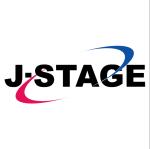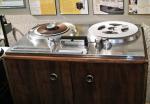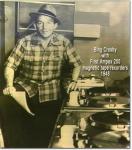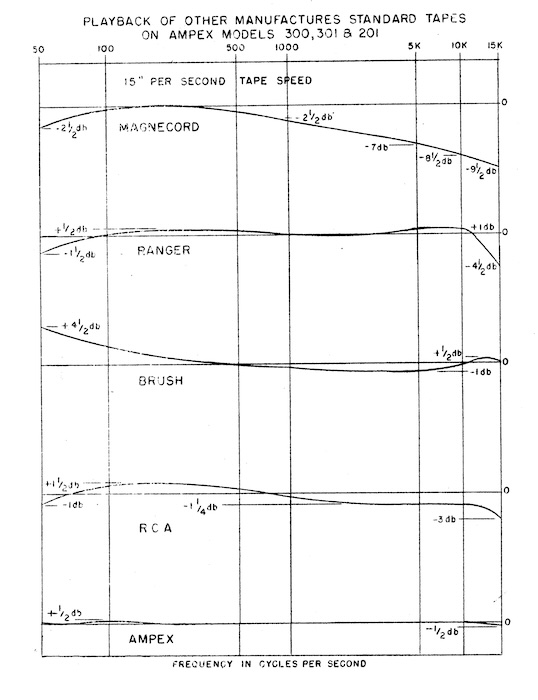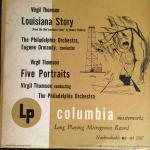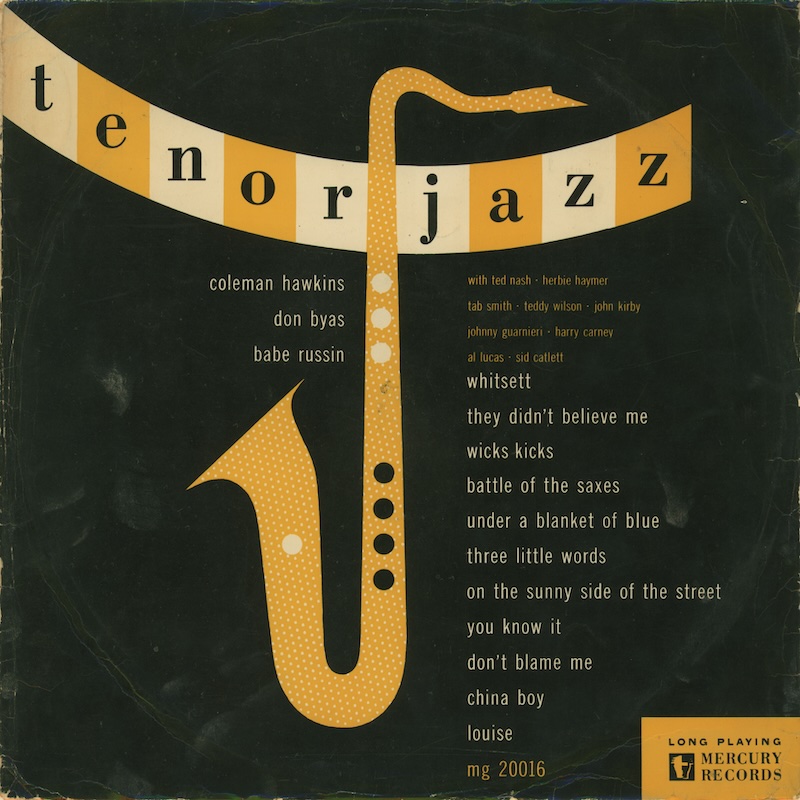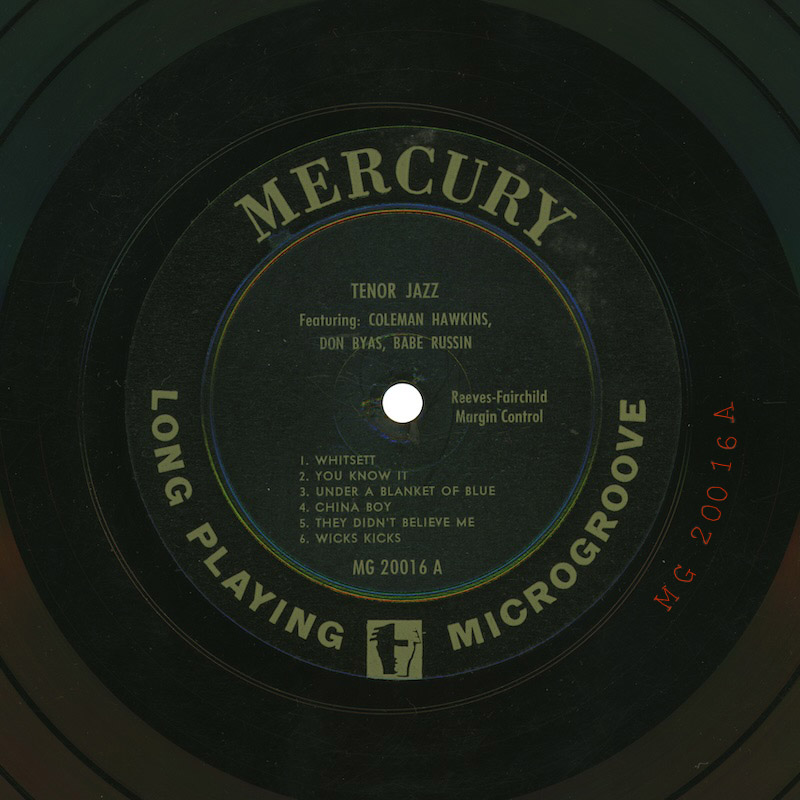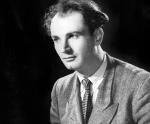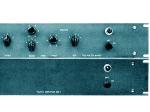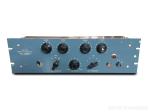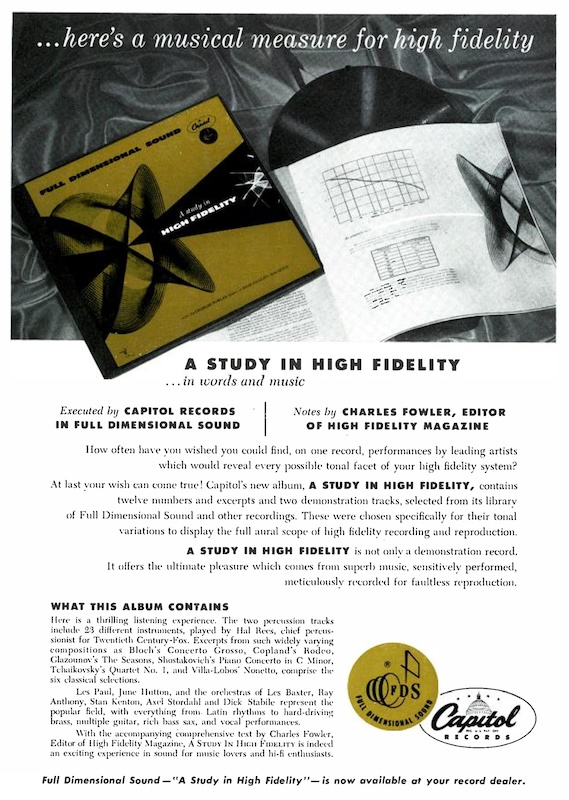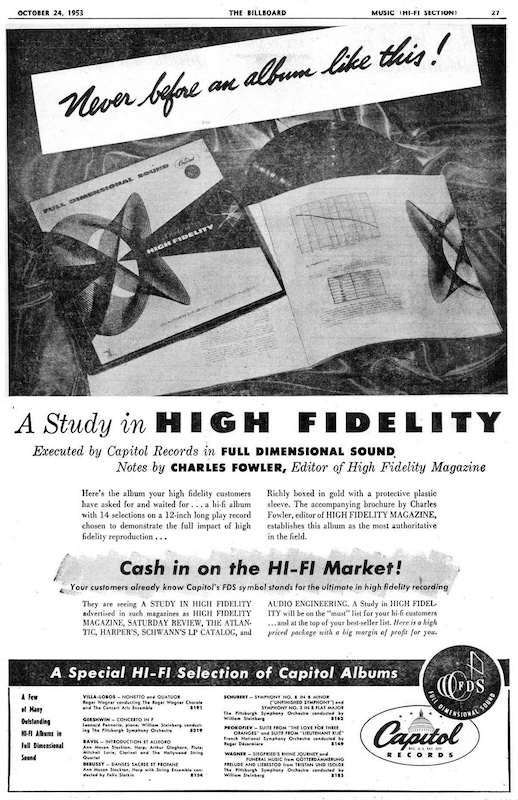EQカーブの歴史、ディスク録音の歴史を学ぶ本シリーズ。前回 Pt.16 では、第二次世界大戦勃発に端を発した物資不足から「サファイア・グループ」という業界エンジニア交流コミュニティが生まれ、企業秘密による競争から業界をあげての情報公開・技術標準化への動きがうまれたことを学びました。
On the previous part 16, I learned on the history of the “Sapphire Club” aka “Sapphire Group”, that was formed during the WWII because of the shortage of industry materials, and led the standardization in the industry, from the competition with trade secrets to the open collaborations, especially among the engineers.
同時に、その「サファイア・グループ」をきっかけとして、戦後の Audio Engineering 誌の発刊、およびオーディオ工学専門学会 Audio Engineering Society の誕生に繋がった流れを学びました。最後に、初の統一再生カーブである「AES 標準再生カーブ」について詳細を学びました。
At the same time, I learned the foundation of the Audio Engineering magazine as well as the Audio Engineering Soeicty, as a result of collaboration through the Sapphire Group. Then I learned the details of the “AES Standard Playback Curve”, the first advocated standard characteristic for commercial records.
調査に手間取るなどして少し間があいてしまいましたが、今回の Pt.17 では、LP黎明期〜AES標準再生カーブ発表の1951年1月〜統一前夜(最終的に米国各業界内で統一がなされる 1953 NARTB / 1954 改訂 AES / 1954 RIAA 策定の直前)、までの状況を調べていきます。めちゃくちゃ長い記事になってしまいました(笑)
This time as Pt. 17, after a few months of absence (due to the continuous research etc.), I am going to continue learning the history of disc recording, especially during the period: from the advent of LP records, publication of the AES curve in Jan. 1951, to the eve of the industry standardization (formations of 1953 NARTB / 1954 new AES / 1954 RIAA). Please note, this part is going to be an extraordinarily lengthy article 🙂

“About This Recording…” section of Mercury MG-50000 (1951), recommending AES playback curve.
Mercury MG-50000 (1951) の裏ジャケより。AES 再生カーブが指定されている。
毎回書いている通り、筆者自身の学習過程を記したものですので、間違いの指摘や異論は遠慮なくお寄せください。
As I noted in every part of my article, this is a series of the footsteps of my own learning process, so please let me know if you find any mistakes on my article(s) / if you have different opinions.
いつも相当長い文章ですが、今回は特に長くなってしまいました(笑)ので、さきに要約を掲載します。同じ内容は最後の まとめ にも掲載しています。
Again, this article become very lengthy — much longer than usual? — so here is the summary of this article beforehand (the same summary are avilable also in the the summary subsection).
LPや45回転盤などマイクログルーヴ盤の登場直後は、ヴァイナル組成もプレス技術も発展途上であり、新品であってもスクラッチノイズが入るなど品質に問題があった。また、当初は78回転盤アルバム音源の盤起こしによるLPイシューがほとんどであった。
In very early years of microgroove records (LPs and 45 rpms), both vinyl resin composition and pressing technology were still developing; even new records had scratch noise. Also, almost all LPs of such early years were reissues and compilations of 78 rpm albums.
マイクログルーヴ盤登場時期と、スタジオへの磁気テープ装置導入が一気に進む時期が奇跡的に一致していたことから、スタジオにおける長時間レコード制作時の自由度が飛躍的に向上した。また、1950年代前半になると、Pultec EQP-1/1A に代表される汎用可変イコライザが一気に普及し、リミッタ、コンプレッサ、ローパスフィルタ、ハイパスフィルタ、エコーチェンバ、プレートリヴァーブと相まって、ディスク録音EQとは独立して自由に音作りができる環境が整っていった。
It was a coincidence that the advent of microgroove records and the diffusion of magnetic tape recorders came out almost simultaneously. Both contributed the freedom of making longer playing records. Also in the early 1950s, variable (program) equalizers like Pultec EQP-1/1A became instantly popular among the studios, as well as limiters, compressors, low-pass/high-pass filters, echo-chambers and plate reverb, all of which gave studio engineers the freedom of sound-making as they wished, independent from disc recording EQ curves.
ディスクマスタリング(カッティング)時に用いられる録音EQは、ほとんどのスタジオにおいては、当時は固定回路のパッシブLRC EQ が用いられるのが慣例だった(現在は固定回路のアクティブ RC EQ が主流)。可変イコライザをディスク録音 EQ として使用する例もごく一部認められるものの、例外的なものであったと考えられる。
そもそも、大手レーベルでは社内で規格や技術プラクティスが厳格に定められていたため、エンジニアの気まぐれで記録特性を変更することは許されなかった。また、ほとんどの独立系スタジオにおいては、コストの問題から固定ユニットによる単一記録特性が選択されていたと思われる。一方、Peter Bartók のように、2〜3種類の録音カーブをレーベルごとに意図的に使い分けてマスタリングしたと思われる例外的な事例も見受けられた。
Disc recording equalizers which were used for mastering (cutting) lacquers at that time were almost always fixed LRC passive EQ units in most studios, although there was a very rare exception of using variable equalizers as disc recording equalizers.
More importantly, major labels had strict in-house standardization and engineering practices: recording engineers of such labels could not alter the recording equalizer with his/her passing fancy. Also, for many independent studios, it was highly probably an economical factor of choosing a single recording characteristics with a fixed EQ unit. On the other hand, we see there was an exceptional case, such that Peter Bartók intentionally used several recording characteristics depending on the labels.
High Fidelity 誌に掲載された一連の “Dialing Your Disks” のデータは、掲載開始直後は「想定している再生カーブをレーベルに直接問い合わせて回答された」ものを掲載していたが、徐々にカテゴライズや情報が錯綜し、結果として後年の混乱の一翼を担うこととなった。一方、当時のさまざまなLPのマトリクス情報をつつきあわせると、「レーベルごとの特性」というよりは「マスタリングスタジオごとの特性」という傾向がつかめる。その上で最初期の “Dialing Your Disks” データを眺めると、ある種の一貫性を感じ取ることができる。
A series of data on The High Fidelity Magazine’s “Dialing Your Disks” initally consisted of the responses directly from the labels, “which reproducing characteristics each label intended to be used”. However, as the issue went by, there was a confusion of information and categoraization — as a result, “Dialing Your Disks” would strenghen the controversy in later years. On the other hand, by checking and comparing the dead-wax matrix information of actual records, it is clear that the used EQ depends on which mastering studio was used, rather than from whcih label the record was released. With this prerequisite in mind, we see some consistency among the early “Dialing Your Disks” data.
当時ハイファイブームに乗ってマニア向けに販売されていた可変EQ付アンプのセレクタをみてみると、1953年7月に放送局向けに策定された NARTB 録音再生規格、1954年1月に発行された改訂 AES 再生カーブ、1954年2月に発表された RIAA 標準録音再生規格、それら全てがまだ存在していなかった時期(〜1953年後半)では、RCA (Old/New Orthophonic) ポジションを備えたものはほとんどなく、NAB (≒ Columbia LP) と AES をメインとしていることが分かる。なかにはマイクログルーヴ盤向けには AES のみという機種もあった。
そして、同じカーブ名のポジションであっても、アンプごとに実装が異なるため、必ずしも同じ再生カーブではなかったことも分かった。
改めて、各レーベルが当時 High Fidelity 誌の “Dialing Your Disks” に回答した「想定カーブ」は、当時流通していたアンプのどのEQポジションでの再生を推奨するか、であり、特定の録音カーブの使用を回答したのではなかったと考えられる。
Early 1950s was also a beginning of “Hi-Fi” fad: some consumer amplifiers for audio fanatics had variable / selectable phono compensator (reproducing characteristic switcher). It is interesting to know that many of early amplifiers (before the publications of Jul. 1953 NARTB Standards, Jan. 1954 new AES Playback Standards and Feb. 1954 RIAA Characteristic) only had “NAB (≒ Columbia LP)” and “AES” positions: few had “RCA” (new/old Orthophonic) positions. On some amplifiers, there was only one switch for reproducing microgroove records — “AES” only.
It was also found that even positions with the same EQ curve name did not necesssarily have the same playback curve due to different implementations in different amplifiers.
Once again, the “assumed curves” that each label responded to High Fidelity magazine’s “Dialing Your Disks” at the time were the recommended playback at whatever EQ position(s) on the amplifiers in circulation at that time, not the use of specific recording curve(s).
Contents / 目次
- 17.0 Before We Proceed
- 17.1 More About Early LPs
- 17.2 The Advent of Magnetic Tape Recorders
- 17.3 Reeves Sound Studios as of 1949 / Fine Sound Studios as of 1952
- 17.3.1 All the Mercury releases around 1949 were cut at the Reeves Sound Studios
- 17.3.2 Ormandy & Philadelphia Philharmonic at Reeves Sound Studios on May 10, 1949
- 17.3.3 Reeves Sound Studios in 1949 using the NAB curve for commercial records as well
- 17.3.4 Fairchild Unit 627 Variable Equalizer
- 17.3.5 Fine Sound Studios as of 1952
- 17.4 The Advent of Program (Variable) Equalizer
- 17.5 Before and After the 1951 AES Curve, Until the RIAA Curve
- 17.5.1 Columbia and its studios
- 17.5.2 RCA Victor and its studios
- 17.5.3 Capitol and its studios
- 17.5.4 Reeves Sound Studios (Mercury, etc.)
- 17.5.5 WOR Recording Studios and Blue Note (early LP years, before Van Gelder years)
- 17.5.6 Good Time Jazz / Contemporary label (early years)
- 17.5.7 Peter Bartók Studios and various labels
- 17.5.8 US Decca and London
- 17.6 Early list from “Dialing Your Disks”
- 17.7 Phono Amplifiers in the early 1950s (before RIAA)
- 17.7.1 Bell Sound Systems Model 2200
- 17.7.2 Fisher 50-C Master Audio Control
- 17.7.3 Newcomb Classic 25
- 17.7.4 Marantz Audio Consolette (1951)
- 17.7.5 Stromberg-Carlson AR-425
- 17.7.6 Pickering 230H + 132E / Model 410
- 17.7.7 H.H. Scott 120-A
- 17.7.8 General Electric A1-900 Record Compensator
- 17.7.9 Brook Model 22A
- 17.7.10 Some Thoughts (or Hypothesis)
- 17.8 The summary of what I got this time / 自分なりのまとめ
17.0 Before We Proceed
拙シリーズ記事を参考に各種SNSなどで論を展開される場合、第三者が確認できるように、該当する記事のURLなどを添えて参照していただけるとうれしいです。
私も自分自身が書くものについては、参考/引用/出典を全て(可能な限りリンク付きで)明らかにしているつもりです。リファレンスなき引用や参照は、元記事を書いた方や情報提供してくださった方に失礼であると考えますので。
参考にして頂けること自体は大変喜ばしいことで、ありがとうございます。
17.1 More About Early LPs
1948年6月〜に出されていた「米国における」最初期の LP について、もう少しその特徴をみていきましょう。
Here are some more of the characteristics of the “USA” LPs from the early years, issued from June 1948 and onward.
17.1.1 Inferior quality of early vinyl resin
本稿でも何度か引用している Susan Schmidt Horning 氏の書籍 “Chasing Sound: Technology, Culture, and the Art of Studio Recording from Edison to the LP” (2013, The John Hopkins University Press) に、こんな記述があります。1999年5月5日に Wilma Cozart Fine (1927-2009) に電話でインタビューした内容の引用です。
Susan Schmidt Horming’s book “Chasing Sound: Technology, Culture, and the Art of Studio Recording from Edison to the LP” (2013, The John Hopkins University Press), which I have cited several times in this entire series, has an interesting quote from a telephone interview with Wilma Cozart Fine (1927-2009) on May 5, 1999.
The microgroove LP, running at 33⅓ rpm, the same speed as electrical transcriptions, offered playing time on a single twelve-inch disc of up to nearly forty-five minutes using both sides, enabling an entire symphony to be available on one record. Pressed on Vinylite, a lighter and more flexible material than shellac, they were nonbreakable and virtually free of needle scratch, an unfortunate result of the filler in shellac which one recording engineer likened to “softened asphalt scraped up off the roads.
マイクログルーヴLPの回転数は放送局で使用されていたトランスクリプション盤と同一の33 1/3回転であった。これにより、1枚の12インチ盤に両面で約45分間の収録が可能となり、交響曲を1枚のレコードに収められるようになった。シェラックより軽量で柔軟な素材であるヴィニライトにプレスされたLPは、割れる心配もなかった。ある録音技師が「道路を削りとったアスファルトを柔らかくしたもの」と例えていた抗摩耗剤、それがシェラック盤には含まれていたが、LPはそのスクラッチノイズから解放されることとなった。
However, Mercury Living Presence record producer Wilma Cozart Fine, another pioneering woman in the male-dominated recording industry, recalled that some early vinyl was also inferior, and it took some time before high-quality vinyl was developed, which was particularly important for classical music.
しかし、男性に支配されたレコード業界におけるパイオニアたる女性のひとり、Mercury Living Presence のプロデューサ Wilma Cozart Fine 女史の回想によると、初期のヴァイナル盤の品質もあまり良くないものであったし、クラシック音楽レコードの製造に特に重要である高品質ヴァイナルが開発されるまでには数年を要した、とのことである。
“Chasing Sound: Technology, Culture, and the Art of Recording from Edison to the LP”, p.110, by Susan Scmidt Horning, The John Hopkins University Press, 2013.確かに、特に最初期(1948年〜1951年頃)の LP 盤の中には、Mercury に限らず、あまり柔軟性がなく硬質な素材だったり、見た目は無傷なのにスクラッチノイズが少なからず聴こえたりするものがあったりします。
Indeed, I find some LPs — especially from the early years (around 1948-1951) — are not very flexible and are made of harder materials, not only Mercury’s but also those from other labels. On some LPs scratch noise can be heard, although they look intact.
上記の電話インタビューで語られている話は、Mercury レーベルが所有していた当時のプレス工場に限った話なのかもしれません。
In a sense, the story told by Mrs. Wilma Cozart might be specific to the pressing plants around that time, owned by Mercury Records Corporation.
しかし、たまに入手する、黎明期(1948年〜1950年代前半)のLP盤の中には、確かに(現在のレベルと比べると)新品当時から品質が劣っていたのでは、と感じることが少なくありません。これは、保管状態の問題でもなく、もちろん再生EQカーブの問題ではなく、単純に当時のヴァイナル素材の組成に関する当時の技術や品質の問題、そしてプレス品質の問題だったものもある、ということでしょう。
On the other hand, I sometimes encounter LPs of various labels from the early years (1948 to early 1950s), which sound with many scratch noises even though they look like new — I believe they were poorly made. I guess it’s not because of poor storage conditions through the years; not bacause of the improper reproducing characteristics; but some quality issues of vinyl composition as well as poor pressing quality at that time.
西ドイツ盤や日本盤に比べると、盤質やプレス品質が平均して下回っている、と言われることもある(笑)米国盤ですが、もしかしたらLP登場直後からずっとそうだったのかもしれませんね。
I hear some people say that the quality of American record compositions (and the pressing quality of the U.S.) are inferior in general, to those from West Germany and Japan — not sure if it’s correct, but it might be true, even since the very early LP years.
さらに時代が進むと、米国では特に1960年代の45回転盤はLP製造時の端材だったり粗悪な品質のヴァイナルでプレスされているものが多かったことが知られています。これらは「大量生産の消耗品としてのレコード盤」という意識、言い換えると「コスト意識」がより強かった、経済大国アメリカ合衆国ならではなのかもしれませんね。
Also in the U.S., it is known that many 45 rpms (especially from the 1960s) were pressed with poor quality vinyl resins (and/or remnant of LP manufacture). It may be unique to the U.S., an economic powerhouse with a stronger awareness of “vinyl records as mass-produced consumables” — in other words, a stronger “cost-consciousness”.
ともあれ、LP最初期においては、ヴァイナル化合物組成や製造の技術も、マイクログルーヴによるカッティング機材や技術も、まだまだ黎明期であり、そこから数年でどんどん進化と品質向上を遂げていくことになるわけです。
Anyway, in the early-early LP era, everything was still under development — vinyl resin composition, microgroove cutting equipments and techniques, etc. Then within a few years, they would be greatly improved in quality.
たまたま見つけたものですが、高分子学会 の論文誌 1959年8巻7号 に、「人工高分子のレコード」という解説記事が掲載されています。著者は日本グラモフォンの柳本孝男氏で、1957年に京都大学で理学博士号を授与された方のようです。
I found an interesting technical article by chance: “Synthetic Polymer Records” (1959), published in the Vol. 8, No. 7, the Journal of The Polymer Science (Jpaan). The author is Takao Yanagimoto of Nippon Gramophone, who received the Doctor of Science at Kyoto University in 1957.
1959年、ちょうどステレオLPが登場した直後というタイミングでもあり、レコード材料の配合比率という観点から非常に興味深いデータが多く掲載されているほか、1950年代後半における日本、米国のレコード製造事情も垣間見られ、同時にヴァイナルレコードの基礎知識解説もある、簡潔にまとめられた非常に貴重な資料だと思います。
This article was written in 1959, just after the stereo records were introduced. It describes plenty of valuable information, from the viewpoint of vinyl record’s composition. It also is an overview of vinyl record production both in the US and in Japan as of 1959, as well as an outline of the fundamental technology of vinyl records.
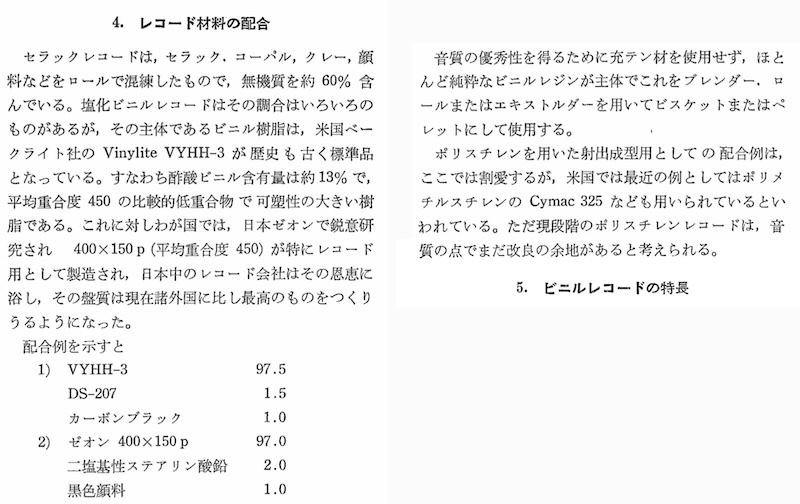
source: J-STAGE DOI https://doi.org/10.1295/kobunshi.8.364.
当時の米国では、ベークライト社の Vinylite VYHH-3 が、日本では、ゼオン 400×150p が、それぞれ広く使われていることが解説されている。同時に、ポリスチレン製レコードについても触れられている
This article explains the composition of the vinyl compound as of the middle-late 1950s: Bakelite Corporation’s Vinylite VYHH-3 widely used in the US, while Japan Zeon’s 400×150p used in Japan. Also there is a brief mention of polystyrene records.
17.1.2 Early LPs mostly from 78 rpm masters
最初期(1948〜1950)のLPに収録されていた音源のほとんどは、78 rpm アルバム音源の LP 化や、78 rpm シングル盤音源のコンピレーションでした。このLP黎明期は、磁気テープがスタジオに導入されだした時期と奇跡的に一致していますが、テープ導入前のごく最初期は、状態の良いシェラック盤、テストブレス盤、セーフティラッカー盤などからのダビングによって直接LPカッティングされていました。
Almost all of the sound sources on very early LPs (1948-1950) were 78 rpm albums or their compilations. The dawn of the LP miraculously coincided with the introduction of magnetic tapes into the studios. Before the introduction of magnetic tapes, LPs were cut directly by dubbing from good condition shellac records, vinyl test pressings, or safety lacquer recordings.
例えば、1948年6月18日にニューヨークのウォルドルフ・アストリアホテルで初お披露目され、間髪を入れずにリリースが開始された、 Columbia の世界初LPは101枚ありました(本稿 Pt.11 参照)。Peter Goldmark 氏のプレゼンで抱えていた101枚です。
For example, 101 LPs were initially released on June 18, 1948, when Coulumbia proudly presented the Long Playing Microgroove records for the first time (see: Pt. 11). In the press demonstration at Waldorf=Astoria Hotel, Peter Goldmark was holding the 101 LPs on stage.
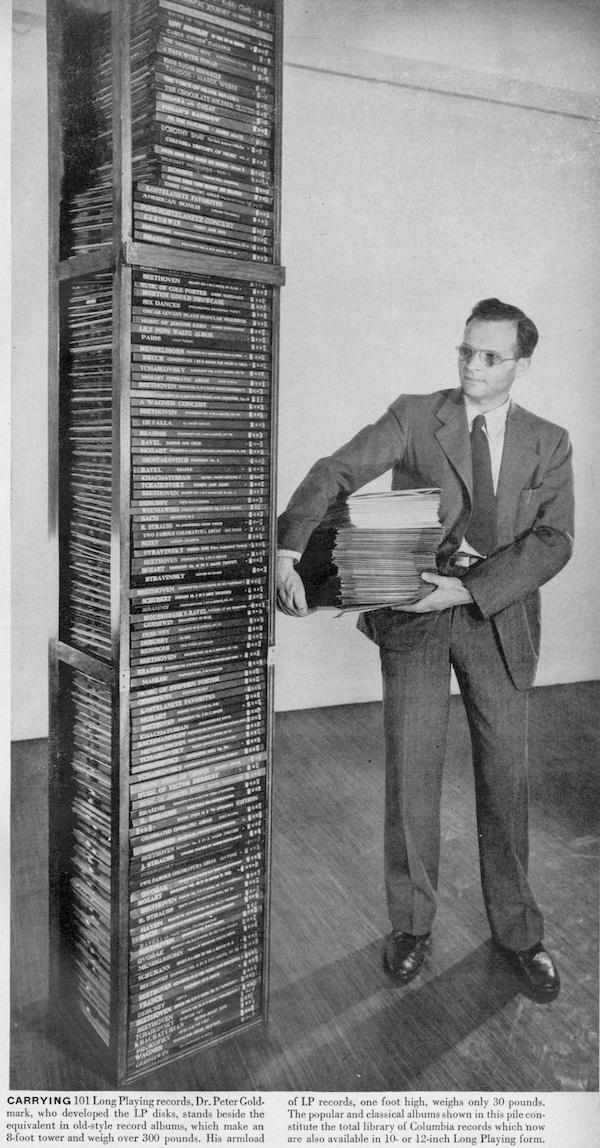
source: LIFE Magazine, July 26, 1948, p.39
この101枚のLPの一覧は、“History of Longplay” というサイトの記事 “Columbia’s Initial 101 LPs Catalog” にもまとめられています。
The list of these 101 LPs is summarized at the article “Columbia’s Initial 101 LPs Catalog” of the “History of Longplay” website.
12インチクラシックLPが58枚(ML-4001〜4057 および ML-4071)、10インチクラシックLPが12枚(ML-2001〜2012)、12インチライトクラシックが12枚(ML-4058〜4067、4069、4070)、10インチライトクラシックが8枚(ML-2013〜2020)、10インチポピュラーが11枚(CL-6001〜6011)、の以上101枚です。
The 101 LPs consists of: fifty-eight 12-inch Classical LPs (ML-4001 to ML-4057, and ML-4071); twelve 10-inch Classical LPs (ML-2001 to ML-2012); twelve 12-inch Light Classical LPs (ML-4058 to 4067, 4069 and 4070); eight 10-inch Light Classical LPs (ML-2013 to ML-2020); and eleven 10-inch Popular LPs (CL-6001 to CL-6011).
このリストは元々、The Billboard 1948年7月3日号 の 35ページ および 120ページ に “Columbia’s Initial LP Catalog” として掲載されたものです。
The list of the first 101 LPs was originally published in The Billboard, July 3, 1948 issue, p. 35 and p. 120, under the title of “Columbia’s Initial LP Catalog”.
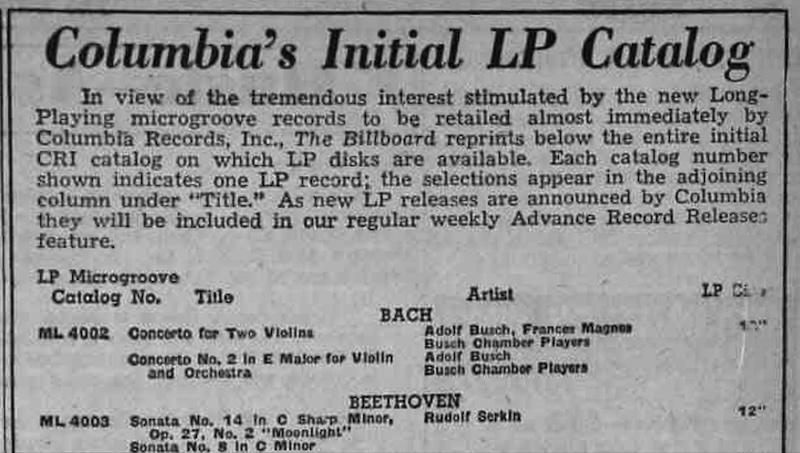
source: “Columbia’s Initial LP Catalog”, The Billboard, July 3, 1948, p.35.
Billboard 誌1948年7月3日号に掲載された、Columbia 最初の LP リリース101タイトルの一覧(の冒頭部分)
これら101枚のLPはすべて、78回転盤アルバム時代の音源のLP再発であり、Columbia が 1939年以降「将来に長時間レコードを出す時のために」録音し保管しておいた、16インチ 33 1/3 rpm のセーフティラッカーから直接マスタリングされています(この時に使われたダビングシステムは Columbia の Ike Rodman 氏によって特許 US2,426,241 となっています)。ちなみに 、Columbia が LP 制作時に磁気テープを使用し始めたのは早くとも1949年以降である、とされています。
All these 101 LPs were either the reissues of 78 rpm albums or the 78 rpm compilations. They were mastered directly from the 16-inch 33 1/3 rpm safety lacquers, which Columbia decided to record and keep since 1939. By the way, the transfer system from 16-inch safety lacquers to 12-inch lacquers was patented by Columbia’s Ike Rodman as US2,426,241. Also, it is known that Columbia introduced magnetic tape systems in the studio in 1949 at the earliest.
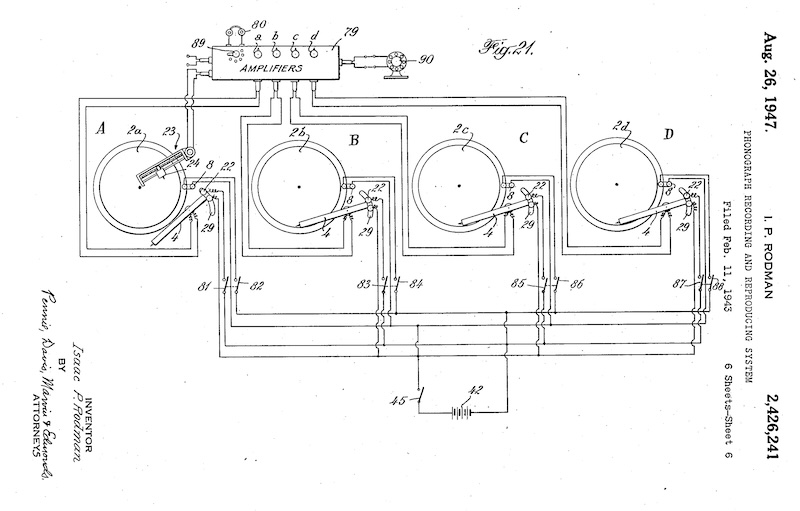
source: “US2,426,241A: Phonograph recording and reproducing system (Issac P. Rodman)”.
Columbia の Ike Rodman 氏によって出願された、複数枚のディスクから新たなブランクディスクに複製する装置の特許
一方、3大メジャーの残る2レーベル(RCA Victor と Decca)、およびその他ほとんどのレーベルは、当初 LP のリリースを行うにあたり、状態の良いシェラック78回転盤、テストプレスのヴァイナル78回転盤、(まんがいち残っていれば 78 rpm メタルマザー?)、などからの盤起こしにより、LP を制作していました。1948年〜1950年にスタジオに磁気テープ録音が次々導入されていき、新規録音はテープ録音・編集後カッティング、旧譜はテープにトランスファーしたのち編集してカッティング、となっていきます。
Other labels, including the remaining majors (RCA Victor and Decca), used shellac 78 rpms in good condition and vinyl test pressings (78 rpm metal mothers would possibly used if existed? not sure) for LP mastering. As magnetic tape recorders gradually introduced into the studios during 1948 to 1950, new recordings were recorded on tapes, edited on tapes, then mastered onto lacquer discs; old recordings (78 rpms) were transfered to tapes, edited on tapes, then mastered onto lacquers.
17.2 The Advent of Magnetic Tape Recorders
LP黎明期にとって大きかったのは、やはり、スタジオに 磁気テープが導入され始めたのがほぼ同時期だった ことでしょう。その大きなメリットとして以下のような点があげられます。
- 78rpmの旧譜音源をLP化する際の編集作業が、ディスクトランスファーに比べて大幅に便利になったこと
- ディスク録音では非常に困難(現実的には不可能)だった「スプライシング」などによる編集が容易になったこと
- 33 1/3 rpm LP や 45 rpm(さらには 78 rpm)といった、さまざまなフォーマットのディスクのマスタリング(カッティング)の元となる音源として使えるようになったこと
- 新録においては、片面3〜5分にとらわれない長時間記録が可能になった新メディアLPの片面(20分〜25分)以上に、テープ1本での長時間の連続録音が可能になったこと
- 演奏ミスやカッティングミスの際はラッカー盤を破棄するしかなかったが、磁気テープは消去後に再利用できること
One of the most significant factors in the early years of LPs was the fact that magnetic tape was introduced into studio at about the same period. Major advantages of magnetic tape recording (over direct wax/lacquer disc recording) are as follows:
- much more convenient editing work when converting old 78 rpm recordings to LP, compared to direct disc transfers
- easier editing by “splicing” etc., which was very difficult (or practically impossible) to do with disc recordings
- the ability to use it as a source for mastering (cutting) discs of various formats: 33 1/3 rpm LPs, 45 rpms (and even 78 rpms)
- allowing for longer recording times beyond the 3-5 minutes of the regular 78 rpms; even allowing for longer continuous recording on a single tape than the single-sided LP (20-25 mins)
- in the event of performance error or cutting error, the lacquer disc had to be discarded. but magnetic tapes could be reused after erasure
例えば、Mark Coleman 氏の著書「Playback: From the Victrola to MP3, 100 Years of Music, Machines, and Money」(2003)には、以下のような記載があります。
For example, Mark Coleman’s book “Playback: From the Victrola to MP3, 100 Years of Music, Machines, and Money” (2003) states the following:
By the late 1940s magnetic tape recording caught on with U.S record companies. Tape was quickly adopted as the initial step in the recording process. In the studio, recording on magnetic tape superseded direct recording on blank acetate discs. The advantages were dramatic: tape could run uninterrupted for thirty minutes, it could be played back immediately and, most important, it could be edited. Various segments of tape could be spliced together in perfect continuity, mistakes could be erased and effects (such as echo chamber) could be added. Music on tape could be meticulously worked over before being transferred to disc. At the same time, the flexibility and speed of using magnetic tape made the recording process cheaper and more accessible.
1940年代後半までに、米国のレコード会社の間で磁気テープ録音が流行した。録音プロセスの初期段階として、テープはすぐに採用された。スタジオでは、磁気テープ録音が、ブランクアセテート(ラッカー)ディスクへの直接録音に取って代わった。テープは30分間途切れることなく、かつ(録音が済めば)すぐに再生でき、さらに最も重要だったのは編集が可能だったことである。テープのさまざまなセグメントを完全に連続させて繋ぎ合わせたり、ミスを消したり、エコーチェンバーなどのエフェクトを加えたりが可能となった。つまり、ディスクカッティングする前に、テープに録音された音源に対して入念に作業を施すことができた。同時に、磁気テープの柔軟性とスピードは、録音プロセスをより安価で身近なものにした。
“Playback: From the Victrola to MP3, 100 Years of Music, Machines, and Money”, p.58, by Mark Coleman, Da Capo Press, 2003同様に、Susan Schmidt Horning 氏の著書「Chasing Sound: Technology, Culture, and the Art of Recording from Edison to the LP」にも、以下のような一節を確認できます。
Also in the Susan Schmidt Horning’s book “Chasing Sound: Technology, Culture, and the Art of Recording from Edison to the LP”, we see the following paragrah:
Quickly, word about the Ampex machines’ performance spread throughout the recording industry. (…snip…) Tape recording seemed a godsend, for it solved many of the problems associated with disc recording. It was capable of higher fidelity than disc recording because frequency response was not limited by the inertia of mechanical parts, dynamic range was not limited by the dimensions of the groove, and surface noise and needle scratch were eliminated from the original recording. Initially, record companies continued to record original masters on disc, using tape as a backup, as they were unwilling to rely on an unproven technology as the primary recording medium. This conservatism was well placed.
(ラジオ番組 The Bing Crosby Show における Ampex 200A の使用が成功裡に進んだことにより)Ampex テープレコーダの性能に関する話題がまたたくまにレコーディング業界全体に広まった。(中略)テープ録音は、ディスク録音における多くの問題を解決してくれるものとして、天の恵みとみなされていた。周波数特性が機械部品の慣性によって制限されることはなく、ダイナミックレンジが溝の寸法によって制限されることもなく、またサーフェスノイズやスクラッチノイズからも解放されるため、オリジナル音源としてディスク録音より高い忠実度を得ることができた。当初、レコード会社は、まだ実績が十分でない新メディアを主たる記録媒体にしたくはないと考え、オリジナルマスター制作は引き続きディスクで行い、バックアップとしてテープを使用していた。この保守的な方法論は信頼性が高かった。
“Chasing Sound: Technology, Culture, and the Art of Recording from Edison to the LP”, p.106, by Susan Scmidt Horning, The John Hopkins University Press, 201317.2.1 The Huge Impact of Ampex 200A / 201 / 300 / 301 Recorders
米国における、磁気テープ黎明期を代表する機器が、あの有名な Ampex 200A です。
The famous Ampex 200A represents the early days of magnetic tape recorders in the United States.
本稿では磁気テープ装置の歴史そのものをメインでは扱わないため、ここではこれ以上深掘りはしませんが、第二次世界大戦終了直前に連合軍がドイツ侵攻の際に AEG 製 Magnetophon を発見し、John T. “Jack” Mullin 氏が米国に持ち帰ったエピソード、Magnetophon の技術を参考にした Ampex 200 の開発における、ビング・クロスビー (Bing Crosby)のエピソード、そして Capitol が Bing Crosby Enterprises から購入した Ampex 200A シリアル番号33番(のちに Ampex 201 相当にアップグレードされた)など、非常に興味深いエピソードを伝える web サイトや記事、論文などを、以下にリンクで示します。
As this article does not deal mainly with the history of magnetic tape recorders itself, we will not delve further into the subject here. But here are some interesting topics and information: the discovery of AEG Magnetophon by the Allied Forces during their invation of Germany just before the end of WWII; John T. “Jack” Mullin bringing it to the U.S.; Bing Crosby’s episode in the development of the Ampex 200 which was based on Magnetophon technology; Ampex 200A serial number 33 (later upgraded to Ampex 201), purchased by Capitol from Bing Crosby Enterprises; etc.
Capitol 用の(Ampex 200A を 300/301 相当にする)Ampex 201 変換キットのマニュアルには、1949年当時出回っていた各社テープの再生特性グラフ(AMPEXを基準とした場合)が掲載されており、ものの見事に特性がバラバラなのが興味深いです。
Ampex 201 Conversion Kit (converting Ampex 200A to the one similar to 300/301) for Capitol Records has an interesting documentation, featuring the graphs of playback frequency characteristics of various manufacturer’s standard tapes.
Mix 誌1985年4月号 には、西海岸(あるいは全米)を代表する独立スタジオ Radio Recorders の Harry Bryant 氏へのインタビューが掲載されており、その中でも磁気テープ導入時の興味深いエピソードが語られています。
April 1985 issue of the Mix magazine features the interview with Harry Bryant of Radio Recorders, including an interesting episode of the early days of magnetic tape recorders.
Bonzai: When did tape recording come in?
Bonzai: テープ録音はいつ始まったんですか?
Bryant: After the war, and we were one of the first studios to jump on the bandwagon. We had quite a few different models: Rangertone, Magnacord, and Presto, but Ampex made the only one that was 100% professional. It was the Cadillac of the industry and cost about $4,000. We worked very closely with Ampex and had about 20 of their machines by 1960. Through a series of trades we even ended up with the recorder that had serial number 1. We were the largest user of Ampex in the city.
Bryant: 戦後だね。我々は(磁気テープ装置という新しい技術の)流れに乗った最初のスタジオのひとつだった。Rangertone、Magnacord、Presto など、かなりの種類の機種を揃えていたけど、100% プロ仕様だったのは Ampex だけだった。いわば録音業界のキャデラックで、価格は当時 4,000ドルだった。我々は Ampex と密接に協力し、1960年までに約20台の Ampex を所有することになった。一連の取引を通じて、シリアル番号1番のテープレコーダまで手に入れられた。ここらでは我々は最大の Ampex ユーザだったね。
“Lunching with Bonzai: Radio Recorders' Harry Bryant”, by Mr. Bonzai, MIX, Vol. 9, No. 4, Aprio 1985, pp.33-401949年に Ampex 300 テープレコーダを導入した Atlantic レーベルの アーメット・アーティガン (Ahmet Ertegun) 氏と トム・ダウド (Tom Dowd) 氏も、その性能に驚いたそうです。
Atlantic started using Ampex 300 tape recorder(s) in 1949, and the result surprised Mr. Ahmet Ertegun and Mr. Tom Dowd.
“In those days, recording techniques were such that there was a pronounced difference between hearing a live performance in a club and hearing the same song on record,” says Ertegun. Nevertheless, when tape arrived in 1949, a doubting Ertegun told Dowd he wanted to keep the disc cutter active for making back-ups — a request he quickly abandoned after hearing the results of the new medium. Says Dowd, “It was huge. Tape just increased our possibilities.”
「当時の録音技術は、クラブで生演奏を聴くのとレコードで同じ曲を聴くのでは、明らかな違いがあった」とアーティガン氏は言う。とはいえ、1949年に(Ampex 300)テープレコーダが届くと、疑心暗鬼になっていたアーティガン氏は、(Atlantic の録音エンジニアである)トム・ダウド氏に、バックアップとしてディスクカッターを使い続けたいと伝えた。しかし、新メディアによる録音結果を聴いて、アーティガン氏はその訴えをすぐに取り下げた。ダウド氏は言う。「本当に凄かった。テープは我々の可能性を広げてくれたんだ。」
“Studio Stories”, by David Simmons, Backbeat Books, 2004, p.5017.2.2 Capitol Records as the earliest label to adopt Tape Recording
米国のメジャーレーベルの中では、Capitol が最も早くに磁気テープを導入しました。
Capitol was the first to use magnetic tapes in recordings, among the U.S. major labels.
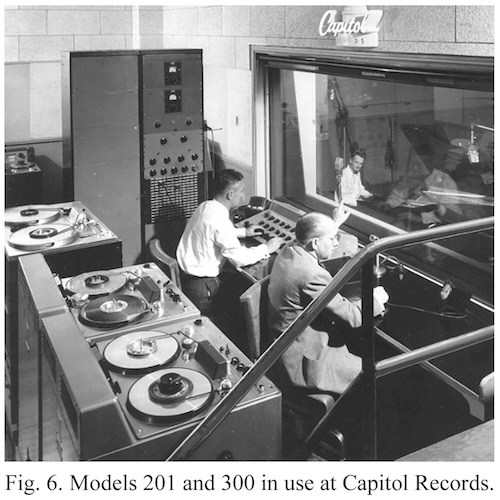
source: “History of The Early Days of Ampex Corporation, as recalled by John Leslie and Ross Snyder”, AES Historical Committee, December 17, 2010.
The Billboard 誌 1948年5月22日号には、キャピトルが磁気テープ装置を購入して、ディスク製造にどのように使えるか実験を行う、という記事「Cap’s Plunge Into Magnetic Tape Recording Experiments May Face-Lift Waxery Trade」(Capitol の磁気テープ録音実験参入により、ディスク業界に変革が起こるか)が掲載されています。
May 22 1948 issue of The Billboard features the article entiled “Cap’s Plunge Into Magnetic Tape Recording Experiments May Face-Lift Waxery Trade”.
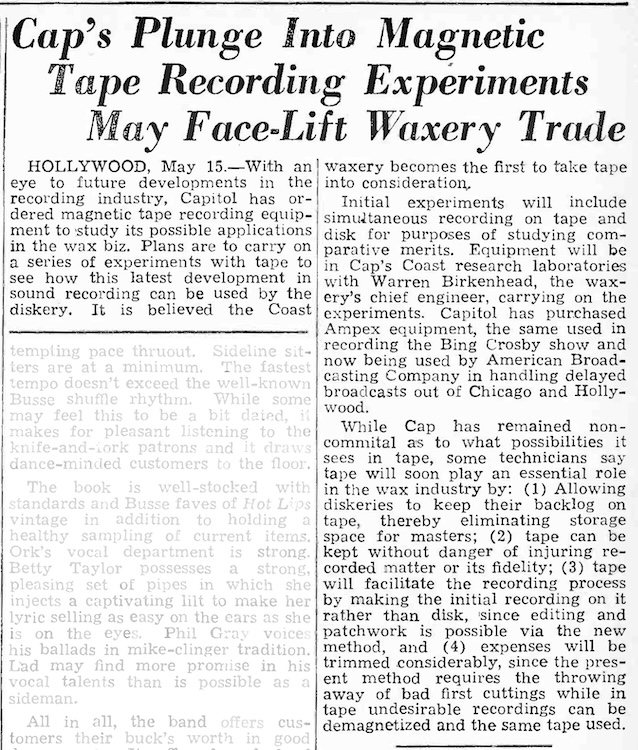
source: “Cap’s Plunge Into Magnetic Tape Recording Experiments May Face-Lift Waxery Trace”, The Billboard, Vol. 60, No. 21, May 22, 1948, p.27.
HOLLYWOOD, May 15 — With an eye to future developments in the recording industry, Capitol has ordered magnetic tape recording equipment to study its possible applications in the wax biz. Plans are to carry on a series of experiments with tape to see how this latest development in sound recording can be used by the diskery. It is believed the Coast waxery becomes the first to take tape into consideration.
ハリウッド発、5月15日付 — Capitol は、録音業界の将来的な発展を視野に入れ、レコード業界への応用の可能性を探究するため、磁気テープ録音装置を発注した。テープを使って一連の実験を行い、サウンド・レコーディングにおけるこの最新の開発がディスク向上でどのように利用できるか、確認する計画である。西海岸のレコードレーベルである Capitol が磁気テープの活用を考慮する最初のレーベルとなる模様である。
Initial experiments will include simultanous recording on tape and disk for purposes of studying comparative merits. Equipment will be in Cap’s Coast resaerch laboratories with Warren Birkenhead, the waxery’s chief engineer, carrying on the experiments. Capitol has purchased Ampex equipment, the same used in recording the Bing Crosby show and now being used by American Broadcasting Company in hadling delayed broadcasts out of Chicago and Hollywood.
最初の実験では、テープとディスクへの同時録音を行い、その利点を比較検討する予定である。購入された磁気テープ録音装置は、Capitol の西海岸研究所に設置され、レーベルのチーフエンジニアである Warren Birkenhead が実験を担当する。Capitol が購入したのは Ampex 社の機材であり、Bing Crosby Show(ラジオ番組)の録音に使われ、同時に現在 ABC (American Broadcasting Company) 局が遅延放送に使用しているものと同一のものである。
While Cap has remained noncommital as to what possibilities it sees in tape, some technicians say tape will soon play an essential role in the wax industyr by: (1) Allowing diskeries to keep their backlog on tape, thereby eliminating storage space for masters; (2) tape can be kept without danger of injuring recorded matter of its fidelity; (3) tape will facilitate the recording process by making the initial recording on it rather than disk, since editing and patchwork is possible via the new method, and (4) expenses will be trimmed considerably, since the present method requires the throwing away of bad first cuttings while in tape undesirable recordings can be demagnetized and the same tape used.
磁気テープに対してどのような可能性を見出しているか、Capitol は口を閉したままだが、技術者の中には、ディスク業界においてテープが以下のような重要な役割を果たすだろうと言われている。 (1) ディスクメーカがバックログ(未処理分の音源)をテープに残すことができるようになり、マスター(ディスク)の保管スペースが不要になる。 (2) テープは、録音された音源の忠実度を損なう危険なしに保管可能である。 (3) テープは、編集やパッチワークが新しい方法で可能となるため、録音を直接ディスクに行う代わりにテープに行えば、録音プロセスが容易になる。 (4) 現在の方法(ディスク録音)では、カッティングに失敗したディスクを捨てる必要があるが、テープでは望ましくない録音は消磁して同じテープを再利用できるため、経費が大幅に削減可能となる。
“Cap's Plunge Into Magnetic Tape Recording Experiments May Face-Lift Waxery Trade”, The Billboard, Vol. 60, No. 21, May 22, 1948, p.27.そして、その4年後、The Billboard 1952年8月2日号に掲載された「The Capitol Story — A Decade of Growth and Success」でも、1948年8月に他レーベルに先駆けて磁気テープ導入を行った、と記載されています。
Four years later, on August 2, 1952 issue of The Billboard magazine has the feature article “The Capitol Story — A Decade of Growth and Success”, which denotes that Capitol started using magnetic tapes in August 1948.
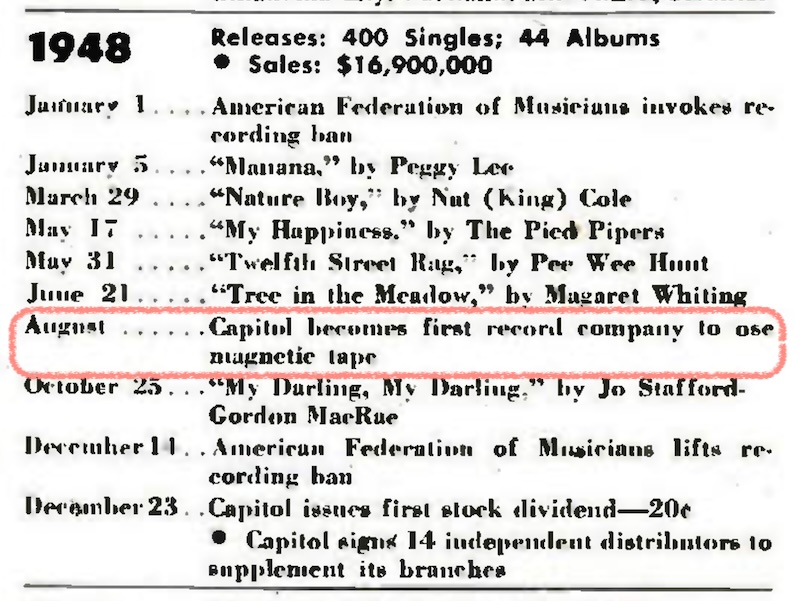
source: “The Capitol Story – A Decade of Growth and Success”, The Billboard, August 2, 1952, pp.50-51.
17.2.3 Reeves Sound Studios used Fairchild Magnetic Recorders
Wilma Cozart Fine そして C. Robert Fine (1922-1982) 、という、Mercury クラシック録音を代表する両者(ご夫婦)の息子である Tom Fine さんからの情報です。御尊父の C. Robert Fine 氏が働いていた Reeves Sound Studios でも、相当早い時期からテープ録音を使っていたとのことです。
Again, here is another information from Tom Fine-san, son of Wilma Cozart Fine and C. Robert Fine (1922-1982), both of whom represents the legendary Mercury Living Presence recordings. Reeves Sound Studios, where his father C. Robert Fine had worked then, had used magnetic tape recorders since the very early years.
Reeves/Fairchild was early as far as USA studios recording sessions to tape, going back to 1948.
アメリカのスタジオにおける(市販レコード制作用の)メディアとしての磁気テープ使用において、Reeves / Fairchild はかなり早かった。1948年まで遡ると思う。
Capitol was first, with the first Ampex 200A’s. There may have been some outlier small-label productions done using Brush Soundmirror (Model BK-401), but as far as mainstream labels and artists, Capitol was first.
(メジャーレーベルでは)最初期の Ampex 200A を使った Capitol が最も早かった。小規模レーベルでは、Brush Soundmirror (Model BK-401) を使ったりした例があったかもしれないが、メインストリームのレーベルやアーティストに関しては、Capitol が一番早かった。
quoted from the email written by Tom Fine to me (and to Nicholas Bergh) on Jun. 22, 2023.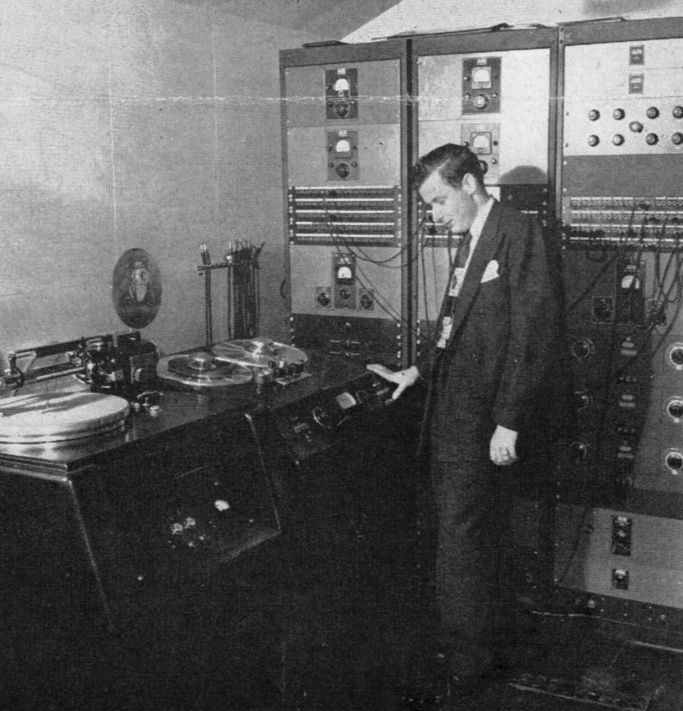
source: Reeves Sound Studios, NYC (1933-197x), Preservation Sound.
C. Robert Fine (Bob Fine) at the Reeves Sound Studio Studio A Cutting Room,
with Fairchild 523 Cutting Lathe and Fairchild Magnetic Tape Recorder
1949年、Reeves Sound Studio での C. Robert Fine (Bob Fine) 氏の様子。
Fairchild 523 カッティングレースと Fairchild テープレコーダが写っています。
17.2.4 Recording and Mastering, after the introduction of magnetic tape recorders
磁気テープがスタジオに導入されたことにより、新録レコード制作時のプロセスに変化が生じることとなりました。
The introduction of magnetic tape recorders into the studios changed the process during the production of new recordings.
従来は、録音スタジオで演奏された音源が、ラッカー原盤やワックス原盤にそのままカッティングされていました。つまり、今でいうところの「ダイレクトカッティング録音」です。すなわち、録音スタジオのマスタリング機材によって、録音EQカーブが規定されることになります。
Traditionally, sound source was played in a recording studio, and cut directly to lacquer or wax masters, what we now call as “direct-to-disc recordings”. In orhter words, mastering equipments in the studio dictated the recording EQ curve.
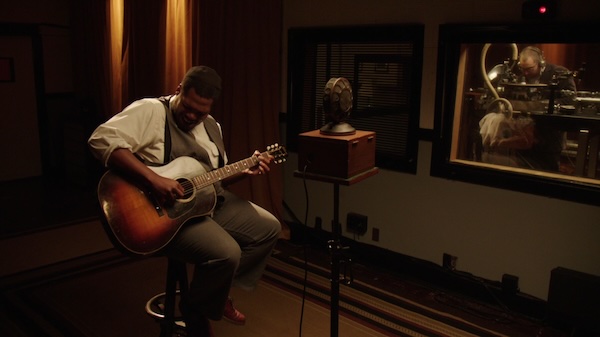
screenshot from the movie “The American Epic Sessions” (2017), capturing the recording session in the studio, direct-to-disc recorded with a vintage Scully lathe, cut by Nicholas Bergh.
ドキュメンタリー「The American Epic Sessions」(2017) 中の録音風景。スタジオルームの真横にあるカッティングルームに設置された、フルレストアされた Scully レースでダイレクトカッティング中。エンジニアは Nicholas Bergh 氏。
その後、ラッカー原盤やワックス原盤が、委託するプレス工場(独立系、または大手レーベル所有の工場)に送られ、スタンパー製造や実際のプレスが行われました。
The lacquer/wax masters were then sent to pressing plants (either independent or of major labels) to consign producing stampers and actual discs.
しかし、磁気テープ導入後、録音スタジオとマスタリングスタジオが必ずしも一緒ではなくなります。そのため、録音スタジオもマスタリングスタジオもプレス工場も所有していた大手レーベルはさておき、多くの独立系レーベルは、録音スタジオで収録されたテープを、マイクログルーヴ盤にマスタリング可能なマスタリングスタジオに送り、カッティングしてもらうことになりました。
However, after the introduction of magnetic tapes, recording studios and mastering studios are no longer necessarily located together, although major labels owned recording studios, mastering studios, and pressing plants at once. Therefore, many independent labels did recording sessions at recording studios, then tapes were sent to mastering studios for microgroove cutting.
特に LP や 45回転盤黎明期は、全ての録音スタジオでマイクログルーヴ盤のマスタリング(カッティング)ができたわけではなかったこと、大手レーベルや大手独立系スタジオがマスタリングや製造ノウハウを先行して有していたこと、などがあげられます。
Especially in the very early years of LPs and 45 rpms, not all recording studios were capable of mastering (cutting) microgroove lacquers yet; and major labels as well as major independent studios had the mastering / manufacturing know-how ahead of others.
録音スタジオとマスタリングスタジオが別の場合、当然ですが、録音スタジオではなく、マスタリングスタジオの機材によって録音EQカーブが規定されることになります。
If the recording studio and mastering studio are separate, of course, the recording EQ curve will defined by the mastering studio’s equipments, not those of the recording studio.
本稿で後述する通り、さまざまなパターンがありました。
As will be discussed later in this Pt. 17 article, there were a variety of patterns.
大手レーベルは、録音スタジオ、マスタリングスタジオ、プレス工場の全てを所有していました(場合によっては複数)。
Major labels owned all recording studio, mastering studio, and pressing plant (and in many cases, more than one each).
一方、マイナーレーベルの多くは、独立系録音スタジオなどで収録させてもらい、マスタリングやプレスを外部に委託していました。その際、マスタリングとプレスを大手レーベルに委託するケースも、独立系マスタリングスタジオに委託してそののちプレス工場で製造してもらうケースもありました。
On the other hand, many minor labels had their recordings made at independent recording studios, etc., and outsourced mastering and pressing to outside companies. In some cases, the mastering and pressing were outsourced to major labels, while in others, the mastering was outsourced to inpdenendent studios and then manufactured at the pressing plant.
もちろん、独立系スタジオの中には、録音スタジオそしてマスタリングスタジオを兼ね備えており、プレスのみ外部委託するケースもありました。
Of course, some independent studios had both recording / mastering facilities, and only the pressing was outsourced.
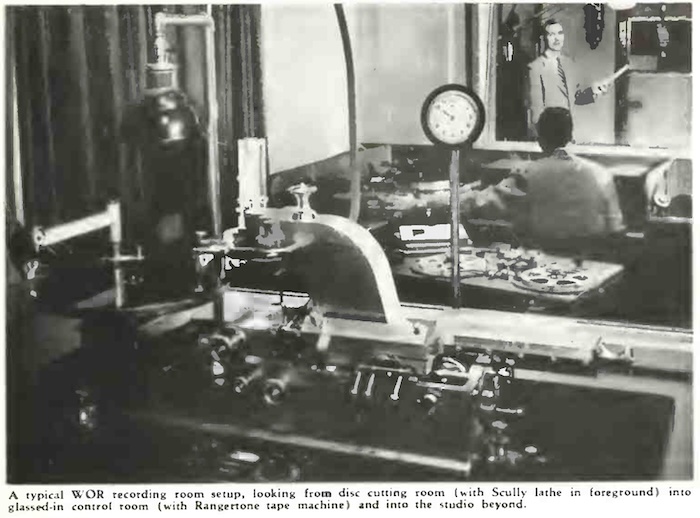
source: “A World Of Recording at WOR”, Audio Record, Vol. 8, No. 2, February 1952, p. 3.
1952年の WOR スタジオをとらえた写真。一番奥が収録スタジオ、真ん中がコントロールルームでテープ録音中、手前がカッティングルーム。
looking from disc cutting room (with Scully lathe in foreground) into glassed-in control room (with Rangertone tape machine) and into the studio beyond.
では、そういったマスタリングスタジオは、各レーベルの個々のリクエストに応じて、録音特性(録音EQカーブ)をその都度変更していたのでしょうか?
So, did those mastering studios changed the recording characteristics (recording EQ curves) each time, according to the individual requests of each label?
おそらくそうではなかったのだろう(基本的には各スタジオはその時点で採用していた固定EQを使っていたのであろう)と考えています。この話は本稿 Pt. 17、およびシリーズ全体に通底する仮説となります。
I belive that this was probably not the case (basically, each studio was using the fixed EQ they employed at the point in time). This will be my hypothesis that runs throughout this Part 17 and the entire series of my article.
もちろん、あくまで仮説ですので、クライアントごとに録音特性を変更したスタジオの存在を証明する資料があれば、ぜひそれを見つけ出したいものです。
Of course, this is just a hypothesis (and my two cents), if there is some documentation that proves the existence of a studio that changed the recording characteristics for each client, I would love to find it.
17.3 Reeves Sound Studios as of 1949 / Fine Sound Studios as of 1952
1933年にオープンし、Fairchild 社と非常に懇意であった Reeves Sound Studios。商用録音や放送局トランスクリプション盤制作の他にも、主として映画用音声録音を行っていた、このスタジオに関する技術詳細は、1949年の FM and TV 誌に掲載されたという解説記事「Design of Recording Systems, Pts. 1-3 (by Leon A. Wortman)」にて非常に詳しく解説されており、必読です。
Opened in 1933, Reeves Sound Studio (primarily used for film sound recordings as well as commercial recordings and radio transcriptions) had shared close relationship with the Fairchild company. Technical details of this particular studio are described in great detail in the article “Design of Recording Systems, Pts. 1-3” (by Leon A. Wortman), which appeared in the FM and TV magazine in 1949. It’s such an incredible “must-read” article.
1949年〜1953年の技術面から見た状況を理解する上でも参考になるであろう、 1949年当時の Reeves Sound Studios に関する解説記事を、詳しく読み解いていきましょう。
Now we’re going to read the details of the article, which describes the technical details at the Reeves Sound Studios as of the year 1949. I belive this will definitely help understand the technical aspects in the industry, during the pre-RIAA LP era (from 1949 to 1953).
執筆者は Fairchild Recording Equipment 社の Technical Data 部門に所属していた Leon A. Wortman 氏で(本稿 Pt.12 セクション 12.2.1 のコラム にも登場します)、この記事は FM and TV 誌に2号連続で掲載された後、Fairchild 社のプロモーション用にブックレットにまとめられたものだそうです。スタジオで使用されている機材の詳細や、1949年暮れ当時の録音チェーンなどが詳しく解説されています。
The author is Leon A. Wortman, Tehnical Data Division, Fairchild Recording Equipment Corporation (his name already appears at Pt.12 Section 12.2.1’s column). Wortman’s article was initially published in two consecutive issues of the FM and TV magazine , then recompiled into a booklet for Fairchild’s promotional purposes. It details the equipment used in the studio and the recording chain at the end of 1949.
もちろん、のちに Fine Sound Studios 〜 Fine Recordings で活躍し Mercury Living Presence の一連の仕事で有名となる、チーフエンジニアの C. Robert Fine 氏やその右腕 のカッティングエンジニア George Piros 氏も登場します。ちなみに、この時期の Mercury はまだ、45回転盤への参入はしていませんでした。
Of course, this article features the chief engineer C. Robert Fine and his colleague (cutting engineer) George Piros. Both would later leave Reeves and establish Fine Sound Studios then Fine Recordings, known for the legendary Mercury Living Presence recordings. Incidentally, Mercury had not yet entered the 45 rpm market at this time.
Part 1 は、Reeves Sound Studios で使われている技術などの全般的な解説。Part 2 は、商用録音(市販レコード向け)の録音チェーンの詳細な解説。Part 3 は、スタジオA(TVや映画フィルム用)〜スタジオB(一般的なスタジオ録音)〜スタジオC(ミキシング用、およびフィルム制作用)のより詳しい解説、となっています。
Part 1 of the Worman article features the general overview of the technology and equipment used at the Reeves Sound Studios in 1949; Part 2 describing details of the recording chain for commercial recordings (i.e. phonograph records, etc.); Part 3 featuring the extended overview of the entire studio, including Studio A (for TV and movie film recordings), Studio B (for regular studio recordings) and Studio C (for mixing or film making).
17.3.1 All the Mercury releases around 1949 were cut at the Reeves Sound Studios
例えば Part 3「A description of The Reeves Sound Studios installation, the concluding Discussion of Unitized Equipment」では、1949年当時の Mercury 盤はReeves Sound Studios でカッティングされていたと解説があります。
For example, Part 3 “A description of The Reeves Sound Studios installation, the concluding Discussion of Unitized Equipment” describes that all Mercury records as of 1949 were mastered (cut) at the Reeves Sound Studios.
Standard and long-playing Mercury records are produced in the Reeves plant. Every Mercury record label is marked Reeves-Fairchild Margin Control. These words indicate that full dynamic range is obtained through the use of the instantaneous variable-pitch recorder described in Part 2 of this series.
Mercury レーベルの従来の(78回転)盤、および長時間(LP)盤は、Reeves スタジオで制作されている。Mercury 盤(LP)のレーベルには例外なく「Reeves-Fairchild Margin Control」と記されている。これは、本解説 Part 2 で説明した、即時バリアブルピッチ方式のディスクレコーダの使用により、フルダイナミックレンジが得られていることを示している。

(from my collection)
Limiting factors of dynamic range have been the high basic noise level of record pressings which masks pianissimo passages, and the danger of overcutting of full forte passages. Before the perfection of vinylite pressing, it was necessary to cut all sound at maximum level to override the high basic noise of shellac-composition pressings.
ダイナミックレンジを制限する要因は、ピアニッシモのパッセージを聞こえなくしてしまう、レコード盤由来の基本ノイズレベルと、フルフォルテのパッセージでオーバーカッティングしてしまう危険性である。ヴィニライト盤が完成する以前は、シェラック化合物で製造されたレコード盤のノイズに対応すべく、記録する音を可能な限り最大レベルでカッティングする必要があった。
However, now that the basic noise has been so greatly reduced, the recording studios have gone all out for life-like dynamic range. Records cut in this way are beautiful to hear, from pianissimo passages are no longer lost in background noise and, by varying the cutting pitch, to avoid overcutting as the signal level increases, a full dynamic range can be achieved.
しかし(ヴィニライト盤の登場により)このノイズの問題から解放された現在では、録音スタジオでは生命感あふれるダイナミックレンジを徹底的に追求するようになった。この方法でカットされたレコードは、ピアニッシモのパッセージがバックグラウンドノイズで失われることがなくなり、また、信号レベルが上がるにつれてカッティングピッチを変化させ、オーバーカッティングを避けることで、フルダイナミックレンジが実現可能となった。
“Design of Recording Systems, Part 3”, Leon A. WortmanBroadcast Telecasting 誌 1950年1月23日号 (Vol. 38, No. 4) p.45 に、Fairchild Equipment Corporation の広告が掲載されているのですが、Reeves Sound Studios のカッティングエンジニア George Piros 氏が Fairchild 523 で可変ピッチのノブを操作しながらカッティングする写真が掲載されています。
On page 45 of the Vol. 38, No. 4 (January 23, 1950) issue of the Broadcast Telecasting Magazine has the interesting ad by Fairchild Equipment Corporation: George Piros, a cutting engineer at the Reeves Sound Studios at the time, was operating the Fairchild Studio Recorder Unit 523, instantaneously adjusting the groove pitch while recording the lacquer disk.
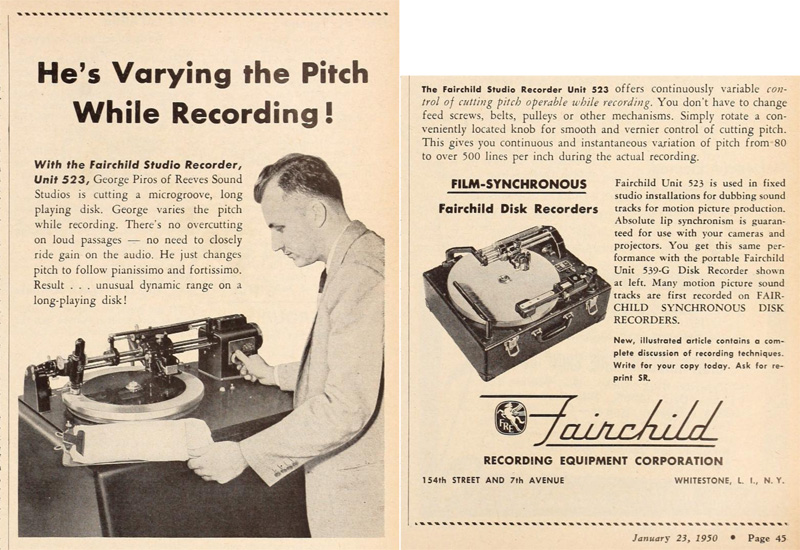
source: Fairchild ad, Broadcasting Telecasting, Vol. 38, No. 4, January 23, 1950, p.45.
17.3.2 Ormandy & Philadelphia Philharmonic at Reeves Sound Studios on May 10, 1949
同じく Part 3 には、Eugene Ormandy 指揮、Philadelphia Philharmonic Orchestra の THOMPSON: Louisiana Story レコーディング中の写真が掲載されています。
In the same Part 3 of the Mortman’s article, the photo of the session at Studio B by Philadelphia Philharmonic Orchestra, Eugene Ormandy conducting, recording “THOMPSON: Louisiana Story” is featured.
For example, the photograph of the Philadelphia Philharmonic Orchestra, Fig. 1, was taken during the actual recording of the musical score for “Luuisiana Story.” Disc and tape recording was done on channel B equipment, and played back for the director’s approval.
例えば、Fig. 1 として掲載したフィラデルフィア管弦楽団の写真は、(1948年に公開された白黒フィルムドラマの)「Louisiana Story」のためのスコアを実際に録音中に撮影されたものである。(Fig. 6 に掲載したブロックダイアグラムにおける)チャンネル B の機材でディスク録音およびテープ録音が行われたのち、ディレクタの許可の元プレイバックが行われた。
“Design of Recording Systems, Part 3”, Leon A. Wortman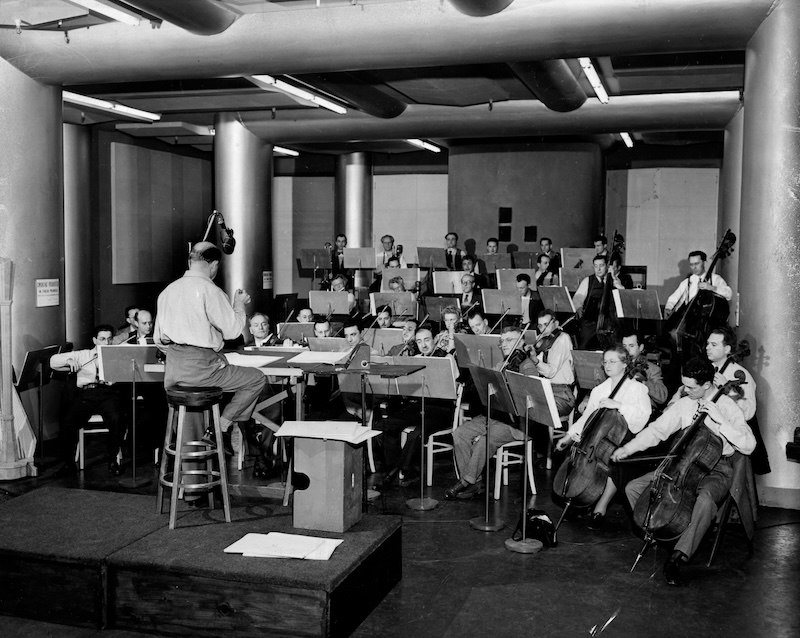
source: Reeves Sound Studios, NYC (1933-197x), Preservation Sound (original source: Tom Fine).
Eugene Ormandy conducting Philadelphia Philharmonic Orchestra, performing “Louisiana Story” at Reeves Sound Studio B
Reeves Sound Studio B で “Louisiana Story” をレコーディング中の Ormandy: Philadelphia 管弦楽団
各種 ディスコグラフィー を参照すると、この組み合わせは、1949年5月10日に録音された Columbia レーベル用のもので、Columbia Masterworks ML-2087 (10インチLP)として1950年にリリースされた音源のようです。
According to the discography information, this recording session was executed on May 10, 1949 for Columbia label, which would be released as Columbia Masterworks ML-2087 (10-inch LP) in 1950.
記事中では「チャンネル B の機材でディスク録音およびテープ録音が行われた」と書かれていましたが、ML-2087 のデッドワックスを確認したところ、Reeves Sound Studios 由来のマトリクスは存在しておらず、当時の Columbia Masterworks 10インチLP と全く同じ特徴の刻印しかなかったので、Reeves Sound Studio B で録音されたテープが Columbia に送られ、Columbia のスタジオでラッカーカッティングされたはず、と推定できます。
In the Wortman’s article, there is a paragraph “disc and tape recording was done on channel B equipment”. However, by inspecting the actual copy of ML-2087 and its deadwax information, no matrix derived from Reeves Sound Studios is there: only the ordinary matrix that is common among Columbia Masterworks 10-inch LPs. So I can say that the tape was recorded at Reeves Sound Studio B, then sent to the Columbia Studio, then the lacquer was cut by a Columbia’s engineer.
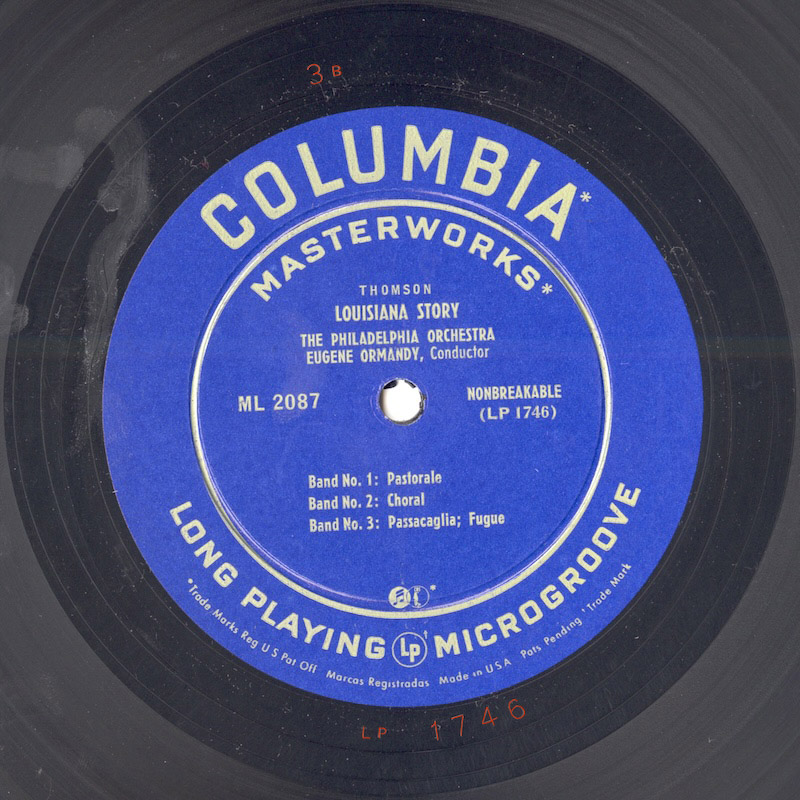
Columbia Masterworks ML-2087 Side-A
with Matrix stamp of “LP 1746” and “3B”, denoting Columbia’s own mastering
“LP 1746” というマトリクスから、Columbia 自社マスタリングと解釈できる
17.3.3 Reeves Sound Studios in 1949 using the NAB curve for commercial records as well
また、Part 1 “A Discussion of the Principles of Design” (録音スタジオ設計原則の解説) および Part 2 “A Detailed Description of a Commercial Recording Studio Composed Entirely of Unitized Audio Equipment” (ユニット化された機器のみで構成された、商用録音スタジオの詳細説明) では、Reeves Sound Studios の録音チェーンの詳細について解説が行われています。
Also in the Wortman’s article, namely in Part 1 “A Discussion of the Principles of Design” and Part 2 “A Detailed Description of a Commercial Recording Studio Composed Entirely of Unitized Audio Equipment”, details of the entire chain of the Reeves Sound Studio was described.
興味深いのは、1949年当時 Reeves スタジオでは、トランスクリプション盤用と市販盤用の両方において、ディスクカッティングにはパッシブ方式の NAB 録音規格イコライザを使っていた、と読めそうな記載です。まず、Part 1 では、NAB 録音再生規格についての簡潔な説明があります。
Interestingly enough, the description can be interpreted as: “passive NAB recording equalizer was used both for cutting transcriptions and commercial records”. Part 1 briefly explains the NAB Recording and Reproducing Standards.
The NAB Recording and Reproducing Standards Committee proposed that, in order to produce disks with a high signal level above the inherent noise, the frequencies above approximately 1,000 cycles have a rising characteristic. It was proposed that a 10,000 cycle signal be 16 db higher than a 1,000 cycle signal. With the adoption of this standard, it was possible to design a simple and inexpensive equalizer that can be inserted in the audio line to produce this characteristic curve automatically.
NAB 録音・再生標準規格委員会は、(ディスクの)固有ノイズを上回る高い信号レベルのディスクを製造するために、約 1,000Hz 以上の周波数帯域を持ち上げる記録特性を提案した。10,000Hz においては 1,000Hz の記録レベルに比べて +16dB となる特性である。この規格が採用されたことで、NAB録音特性カーブを自動的に生み出すシンプルで安価なイコライザを設計することが可能となり、録音チェーンに挿入するだけでよくなった。
(…snip…) An NAB equalizer, inserted ahead of the power amplifier, meets this standard. The equalizer can be quite compat, mounting in a rack panel space as small as 1 3/4 in. A switch is needed to permit instantaneous insertion and removal of the equalizer from the electrical circuit. Passive equalizers neccesitate insertion losses. If the insertion loss cannot be tolerated, an additional booster amplifier is required.
(…中略…) パワーアンプの前段に挿入される NAB 録音イコライザは、この標準規格を満たしている。このイコライザは非常にコンパクトにでき、1 3/4インチ(約44.5mm) のラックスペースにマウント可能である。また、このイコライザを即座に電気回路(録音チェーン)から除去、または挿入するためのスイッチが必要となる。ところで、パッシブ方式のイコライザでは挿入損失が生じるため、この損失が許容範囲を超える場合には、別途ブースターアンプの追加が必要となる。
“Design of Recording Systems, Part 1: “A Discussion of the Principles of Design””, Leon A. Wortmanそして Part 2 では、商用録音スタジオの詳細説明がなされていますが、ここでも NAB 録音イコライザと自動補正イコライザが使われている旨記載があります。少なくとも1949年時点では、レコーディングを委託されたレーベルごとにカッティング時の録音カーブを変更することなく、すべて NAB カーブに統一されていた、という可能性が高そうです。
Then the Part 2 of the Wortman’s article describes technical details of the studio for commercial recordings. Again, NAB recording equalzier was mentioned. So it could be highly possible that the Reeves (as of 1949) used NAB Recording Characteristics for any labels, rather than using different EQ curves for each label.
Automatic diameter equalizers and NAB equalizers are incorporated in the system, with in-out switching brought to a convenient panel on the cutting room rack.
(カッティング径にあわせた)自動補正イコライザと NAB イコライザがシステムに統合されており、カッティング室のラックにイン/アウトスイッチのついたパネルが設置されている。
“Design of Recording Systems, Part 2: “Detailed Description of a Commercial Recording Studio””, Leon A. Wortmanそういえば、最初期(1949年)の Mercury ポピュラー盤 LP は、のちの CD 復刻音源などの帯域バランスと比較すると、NAB カーブや Columbia LP カーブの方がしっくりくる盤があります。
By the way, I have several Mercury Popular LPs from very early years (1949), which sounds better with NAB curve or Columbia LP curve. This can be confirmed with the comparing with the sounds of later CD / digital reissues.
例えば手元の盤ですと、MG-20016 “Tenor Jazz” は、78回転盤時代としては非常に良好な音質で知られる Keynote レーベルのコンピレーションです。重量ヴィニライトプレス盤でペラジャケの最初期パターンです。
Here is Mercury MG-20016 “Tenor Jazz” for example. This LP is a compilation of Keynote label’s Jazz performances, which were originally recorded in the mid-1940s, which sounds very nice as the recordings from the late 78 rpm era. The copy I own is a heavy vinylite disc, glossy black/gold label, enclosed in a thin paper sleeve jacket.
本盤は、AES標準再生カーブや RIAA カーブによる再生だと高域がキンキンして聴こえます。後年 RIAA でリカッティングされた EmArcy 盤や後年の CD リイシューと比較しても、NAB カーブでの再生の方がフラットなのでは、と感じます。(聴感のみによる判断は全く客観的でないことに注意)
If I play this LP with RIAA or AES curve, it will sound too bright in the high frequency region, compared with the sound of EmArcy LPs (recut with RIAA) and later CD reissues. So I guess the NAB curve was used for mastering this particular LP (please note this is just my subjective opinion).
残念ながら、1949年当時の裏ジャケットには推奨再生カーブの記載もなく(リリースカタログのみ記載)、当時のスタジオの詳細な技術メモが残っているわけでもありませんので、あくまで仮説でしかありませんが。1951年に AES 標準再生カーブが発表・推奨される前、最初期の Merucry LP は NAB カーブ (つまり Columbia LP カーブに非常に近い) でカッティングされていた時期があった可能性も考えられます。
Unfortunately, this thin paper sleeve jacket for this particular LP (made in 1949 or 1950) has no mention about recommended reproducing characteristics: only a list of many Mercury LP releases is printed on the back side. Also, I don’t think any technical memo / documentation survive to describe how this particular LP was mastered from original Keynote masters. Anyway, Reeves Sound Studios might have used NAB recording characteristics (i.e. very close to Columbia LP’s characteristics) for mastering (cutting) commercial records, at least in the year 1949.
1948年に LP を最初に出したのは Columbia であり、その Columbia が Columbia LP カーブを使っており、AES 標準再生カーブが提唱されるまでは、他レーベルがその Columbia LP カーブに寄せるのは自然なことだと考えられるからです。
I guess so because: LP was originally unleashed by Columbia in 1948; Columbia used Columbia LP curve; and it was natural for many labels to mimic Columbia LP’s characteristics, until the AES Standard Playback Curve was published.
Tom Fine さんも以下のようにコメントしてくれましたが、同時に補足として、1951年1月に AES 再生カーブが発表される前から、Reeves で C. Robert Fine 氏や George Piros 氏が AES 相当の録音カーブを使っていた可能性も指摘していました。
Tom Fine-san also sent me a comment like this (please note, at the same time, he also pointed out that there is still a possibility that his father C.R. Fine and George Piros at Reeves might have used the AES curve BEFORE the AES Standard Curve was published in January 1951).
I think my father used the AES curve in the early 50s, if it was published. Very early Mercury LPs may have used Columbia’s original curve. Those would have been cut at Reeves.
1950年代初頭、AES再生カーブの仕様が公になってから、父 (C.R. Fine) は AES標準再生カーブに対応する録音カーブを使っていたと思う。Reeves でカッティングされた頃の超最初期の Mercury LP は、恐らく Columbia カーブを使っていたのだろう。
quoted from the email written by Tom Fine to me (and to Nicholas Bergh) on Jun. 28, 2023.さらに、ラッカー原盤や録音テープの製造メーカ Audio Devices Inc. の発行する業界誌 Audio Record 誌 に掲載された C.J. LeBel 氏の連載記事 “Disc-Data for the Recordist” において、マイクログルーヴLPの技術特性を解説する1949年2月号掲載の回では、「LP カッティング用にトランスクリプション用 NAB 録音カーブを使うことも可能」と書かれています。
Here’s another interesting article, this time in the Audio Record trade magazines published by Audio Devices Inc. (maker of lacquer discs and magnetic tapes for professionals), from Vice President C.J. LeBel’s serial article “Disc-Data for the Recordist”. Technical details of microgroove LPs are featured on Feb. 1949 article, where he notes as “standard transcription equalization can be used (for commercial microgroove recordings, as a replacement of Columbia’s LP curve)”.
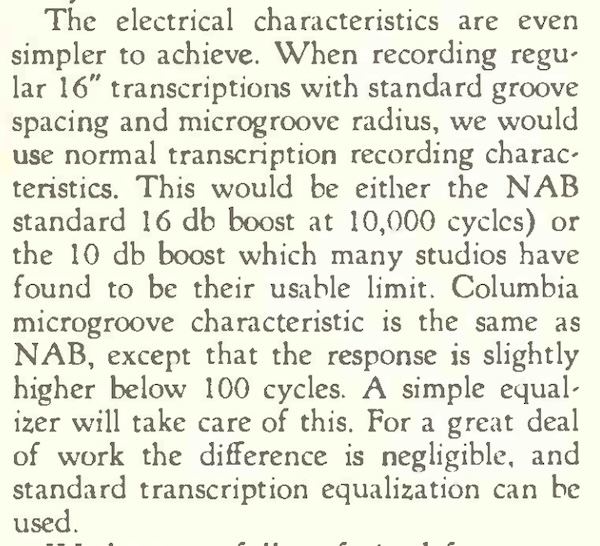
source: “Disc-Data for the Recordist: Microgroove In Your Studio Part 2, Equipment Requirements”, Audio Record, Vol. 5, No. 2, February 1949, p.3.
The electrical characteristics are even simpler to achieve. When recording regular 16″ transcriptions with standard groove spacing and microgroove radius, we would use normal transcription recording characteristics. This would be either the NAB standard (16 db boost at 10,000 cycles) or the 10 db boost which many studios have found to be their usable limit. Columbia microgroove characteristic is the same as NAB, except that the response is slightly higher below 100 cycles. A simple equalizer will take care of this. For a great deal of work the difference is negligible, and standard transcription equalization can be used.
(マイクログルーヴLPカッティング用の)電気的特性は更に簡単である。標準的なピッチで16インチトランスクリプション盤にマイクログルーヴでカッティングする場合は、通常のトランスクリプション盤用の録音特性を使用する。これは、10,000Hz で 16dB のブーストという NAB 標準規格、あるいは、多くのスタジオが使用可能な限界とみなしている 10dB ブーストのいずれかとなる。ちなみに Columbia 社のマイクログルーヴ LP の録音特性は、ほぼ NAB 特性と同じであるが、100Hz 以下のレスポンスが NAB に比べてわずかに高くなる。この差分は簡単なイコライザを使うことで対処可能である。また、ほとんどの録音においては、NAB と Columbia LP の差は無視できるほど小さいので、トランスクリプション盤カッティングで使用している録音イコライザをそのまま使用しても差し支えないだろう。
“Disc-Data for the Recordist: Microgroove In Your Studio Part 2, Equipment Requirements”, by C.J. LeBel, Vice President, AUDIO DEVICES, Inc. Audio Record, Vol. 5, No. 2, February 1949, p.3ですので、自らラッカーカッティングしていた独立系スタジオでは、Columbia LP 録音カーブの代用として NAB 録音カーブ用固定イコライザを使い、ラッカーカッティングをしていたのかもしれませんね。
So, this may suggest that many independent studios might have used the NAB recording characteristics as a substitute for Columbia LP recording characteristics.
余談ですが、Mercury Living Presence (Mercury Classics Olympian Series) の初録音、1951年4月23〜24日にシカゴのオーケストラホールで Ampex テープレコーダで記録された、Rafael Kubelik 指揮、Chicago Symphony Orchestra の “Pictures At An Exhibition” (Mercury MG-50000) は、Fine Sound Inc. 独立前、まだ Reeves Sound Studios チーフエンジニアだった C. Robert Fine 氏が録音を担当、Reeves Sound Studios のカッティングエンジニア George Piros 氏によりカッティングが行われました。
As a side story, the very first recording of Mercury Living Presence (Mercury Classics Olympian Series) was “Pictures At An Exhibition” (Mercury MG-50000), Chicago Symphony Orchestra, Rafael Kubelik conducting, recorded at Chicago’s Orchestra Hall on April 23-24, 1951. The recording engineer was C. Robert Fine, still during his career with Reeves Sound Studios (one year before he went out on his own Fine Sound Inc.), with George Piros as a mastering (cutting) engineer.
この1951年中頃の時期ですでに、記録特性を AES 標準再生カーブにあわせたものに変更されていることが、ジャケット裏の記載から読み解けます。
According to the liner-notes on the back cover, recording characteristics was the one that corresponded to the AES Standard Playback Curve.

“About This Recording…” section of Mercury MG-50000 (1951), recommending AES playback curve.
Mercury MG-50000 (1951) の裏ジャケより。AES 再生カーブが指定されている。
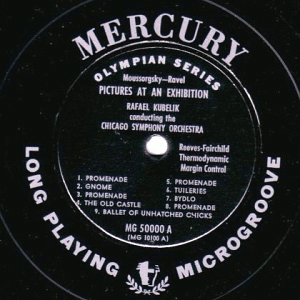
photo courtesy of Monte Fullmer-san
possibly the first variation of MG-50000: black/silver label with “Reeves-Fairchild Thermodynamic Margin Control”
MG-50000 のおそらく最初期のレーベル
1951年当時の Reeves Sound Studios で、録音用イコライザは NAB のままで、前段にEQ回路を追加して AES 相当に補正してカッティングしたのか、それとも盤(やレーベル)ごとに AES / NAB イコライザを切り替えてカッティングしたのか、正確なところは分かりません。
It is not known if the Reeves Sound Studios in 1951 used NAB recording equalizer unit with additional EQ networks to meet the AES curve, or different recording EQ units like NAB or AES were switched and used for recording (and for labels).
一方、1951年当時は、放送局用録音再生機格として 1949 NAB はまだ有効でしたから、当時の Reeves では放送局トランスクリプション用の機材と、市販用レコード用の機材とを分けて運用していたのかもしれません。
On the other hand, 1949 NAB Recording and Reproducing Standards was still valid in the broadcasting industry, so it could be that Reeves Sound Studios had two distinctive systems, one for electrical transcriptions, the other for commercial records.
1951年当時の Reeves Sound Studios の録音チェーンを解説する記事や資料を見つけられていませんので、あくまで推測でしかありませんが。
Please note that this is just my guess, because I cannot find any articles nor documentation that describe Reeves’ recording chain in 1951.
さて、同記事に戻ると、1949年当時の Reeves Sound Studios のシステム全体(コントロール室、カッティング室、エコーチェンバー)のダイアグラムが掲載されています。
Back to the Wortman’s article. It has a block diagram of the Reeves Sound Studio facilities (control room, cutting room, echo room, etc).
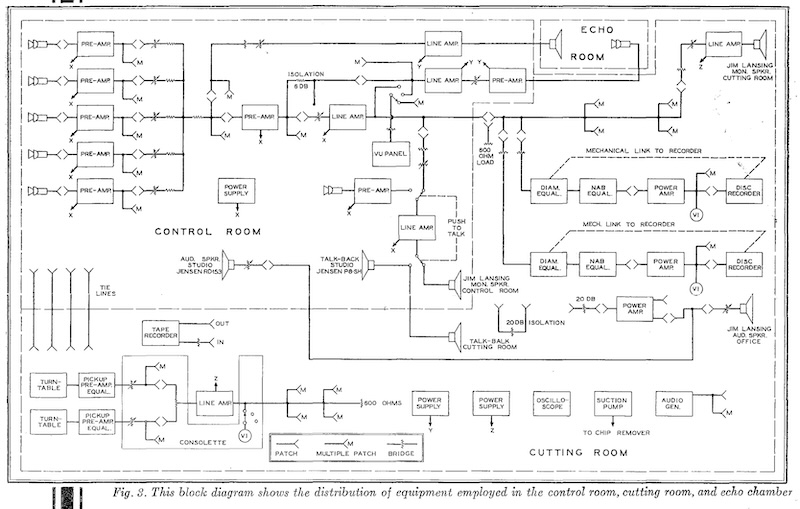
“Design of Recording Systems Part 2”, by Leon W. Wortman, 1949.
1949年当時の Reeves Sound Studios の市販レコード用全機材のブロックダイアグラム。コントロール室〜エコーチェンバー〜カッティング室。
カッティングレース近辺を拡大してみると、「Diameter Equalizer」「NAB Equalizer」「Power Amplifier」と順に接続されていることが分かります。最初の「Diameter Equalizer」は、ホットスタイラス方式が実用化されていなかった当時、線速度が落ちるラッカー盤中心に近づくにつれ高域補正を強めるための、録音自動補正イコライザです。
Close-up view near the disc recorders (cutting lathes) shows such recording chain: “Diameter Equalizer”, “NAB Equalizer” and “Power Amplifier” in line. The “diameter equalizer” was an automatic equalizer to adding the high frequency boost as the cutter goes to the inner diameter, when “Hot Stylus” technique was not widely practicalized.
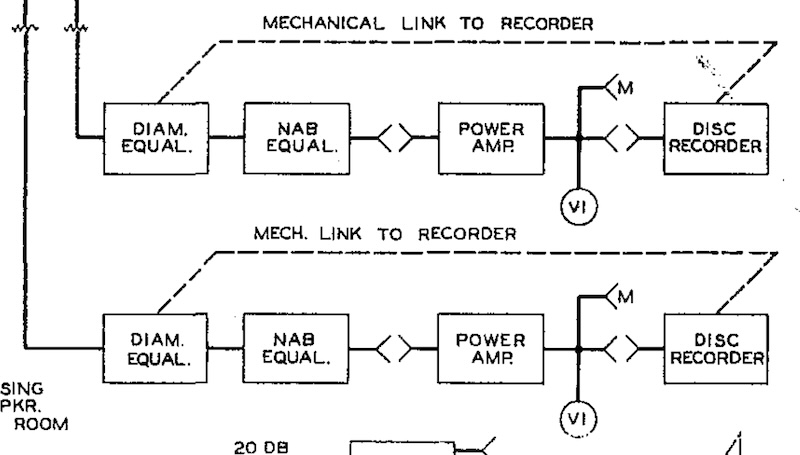
source: “Design of Recording Systems Part 2”, by Leon W. Wortman, 1949.
カッターヘッドが中心に近づくにつれ高域補正を強める自動補正回路が、NAB録音イコライザの前段に接続されている
この 自動補正イコライザ (Diameter Equalizer) は、放送局用トランスクリプション盤(16インチ 33 1/3回転)の頃から LP 黎明期まで使われていました。
Such diameter equalizers had been frequently used in the studios, from the electrical transcription years (1930s) to early LP years.
例えば RCA は、放送局用ラッカーカッティング機材用に、同様の自動補正イコライザとして「Automatic Recording Equalizer」を提供しており、1940年時点で MI-4894、その後 MI-11100 / 11101 をラインアップしていました。
For example, RCA manufactured its own “Automatic Recording Equalizer” MI-4894 (as of 1940) and MI-11100 / 11101 from the mid-1940s, for instantaneous transcription recordings.
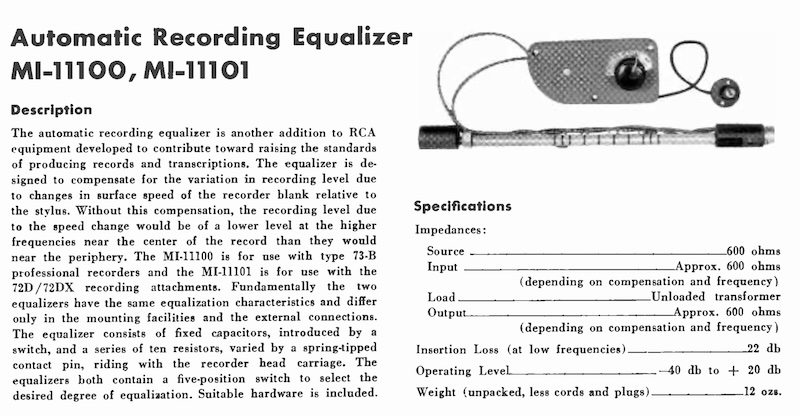
source: RCA Broadcast Audio Equipment, 1948, p.82
RCA 73-B および 72-D / 72-DX 用の、録音自動補正イコライザ
他にも、西海岸 Cinema Engineering 社の機材も当時の録音スタジオで広く使われていましたが、同社も Type No. 3991 Diameter Equalizer をラインアップしていました。スピンドルから12インチ離れた位置でのカッティングでは補正なしで、内側に進むに従って高域補正が強まり、半径5インチでは +8dB (10,000Hz) もブーストしてカッティングされていました。当時のカッター針では、線速度が落ちれば高域記録が弱くなるので、これでちょうどいい感じにカッティングできる、という仕組みです。
Also Cinema Engineering offered its own Type No. 3991 Diameter Equalizer. with zero db at 12 inches diameter, increasing to 8 db boost at 5 diameter at 10,000 cycles. Cutting heads before the advent of “Hot Stylus technique” could not record enough high frequency modulation as the linear velocity decreases, so such “diameter equalizer” was used to compensate the high frequency loss.

source: Cinema Engineering Company Catalog No. 10 (possibly in 1950?)
1950年前後に発行されたと思われる Cinema Engineering 社のカタログに掲載された Diameter Equalizer
ちなみに、Fairchild の自動補正イコライザは Fairchild Unit 628 Diameter Equalizer という型番でした。残念ながら、Fairchild 628 の写真や資料は見つけられませんでした。
Fairchild’s version was Fairchild Unit 628 Diameter Equalizer, although I could not find any photo or documentation of it so far, unfortunately.
1949年当時の Reeves Sound Studios では、この録音自動補正イコライザを市販LPのカッティングにも使っていたことが伺えます。そして、線速度が落ちても高域記録特性が十分に保てる「ホットスタイラス方式」(Pt. 12 セクション 12.2.2.1 を参照)が一般的になるまでは、多くのカッティングスタジオで同じように使われていたものと思われます。
So in 1949, Reeves Sound Studios used the 628 Diameter Equalizer for commercial LP mastering as well. Also, many mastering studios at the time had used similar automatic equalizers, until the “Hot Stylus” technique (see: Pt. 12 Section 12.2.2.1) became popular.
17.3.4 Fairchild Unit 627 Variable Equalizer
さらに Reeves では、録音エンジニアや音楽ディレクタがマスタリング時に望みの音を作るための 汎用可変イコライザ(プログラムイコライザ)を活用していた、という非常に興味深い記述があります。主に78回転盤などのLP復刻など、ダビング盤制作時の話のようですが、オリジナル音源の録音にも触れられています。
Wortman’s 1949 article also mentions Variable Equalizer (Program Equalizer) so that recording engineers and music directors could make desired sound with it, especially when dubbing from 78 rpms to LP masters. It was also used for recording original music.
Each dubbing presents an individual problem to the recording engineer whose conscientious ambition is to make the new release as perfect as the state of the art will permit.
各ダビング作業においては、担当するエンジニアに個々の問題を提示する。録音エンジニアは良心に基づいた野心を持ち、最新技術が許す限り、新しいリリースを可能な限り完璧にしようとするものである。
Also, in recording original music, the recording engineer, musical director, or other person supervising the audio quality may desire heavier bass or middle register, or more brilliance than is obtained by natural studio acoustics. These conditions all indicate the need for a versatile equalizer that can selectively boost or attenuate: various portions of the audio band simultaneously. Such a variable equalizer is not required to deliver power or voltage amplification. It essentially a zero gain device. All signal amplification is achieved by other elements in the recording system.
また、オリジナル楽曲の録音においても、録音エンジニアや音楽監督など、音質を監修する人が、スタジオの自然な音響で得られる音よりも重低音や中音域を重めにしたり、よりブリリアントな輝きの音を求めたりすることがある。これら全てのことから、オーディオ帯域のさまざまな部分を選択的かつ同時に増幅したり減衰したりできる、汎用性の高いイコライザが必要とされている。このような可変イコライザには、アンプのような増幅の必要がなく、本質的にゼロ・ゲインのデバイスである。信号増幅は、録音システム中の他の機器(アンプなど)によって達成される。
The variable equalizer must deliver, through continuously variable controls, a broad peak at any of the bass frequencies from QO to 100 cycles and at any of the treble frequencies from 4,000 to 10,000 cycles. Not only must it be possible to select the frequencies at which equalization is to take place, but the degree of equalization must be adjustable in amplitude from zero (flat response) to a maximum boost of 16 db. Separate controls are needed for roll-off of low and high frequencies, and there must be no interaction between the high and low frequency controls. Such a basic unit finds wide application in professional recording.
可変イコライザは、Q0〜100Hzの低音周波数帯域、および、4,000Hz〜10,000Hz の高音周波数帯域のいずれにおいても、連続する可変コントロールによって広いピークを提供しなければならない。イコライジングを施す周波数を選択できるだけではなく、0(フラットレスポンス)〜最大16dBまでイコライジングによる増幅量を調整できなければならない。低域と高域のロールオフには別々のコントロールが必要で、この両者に相互作用があってはならない。このような基本的なユニットは、プロの録音現場で広く使われているものである。
“Design of Recording Systems, Part 1”, Leon A. Wortman当時 Fairchild 社がラインアップしていた可変イコライザは Fairchild 627 という型番で、アクティブタイプ、現存数は5台とのことです。数年後に業界で一世を風靡しあっという間に取り入れられることとなる、Pultec EQP-1/1A に代表される汎用可変イコライザが登場するまでにも、このようにして独自に音作りをしていたスタジオもあった、ということなんですね。
Fairchild had its own variable equalizer Fairchild 627 — an active equalizer, and only five units known to exist. Anyway, until Pultec EQP-1/1A came along and instantly became the industry standard within a few years, many recording studios utilized several Variable Equalizers to get the desirable sound.
以下の動画は、Fairchild 627 のインスパイアモデル、AML ez627 のものです。
The below movie captures the AML ez627 in action, inspired by Fairchild 627.
そして、続くパラグラフが非常に興味深いです。
The next paragraph is simply interesting enough.
Vertical and lateral NAB standards, private standards, broadcast audio line equalization, elimination of distorted and noise spectra, pre-emphasis and deemphasis are all controllable for recording and playing back with the one variable equalizer unit. By mechanically linking the cutterhead with a potentiometer that is electrically connected to the variable equalizer, this unit can be used as an automatic diameter-equalizer. This technique provides the unusual control of both equalization frequencies and maximum boost level.
縦振動盤用NAB規格、横振動盤NAB規格、プライベートな規格、放送音声ラインのイコライゼーション、歪やノイズの除去、録音時のプリエンファシスと再生時のデエンファシスはすべて、単一の可変イコライザユニットで制御が可能である。この可変イコライザに、電気的に接続されたポテンショメータとカッターヘッドを機械的にリンクすることにより、このユニットを自動補正イコライザ(Automatic Diameter Equalizer)として使用が可能となる。この技術により、イコライザ周波数と最大ブーストレベルの両方をコントロールすることが可能となる。
“Design of Recording Systems, Part 1”, Leon A. WortmanReeves / Fairchild では、そんな汎用可変イコライザ (Fairchild 627) を使って、カッティング径と連動した自動補正イコライザ (Fairchild 628) に仕立て上げていた、と。
It’s interesting to know that Reeves / Fairchild utilized the Variable Equalizers (Fairchild 627) to build Diameter Equalizers (Fairchild 628).
それはいいのですが、なんと、ディスク録音・再生EQとして、可変イコライザも使用可能、という、不思議な話が出てきましたね。これについては、のちほど セクション 17.4.2 で詳しく掘り下げます。
However, it’s somewhat strange to read the line saying that the variable equalizer unit can be used for disc recording/reproducing EQ as well. I will discuss on this topic later in the Section 17.4.2 of this Pt. 17 article.
17.3.5 Fine Sound Studios as of 1952
C. Robert Fine 氏 は1951年暮れ頃に Reeves Sound Studios から独立し、1952年3月、ニューヨーク郊外の集落 Tomkins Cove に自らの Fine Sound Studios を立ち上げます。
In late 1951, C. Robert Fine left the Reeves Sound Studios, and established his own Fine Sound Studios in March 1952. The location was at Tomkins Cove, suburb of New York.
この頃の様子が、Audio Record 1952年11/12月号 の特集記事 “The Inside Story of FINE SOUND, Inc.” に捉えられています。著者は再び Leon A. Wortman 氏です。
The story of this is featured on Nov.-Dec. 1952 issue of the Audio Record magazine, as a featured article “The Inside Story of FINE SOUND, Inc.”. The author is, again, Leon A. Wortman.
Skipping a few periods of chronology and the details of the years spent as a lad shaving wax masters, inspecting styli, learning how to service and adjust equipment and make masters for a living, “Bob” Fine’s career has carried him through positions as Chief Engineer of Majestic Records, and Chief Engineer of the Disc and Tape Recording Divisions of Reeves Sound Studios. In March of this year he fulfilled a normal American ambition for independence by establishing Fine Sound, Inc.
ワックス原盤を削り、スタイラスを検査し、機器の修理と調整の仕方を学んだりした、少年時代の詳細は少し飛ばすとして、原盤制作で生計を立てるに至った “Bob” Fine 氏のキャリアは、Majestic レーベルのチーフエンジニア、そして Reeves Sound Studios のディスク・テープ録音部門のチーフエンジニアというポジションを経てきた。今年 (1952年) 3月、彼はついに Fine Sound Inc. を設立し、アメリカ人として当然の野心である「独立」を実現した。
The Inside Story of FINE SOUND, Inc. by Leon A. Wortman, Audio Record, Vol. 8, No. 8, Nov.-Dec., 1952, p.2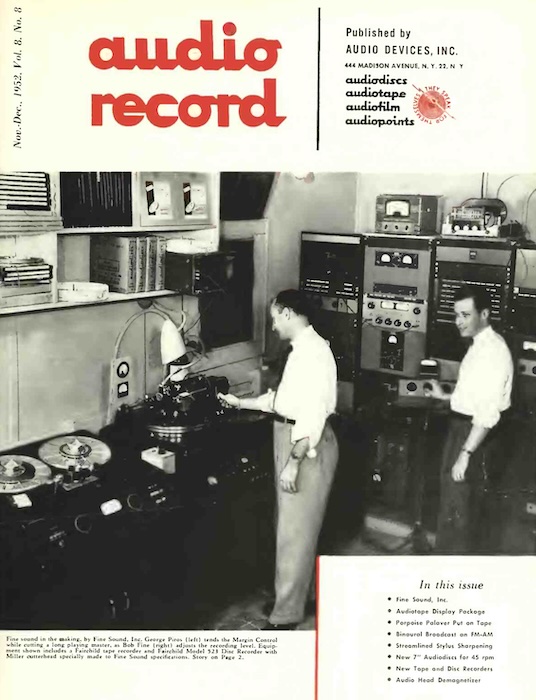
cover page (p.1) of Audio Record, Vol. 8, No. 8, Nov.-Dec., 1952.
Audio Record 誌1952年11/12月号の表紙に掲載された、当時の Fine Sound Studios のカッティングルーム
当該号表紙の写真には、次のようなキャプションがついています。基本的には、Reeves Sound Studios で使っていたのと全く同じ機材が写っているようです。
The front cover of this issue captures the Fine Sound Studios and its equipment, looking very similar (or identical) to what Mr. Fine and Mr. Piros used at the Reeves.
Fine sound in the making, by Fine Sound, Inc. George Piros (left) tends the Margin Control while cutting, a long playing master, as Bob Fine (right) adjusts the recording level. Equipment shown includes a Fairchild tape recorder and Fairchild Model 523 Disc Recorder with Miller cutterhead specially made to Fine Sound specifications.
Fine Sound 社での優れた (fine) 音の制作の模様。George Piros (写真左) が、マージンコントロール(可変ピッチ)を行いながらカッティングを行いつつ、Bob Fine(写真右)が録音レベルを調整している。Fairchild テープレコーダ、Fairchild 523 ディスクレコーダ(カッティングレース)、Fine Sound 専用仕様の Miller カッターヘッドなどの機材が写っている。
Audio Record, Vol. 8, No. 8, Nov.-Dec., 1952, p.1この表紙に使われた元となる高解像度写真のスキャンを Tom Fine さんが提供してくださったのですが、それを見た上で、Nicholas Bergh さんがその他の機器も特定してくれました。
Tom Fine-san kindly shared me (and Nick-san) a high-resolution scan of this cover photo. Then Nicholas Bergh-san kindly identified the equipment captured in the photo.
The main signal chain before the lathe is an Altec 322C limiter into an Altec 287 amp to drive the cutting head (amp uses big PP 845 tubes). The main EQ shown is the standard Cinema Engineering passive “program equalizer.” The 322C probably has enough make-up gain for the loss of this, but there is also an Altec preamp in the rack for make-up gain.
メインのシグナルチェーンはまず Altec 322C リミッターで、それが Altec 287 パワーアンプ(大型の PP 845 真空管が使われている)につながり、このアンプがカッティングレースのカッターヘッドを駆動する。(それらの前段に)メインのイコライザが写ってるけど、これは Cinema Engineering 社製のパッシブ式可変プログラムイコライザだね。恐らく 322C には(プログラムイコライザによる)ゲイン損失を補填するだけのメイクアップゲインを備えていると思うが、同じくメイクアップ用のラックには Altec のプリアンプも写っているね。
They would not use the program EQ for disc pre-emphasis. It was just used for minor corrective EQ like if something was “muddy” sounding and needed a little help.
(Cinema Engineering の)可変プログラムイコライザはディスク録音時のプリエンファシスとして使われていなかったはずだ。音が濁ったり籠ったりした場合にちょっと手直しが必要な場合など、そういったちょっとした補正用に使われたんだね。
There would have been a passive filter just for the recording curve like those shown in the catalog. Often there was also a high-pass and low-pass filter option in the cutting chains.
(この写真には写ってないけど)、録音用プリエンファシス専用の(Cinema Engineering 社の当時のカタログに掲載されているようなタイプの)イコライザが設置されていたはずだ。当時のカッティングチェーンにはさらに、オプションとしてハイパスフィルタやローパスフィルタが組み込まれていることも多かったんだ。
quoted from the email written by Nicholas Bergh to me (and to Tom Fine) on Jun. 28, 2023.この Fine Sound Studios でカッティングされた Mercury 向けの全LPは、RIAA 移行前は AES 標準再生カーブにあわせた録音特性でカッティングされていましたので、自作の AES 録音用イコライザ、または Cinema Engineering 社や Fairchild 社などに特注してもらった AES 録音用イコライザが、パワーアンプの前段に設置されていたのでしょうね。
Before the transition to the RIAA Recording/Reproducing Characteristics, all records cut at the Fine Sound Studios were cut with the curve for the AES Standard Playback Curve. So Mr. Fine and Mr. Piros could have used their self-made AES recording equalizer, or custom-made recording equalizer (by Cinema Engineering or Fairchild), inserted before the power amplifier that drove the cutterhead.
もともとはニューヨーク州ロックランド郡ストニーポイントの小さな集落 Tomkins Cove に居を構えた Fine Sound Studios でしたが、1953年10月にニューヨーク5番街711の WMGM Studios に移動し、ここが新しい Fine Sound Studios となります。WMGM Studios を所有していたのは Loews / MGM で、C. Robert Fine 氏が映画用に開発したマルチチャンネル光学サウンドトラックシステム PerspectaSound に Loews / MGM が興味を持ち、Fine Sound Inc. ごと権利を取得、WMGM Studios に移動させた、ということのようです。
Fine Sound Studios was originally located at Tomkins Cove, a hamlet in the Town of Stony Point, Rockland County, NY. Then in October 1953, Fine Sound moved to the new location at 711 Fifth Ave, NYC, previously WMGM Studios. In fact, Loews / MGM owned the WMGM Studios (1948-), and it acquired Fine Sound Inc. and Mr. Fine’s invention PerspectaSound (multi-channel optical soundtrack system for movies), then Fine Sound Studio was moved from Tomkins Cove to the WMGM Studio.
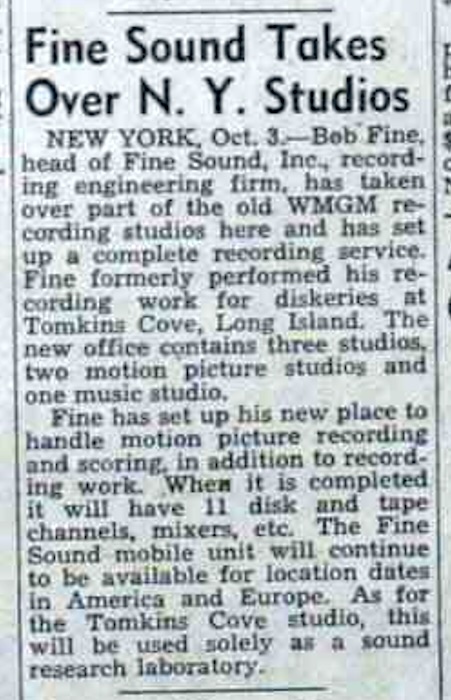
source: “Fine Sound Takes Over N.Y. Studios”, The Billboard, October 10, 1953, p.18.
1953年10月3日付のニュースとして、Fine Sound Inc. が WMGM Studios に入ると伝える記事
WMGM Studios といえば、幾多の重要ジャズ録音が行われたスタジオでもあり、Fine Sound Studios と名前が変わっても Verve 系 (Clef/Norgram) や Mercury / EmArcy 系の多くのジャズ録音で使われたスタジオでもあります。
Many important Jazz recordings were conducted at the WMGM Studios, and after the name changed to Fine Sound Studios, more of the Jazz recordings for Verve (Clef/Norgran) and Mercury / EmArcy labels were done there.
訴訟など大人の事情で1956年に Fine Sound Studios をたたまざるを得なくなった Fine 氏ですが、翌年1957年からマンハッタン57丁目のグレート・ノーザン・ホテル内で Fine Recording Inc. を開始、再び第一線で活躍することになります。
Due to a complicated situation including lawsuits, Mr. Fine had to give up Fine Sound Studios in 1956. But in 1957, Mr. Fine would start Fine Recording, Inc. in the Great Northern Hotel on 57th St., Manhattan, to make another history.
17.4 The Advent of Program (Variable) Equalizer
LPや45回転盤などマイクログルーヴ盤が登場し、磁気テープが全米の録音スタジオにどんどん導入されていった、1948年〜1950年頃。また、カッティング機材・技術もますます発展の途上にありました。
It was in 1948 to 1950 when LPs and 45 rpms (microgroove records) surfaced; and magnetic tape recorders instantly became popular in the studios.
特にカッター針周りの技術進化はめざましく、ホットスタイラス技術により、内周に近づいてもほとんど高域減衰せず、かつ静粛にカッティングできるようになったほか、従来は 10,000Hz あたりが上限であった記録がより高い周波数帯域まで充分にカッティングできるようになっていきました。
Also, the recording equipment and technique was still under the development. Especially the development of cutterheads was huge: “Hot Stylus” technique enabled smooth cutting, as well as adequate high frequency cutting even if the linear velocity decreased; it also broke the frequency limit, enabling to cut higher frequencies above 10,000Hz.
その変化にあわせて、1951年に発表された AES 再生カーブでは、15,000Hz まで規定されていました。1942年に初版が発表された16インチワイドグルーヴトランスクリプション盤用の NAB 録音再生カーブや、重低域を除き NAB カーブと同一とみなしてよい Columbia LP カーブなどは、上限 10,000Hz までしか規定されていなかったのに、です。
In order to meet these technological improvement, The AES Standard Playback Curve (1951) defines the frequency range up to 15,000Hz, while the NAB Recording and Reproducing Standards (initially published in 1942; revised in 1949) and the Columbia LP curve (same as NAB except the low-bass region) defined the frequency range only up to 10,000Hz.
このことにより、1940年代から盛んに議論されていた「NAB録音特性のプリエンファシスが強すぎるから弱めるべき」という話がますます現実味を帯びてきて、より高周波数の帯域でも歪まないように、プリエンファシスを弱める機運がますます高まっていきました。NAB カーブや Columbia LP カーブの高域プリエンファシスのままだと、10,000Hz より上の周波数帯域の高域増幅が強くなりすぎ、再生時のトレースが困難になったり、歪が発生しやすくなったりするからです。これが 1951年の AES 再生カーブの策定にも影響しているほか、のちの 1953年の NARTB カーブ、1954年の改訂 AES 再生カーブ、そして 1954年の RIAA カーブの策定へとつながります。
All these technological development led to further discussion of decreasing the high-frequency pre-emphasis, in order to avoid high frequency distortion. NAB and Columbia LP curves adopted 16 dB boost at 10,000Hz, which would theoretically lead excessive boost above 10,000Hz, resulting poor tracking (with tonearms and pickups at the time) and excessive distortion. This would be the main reason of the future standards: 1951 AES (12 dB boost at 10,000Hz), and 1953 NARTB / 1954 new AES / 1954 RIAA (13.7 db boost at 10,000Hz).
復習を兼ねて、1951年1月に発行された “AES Standard Playback Curve” 論文の該当部分(Pt. 16 セクション 16.4.2)を再度引用しておきましょう。
Below is the quotes again from the “AES Standard Playback Curve”, originally published in January 1951. It is previously quoted in the Pt. 16 Section 16.4.2 of my article.
The majority of engineers active in the recording field have felt for some time that the degree of high-frequency emphasis prescribed by the NAB transcription characteristic is excessive. The trend in modern microphones and amplifiers to a wider frequency range, approaching 15,000 cps, and the use of acoustically brighter studios have made this problem much more difficult. With this extended range, the acceleration of the reproducing stylus becomes a limiting factor.
録音現場で活躍するエンジニアの大半は、NABのトランスクリプション盤用に規定されている高周波帯域でのプリエンファシスが過剰である、と以前から感じてきたところである。近年のマイクロフォンやアンプでは、15,000Hz に迫る広い周波数帯域を扱えるようになってきており、また音響的に明るいスタジオが好んで使われるようになってきたため、このプリエンファシスの問題はさらに難しいものとなっている。周波数帯域が広くなればなるほど、再生用スタイラスの追従可能な加速度が制限要因となってしまう。
Consequently, it was deemed necessary to restrict the degree of high frequency rise used in recoring. This was accomplished by making the reproducing characteristic roll off only 12 db at 10,000 cps — approximately 3 db below the NAB specification — and continuing the response out to 15,000 cps. By doing this, the high-frequency situation has been alleviated somewhat.
そのため、録音時の高域プリエンファシスを抑え気味にすることが必要となる。再生特性において、10,000Hz でのロールオフを 12dB だけロールオフさせる(これは NAB 規格より約 3dB 少ない)、15,000Hz までレスポンスを継続させることによって実現した。これにより、高域での状況は多少緩和されたことになる。
Since microphone and studio characteristics must be considered by the recording engineer, it is required that the sum of the electrical rise in the recording equipment and the acoustic rise in the microphone must not exceed the values shown by the reciprocal of the reproducing characteristic, unless it is intended to make the high end over-brilliant.
録音エンジニアは、マイクやスタジオの特性を十分に考慮せねばならないため、意図的に高域を過剰に強調する意図がない限りは、録音機器の高域増幅とマイクの高域増幅の和が、再生特性を反転した値を超えないよう、細心の注意を払う必要がある。
“AES Standard Playback Curve”, Audio Engineering, Vol. 35, No. 1, January 1951, pp.22, 44-4517.4.1 Pultec EQP-1 and other variable equalizers
テープによる録音や編集の利便性向上、そしてカッティング技術の向上により、スタジオの現場ではより自由に音作りができる素地が整っていきました。上述した Fairchild 627 であったり、Cinema Engineering Type 4031-B であったり、Hycor Type 4201 であったり、Langevin EQ 258-A であったり、さまざまな可変イコライザが録音チェーンで使われようとしていました。
The convenience of magnetic tape recording and editing, as well as improvements in cutting technology, provided the basis for greater freedom of sound creation in the studios. Various “Variable Equalizers”, such as Fairchild 627, Cinema Engineering Type 4031-B, Hycor Type 4201, Langevin EQ 258-A, etc. were being used in the recording chain.
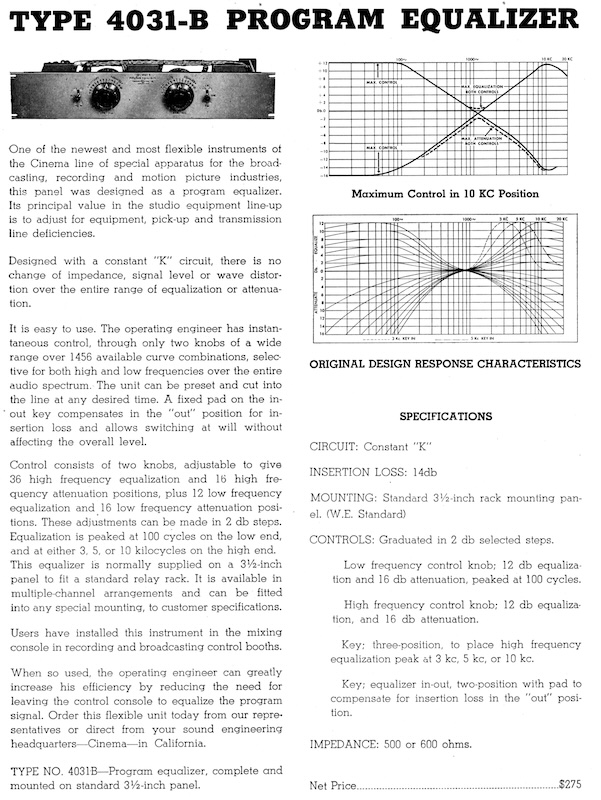
source: Cinema Engineering Company Catalog No. 11AX (possibly in 1951?)
1951年頃に発行されたと思われるカタログに掲載された、Cinema Engineering 4031-B 可変イコライザ
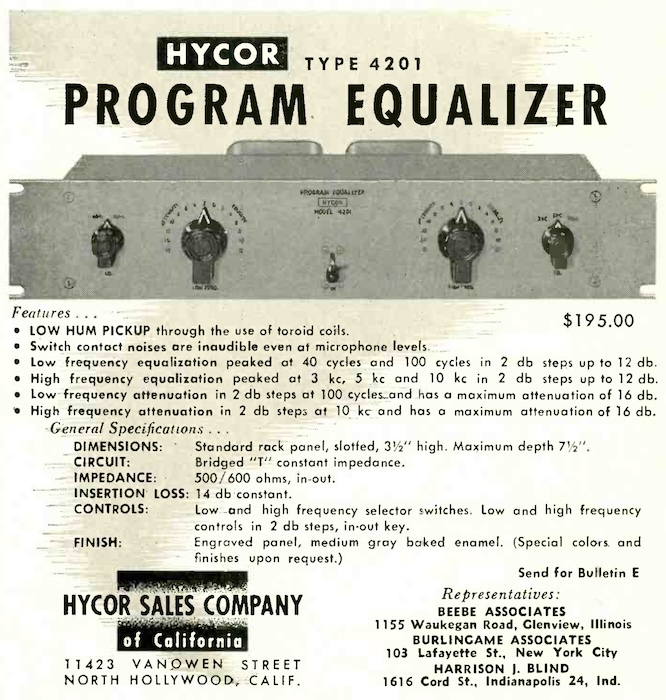
source: Hycor Type 4201 Program Equalizer Ad, Audio Engineering, Vol. 37, No. 11, November 1953, p.54.
そんな中、あっという間に全米の録音エンジニアの間でデファクトスタンダードとして導入されたのが、1951年に登場した、かの Pultec EQP-1 可変イコライザ、および後継の EQP-1A です。
Meanwhile, the Pultec EQP-1 was introduced in 1951; and its successor EQP-1A quickly became the de facto standard among recording engineers throughout the United States.

EQP-1: image obtained from: “A BRIEF HISTORY OF THE PULTEC COMPANY” by Mark Williams.

EQP-1A: image obtained from the PULTEC website.

source: Pultec EQP-1A Equalizer Manual (1950s?)
Pultec EQP-1A マニュアルに掲載された、可変イコライザカーブの例
EQP-1 最初期ユーザのひとりである、Capitol (1946-1951) → MGM (1951-1957) の録音エンジニア Clair Krepps 氏 (1918-2017) へのインタビューによると、1950年代当時はマイクごとに特性がバラバラで、スタジオで鳴っているナチュラルな音をそのまま記録するために、可変イコライザが必要だった、そこで MGM 移籍直後の1951年、旧知の仲であった Pultec (Pulse Technology) 創設者 Eugene Shenk と Oliver Summerland に前金 $250 を払って制作を依頼した、と語っています。
There is an interview with Clair Krepps (1918-2017), a recording engineer at Capitol (1946-1951), then at MGM (1951-1957), and one of the first EQP-1 users. According to the interview, he insisted “what the industry needs is an equalizer”, because “An equalizer is the tool to correct the deficiencies of microphones, room acoustics, or for special effects”. So in 1951 (when he resigned from Capitol and moved to MGM) he asked his old acquaintances, Eugene Shenk and Oliver Summerland (founders of Pultec = Pulse Technology) to build such variable equalizers for $250 up front.
Susan Schmidt Horning 氏の著書「Chasing Sound: Technology, Culture, and the Art of Recording from Edison to the LP」にも、以下のような一節を確認できます。
Susan Schmidt Horning’s book “Chasing Sound: Technology, Culture, and the Art of Recording from Edison to the LP” also has the following paragrah:
The early equalizers, made by Cinema Engineering for the movie industry, posed problems when used in mastering phonograph records. They were noisy, made audible clicks when adjusted, and caused a full twenty-four decibel loss, which required the use of another amplifier to correct. Krepps, who hated using them, supported the development of the first quality equalizer for recording, made by Oliver Summerlin and Gene Shenk, two New Jersey audio engineers.
初期のイコライザは、Cinema Engineering 社によって映画産業用に作られたものだったが、レコードのマスタリングに使用する際には問題があった。ノイズが多く、調整時にクリック音が聞こえた。また 24dB の減衰が発生するため、別途アンプが必要となった。Krepps はこのようなイコライザの使用を嫌い、ニュージャージー州のオーディオエンジニア、Oliver Summerlin と Gene Shenk による初の高品質録音用イコライザの開発を支援した。
“Chasing Sound: Technology, Culture, and the Art of Recording from Edison to the LP”, p.114, by Susan Scmidt Horning, The John Hopkins University Press, 2013.ともあれ、EQP-1A に代表される可変イコライザが録音スタジオのデファクトスタンダードになったことにより、録音エンジニアは、特にポピュラー音楽向けに、思い思いの音を自在に作れるようになりました。つまり、ディスク録音再生カーブとは独立した「音作り」です。
Anyway, after the variable equalizer units such as the EQP-1A soon became the de facto standard in the recording studios, recording engineers (as well as musicians and producers) finally obtained the tool to create any sound they desired, especially for popular recordings. In other words, “sound making” became independent of the disc recording and playback EQ curves.
可変イコライザが一般的になる前は、ディスク録音EQカーブも音作りの一部だったのかもしれませんが、1950年代初頭あたりから、録音EQカーブだけに頼らずとも、可変イコライザ、ハイパスフィルタ、ローパスフィルタ、リミッタ、コンプレッサなど、音作りをする機材が充実していったのです。
Before variable equalizers became common, disc recording EQ curves might have been a part of sound making. However from around the early 1950s, there was already a full range of equipment for sound making, including variable equalizers, high-pass filters, low-pass filters, limiters, and compressors: there was no need to rely sorely on recording EQ curves for sound making.
米国の業界で RIAA 録音再生特性が標準化され浸透したのちの盤も、非RIAAカーブ以外で再生した方が心地よく(正しく)聞こえるかも?という話は、演奏者、録音エンジニア、プロデューサ、スーパーヴァイザたちによる「音作り」の結果として刻まれた音(しかも RIAA 再生カーブで再生されることを前提にして作った音)を、目的外の再生フォノイコを使って(各々のリスナーが好む、あるいは正しいと信じる)音にわざわざ補正しようとしていることになる、とも考えられるのです。
Some people claim that even discs made after the RIAA standardization may sound more comfortable (or correctly) when played back using non-RIAA curves. So in other words, these people are trying to correct the sound that was the result of “sound making” by performers, recording engineers, producers and supervisors (and that was created on the assumption that it would be played back using the RIAA playback curve), to the “sound” they prefers (or they believe correct), using phono EQ units (which is not intended for that purpose).
17.4.2 Rare example of using variable EQs as recording EQs
さきほど セクション 17.3.4 では、Reeves / Fairchild では、Fairchild 627 可変イコライザをディスク録音再生用可変イコライザとしても使っていた、という信じがたい(笑)記述を目にしました。
Earlier in Section 17.3.4, we saw the unbelievable (lol) statement that Reeves / Fairchild used the Fairchild 627 Variable Equalizer Unit for disc recording / reproducing EQs.
ちょうど、Electronics 誌 1947年10月号 に、当時の Fairchild 録音ユニットの広告が掲載されており、この(可変イコライザを録音イコライザとして使う)非常に珍しい例が記されています。
The Oct. 1947 issue of the Electronics magazine has the Faircuild Unitized Amplifier Systems Ad, featuring a very rare example (of using variable equalizers as recording equalizers).
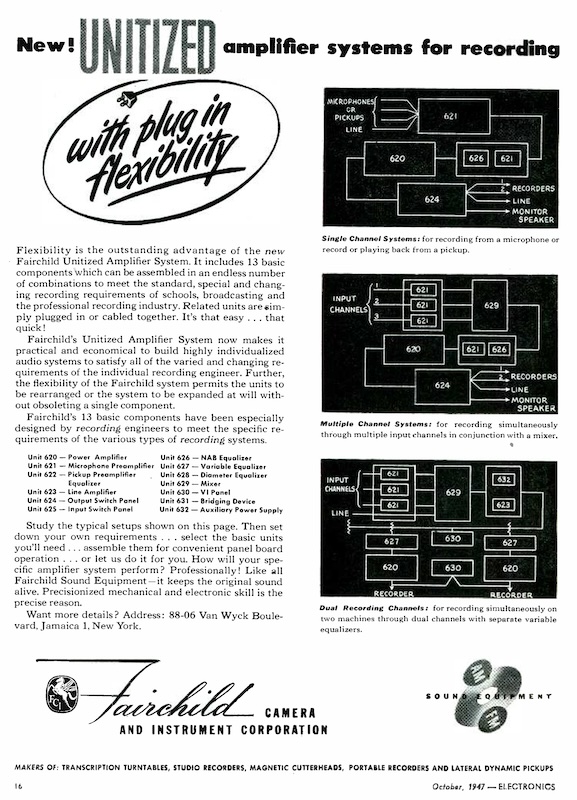
source: Fairchild Camera and Instrument Corporation Ad, Electronics, October 1947, p.16.
Electronics 1947年10月号に掲載された、Fairchild 録音ユニットシステムの広告
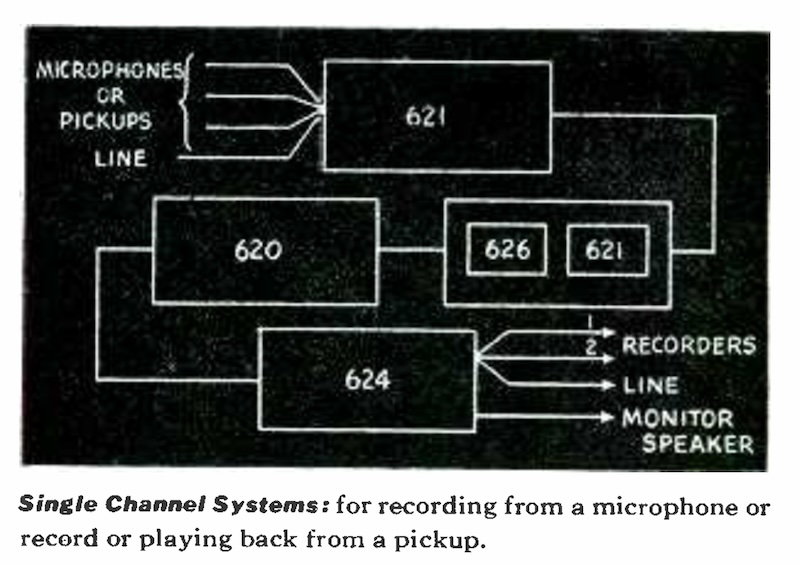
source: Fairchild Camera and Instrument Corporation Ad, Electronics, October 1947, p.16.
システム例1の拡大。マイクプリアンプからの入力が、パッシブ NAB EQ (626) および減衰分を補うプリアンプ (621) を通して、パワーアンプ (620) で増幅されディスクレコーダに送られる
Closeup of System 1: output from the microphone preamplifier is fed into the passive NAB EQ (626) as well as preamplifier (621), then into the power amplifier (62) that drives the disc recorder (cutting head)
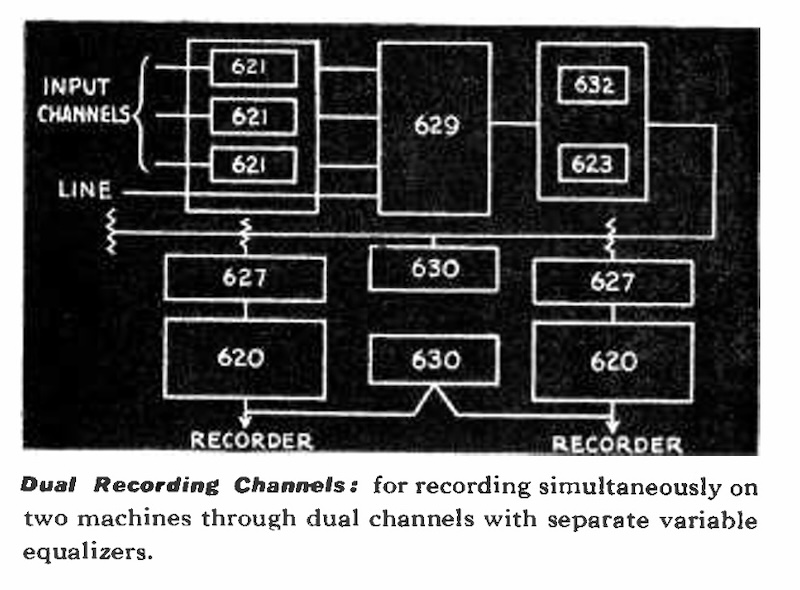
source: Fairchild Camera and Instrument Corporation Ad, Electronics, October 1947, p.16
システム例3の拡大。ディスクレコーダ直前のパワーアンプ (620) の前にあるのはアクティブ可変イコライザ (627) で、パッシブ NAB EQ (626) が描かれていない。可変イコライザを録音EQとして使う意図が読み取れる、非常に珍しい図。
Closeup of System 3: a very rare example of variable equalizer used as a recording EQ. Power amplifier (620) is fed from active variable equalizer (627), while the passive NAB EQ (626) is not there.
Nicholas Bergh さんも、メールで以下のようなコメントをくれました。
Nick-san gave me a comment on this, as shown below:
I think it is important to separate technical disc recording eq like RIAA and AES from corrective program EQ in the mastering process.
RIAA や AES といったディスク録音用EQと、マスタリングプロセスで使われる補正用プログラムEQは、区別することが重要だと考えている。
Even today in digital masters, equalization is used to correct minor issues in recordings. For example, things like rumble, muddy low-end, bright high-end, etc. Corrective program eq is always present in the mastering rooms, even if it is not used all the time.
デジタルマスターとなった現在でも、ランブル、曇った重低域、明るすぎる高域など、録音時の細々した問題を修正するために、イコライズは行われている。このような補正目的のEQは、たとえ常時使用されていないにせよ、必ずマスタリングルームには存在するものだ。
I think the only reason the 627 was discontinued was that the Pultec came in and it became the industry standard. By the early 1950s, it was rare to see any mastering room without a Pultec EQP1A or Cinema Engineering program EQ, as well as high-pass/low-pass filters from Cinema or Hycor.
私が考えるに、Fairchild 627 が生産中止になったのは、業界に Pultec が導入され、あっという間に業界標準になったからだろう。1950年代までには、どのスタジオにもほぼ間違いなく Pultec EQP-1A や Cinema Engineering (4031-B) といったプログラムEQが装備されていた。Cinema Engineering や Hycor といったメーカのハイパスフィルタ/ローパスフィルタも同様だ。
quoted from the email written by Nicholas Bergh to me (and to Tom Fine) on Aug. 8, 2023.また Nicholas さんは、1952年3月当時の Fairchild 機材の価格表も発掘し、共有してくれました。確かに、1952年当時 Fairchild 627 (Variable Equalizer) がカタログ落ちしています。一方、Fairchild 626 (NAB Equalizer) はまだラインアップに存在しています。
Also, Nick-san found the Fairchild price list (as of March 1952) in his vault, and kindly shared the photo to me. It is interesting to see that the Fairchild 627 (Variable Equalizer) is no longer in this Mar. 1952 price list, while Fairchild 626 (NAB Equalizer) still in the list.
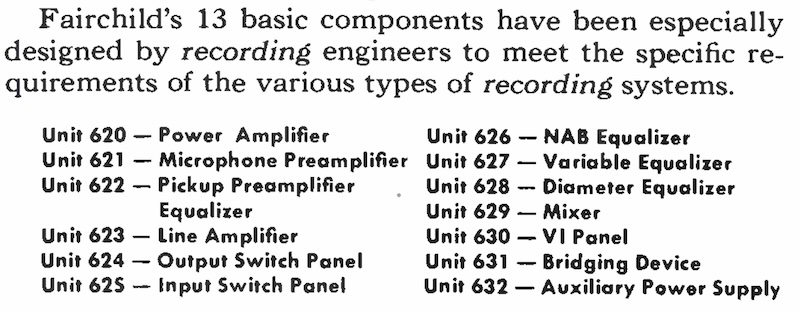
source: Fairchild Camera and Instrument Corporation Ad, Electronics, October 1947, p.16
さきほど引用した、Electronics 1947年10月号掲載の、Fairchild 録音ユニットシステムの広告の一部
13コンポーネントから構成される1947年当時の Fairchild 録音機材一覧

Fairchild Recording Equipment Corporation Price List 4-1 (March 1952)
courtesy of Mr. Nicholas Bergh.
Nick さんのコレクションにあった、1952年3月時点の Fairchild 録音機材の価格表
すでに 622 (Pickup Preamplifier Equalizer), 627 (Variable Equalizer), 628 (Diameter Equalizer) 等がカタログ落ちしている他、621 (Microphone Preamplifier), 623 (Line Amplifier) 等は生産終了と書かれている
同様に、カッティング径が内周に向かうほど高域増幅する自動イコライザ、Fairchild 628 (Diameter Equalizer) もカタログ落ちしていますが、これは1952年当時すでに Fairchild Thermo-Stylus Kit(カッター針を電熱線で温めてカッティングするホットスタイラス技術を使った製品)が 1950年に発表されており、自動イコライザが必要がなくなったから、と考えられます。(本稿 Pt. 12 セクション 12.2.1 も参照)。
Also, Fairchild 628 (Diameter Equalizer) is not in the list. It could be that the diameter equalizer was not needed anymore after the introduction of Fairchild Thermo-Stylus Kit, debuted in 1950 (see also: Pt. 12 Section 12.2.1).
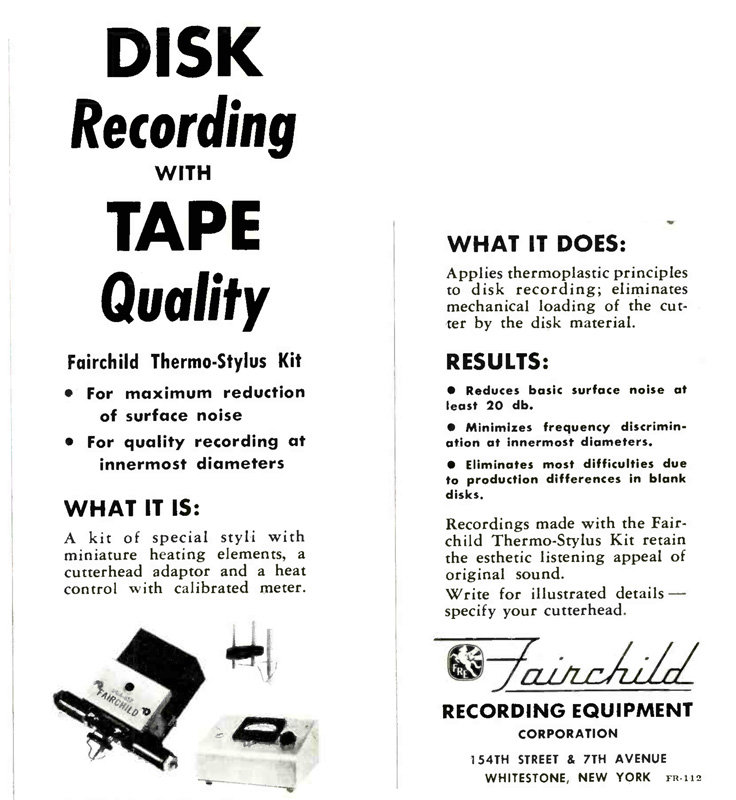
source: Audio Engineering, Vol.34, No.6, June 1950, p.3.
1950年夏に発表された、Fairchild サーモスタイラスキット
これらのことからも、可変EQを録音EQとして使うというプラクティスは、一時期の Reeves / Fairchild など非常に例外的なものであり、当時の主流はやはり、ディスク録音再生用EQにはパッシブ LRC による固定ユニットを使うものであった、と考えるのが自然でしょう。
Based on those facts, it is safe to assume that Reeves / Fairchild (in a certain period) was a rare example of using a variable (program) equalizaer also as a recording equalizer. It is natural that almost all studios could have used passive LRC fixed equalizer units for disc recording and reproducing.
残念ながら Fairchild 626 (NAB Equalizer) の現物写真は見つからなかったのですが、代わりに、当時を代表するもう1つの録音用パッシブLRCイコライザ、Cinema Engineering Type No. 4137 のカタログ写真を以下に掲載します。
Unfortunately I could not find any photos nor documentation of Fairchild 626 (NAB Equalizer), so instead here is the catalog of Cinema Engineering Type No. 4137, another passive LRC recording equalizer.
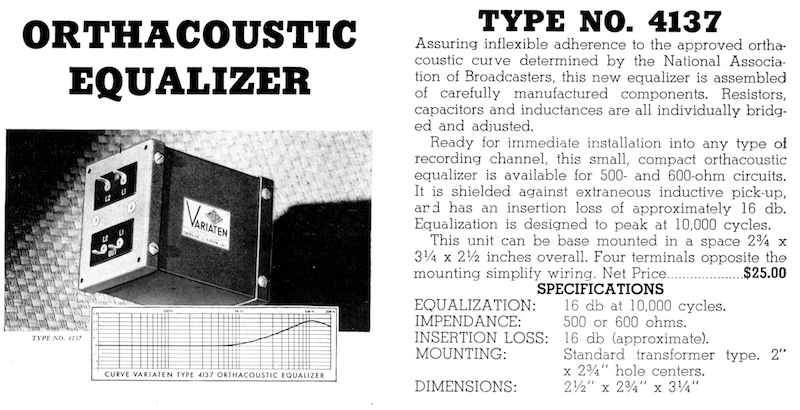
source: Cinema Engineering Company Catalog No. 10 (possibly in 1950?)
当時を代表するディスク録音用パッシブLRCイコライザ。これは Orthacoustic (NAB) 用録音EQ だが、高域プリエンファシス側のみで、ターンオーバー以下の6dBスロープは、カッターヘッドの特性で実現し、100Hz以下の重低域ターンオーバーは別回路で実現する。当時はフラットレスポンスのフィードバックカッターヘッドがまだ一般的ではなかったため。
This fixed passive LRC Equalizer was for NAB’s high frequency pre-emphasis only: 6dB droop under the turnover frequency was acomplished by the cutterhead’s response characteristic; low-bass turnover (aka “bass-shelf”) under 100Hz was added with extra circuits. Feedback cutter system with flat response was not yet common at that time.
17.5 Before and After the 1951 AES Curve, Until the RIAA Curve
続く本セクションでは、1948年6月LP登場から1951年AES再生カーブ発表を経て、RIAAカーブが策定されるまで、この混沌とした期間に、「米国における」各レーベルや各スタジオはどのように対応していたのか、過去の復習も兼ねてみていきましょう。
In this section, we are going to learn the situation of the industry, that is, how each label and studio “in the U.S.” dealt with recording curves during the years of confusion: from the advent of LP records in June 1948, through the publication of 1951 AES Standard Playback Curve, to the eve of the 1954 RIAA Standards.
17.5.1 Columbia and its studios
1948年6月18日に世界初のLPを発売した Columbia(Pt.11 および Pt.12 を参照)は、RIAA に収斂するまで、最初からずっと Columbia LP カーブ (500C-16) 一択であるのは間違いありません。社内で市販レコードのマスタリングに使用した Columbia LP カーブ用(パッシブLRC)録音イコライザは、Columbia / CBS 自社開発・製造でしょう。
Columbia label, since its premier introduction of Long Playing Microgroove records on June 18, 1948 (see: Pt.11 and Pt.12), had been very consistent using Columbia LP Curve (500C-16) from the beginning, until the adoption of the RIAA Standards. Columbia / CBS arguably developed its own LRC passive recording equalizers for recording commercial Columbia microgroove records.
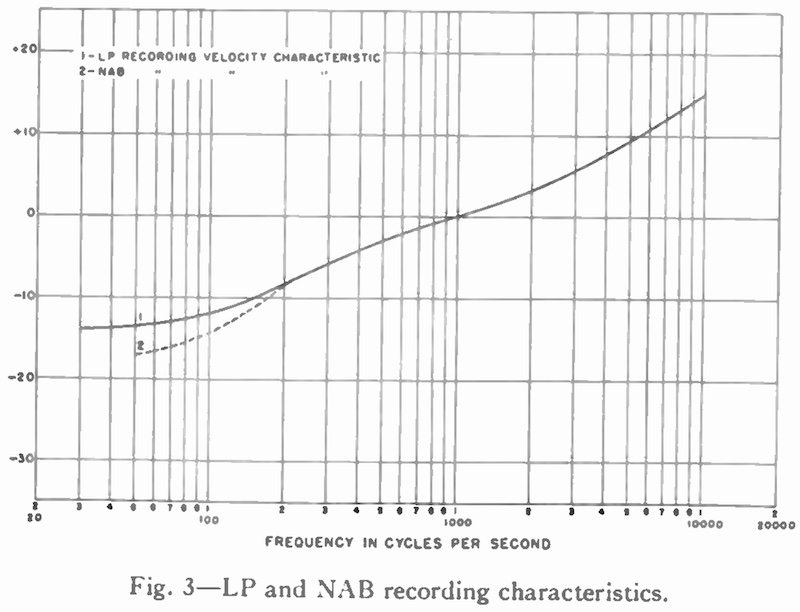
source: Proceedings of the I.R.E., August 1949, Vol.37, No.8, pp.926.
Columbia LP (1) と 1942/1949 NAB (2) の録音カーブ比較図。原論文より。
そして、本稿 Pt. 14 の回転数競争(Battle of the Speeds)でも紹介した通り、1950年に RCA Victor が LP に参入するまでは特に、多くの独立系レーベルは Columbia にカッティングおよびプレス委託をしていました。
Also, as I already learned in the Pt. 14 article, many independent labels consigned the mastering (cutting) and pressing to Columbia, especially before RCA Victor entered the LP field in 1950.
ちょうど磁気テープも普及し始めてきた時期でもあり、また、マイクログルーヴ盤のカッティング技術は大手レーベルおよび大手独立スタジオ以外に浸透していなかった時期でもあるので、Columbia にテープを送ってカッティング/プレスを委託した盤は、例外なく Columbia LP カーブでカッティングされていることになります。
Magnetic tape recorders were increasingly getting popular in the industry in the late 1940s to early 1950s; few labels and studios could cut adequate microgroove cuttings at the time. So many labels sent the recorded tapes to Columbia, and consigned the LP manufacturing to Columbia, resulting in the fact that such records arguably were cut with Columbia LP recording characteristics.
Columbia は、LPを開発した本家本元の大レーベルであり、社内で厳格に規格や技術プラクティスが定められていたはずですし、わざわざ各委託元レーベルの要望にあわせることで管理運営コストを上げるはずはないだろうからです。
It’s because that Columbia was an originator of microgroove LP records and a major label, and it surely had strict in-house standards and engineering practices. Also, it is very likely that changing recording characteristics from a label to another would lead more administration & operation costs for Columbia.
Classic Cafe さんのページや、Discogs の Columbia Recording Studios のページに詳しいですが、Columbia のマスタリングスタジオである Columbia Recording Studios は、委託プレスについて は、以下のようにマトリクスを振っていたことが知られています。つまり、これらのマトリクスが刻印された独立系レーベルは、Columbia 委託カッティング / プレスを意味し、Columbia が RIAA カーブに移行する前は Columbia LP カーブでカッティングされている、と考えるのが妥当と思われます。
According to the Classic Cafe web page as well as Columbia Recording Studios page on Discogs, it is well known that Columbia Recording Studios in its early LP years used the following matrix identifications for consigning labels — so the records from independent labels, with these matrix stamps, would mean that they were mastered (cut) and pressed at Columbia, and that they were cut with Columbia LP recording characteristics.
- TLP: 1949 custom 10-inch LPs
- XTLP: 1949 custom 12-inch LPs
- TV: 1950〜 10-inch LPs
- XTV: 1950〜 12-inch LPs
17.5.2 RCA Victor and its studios
一方、1949年1月に45回転盤を発表し(Pt.13 参照)、Columbia と「回転数競争」を繰り広げたライバル RCA Victor が、1950年〜1951年頃、ついに自社製作 LP リリースを開始します。
On the other hand, the rival RCA Victor, initially pushed its 45 rpm records (see also: Pt. 13), finally started manufacturing LPs in 1950-1951, after the “Battle of the Speeds” between Columbia settled down.
採用された録音特性は、すでに45回転で使われていたもので、「通称」 Old Orthophonic カーブ (500N-12.7) ということになります。また、RCA Victor にカッティングおよびプレスを委託した独立系レーベルも、同じ録音カーブが使われていたことになります。当時の RCA も、自社開発・製造の(パッシブLRC)録音イコライザを使っていたはずです。
Some independent labels started consigning LP manufacturing to RCA Victor. So such records were arguably mastered (cut) with “so-called” Old Orthophonic Curve (500N-12.7), which was already adopted for RCA’s 45 rpm mastering. RCA Victor definitely used the passive LRC recording equalizers developed and manufactured in-house.
なお、RCA Victor が、のちの RIAA の雛形となる録音カーブ、通称 New Orthophonic (500R-13.7) を使用し始めるのは、1952年8月頃から だとされています。
For your information, it is known that the period RCA Victor switched from (Old) Orthophonic to so-called New Orthophonic (500R-13.7) was around August 1952.
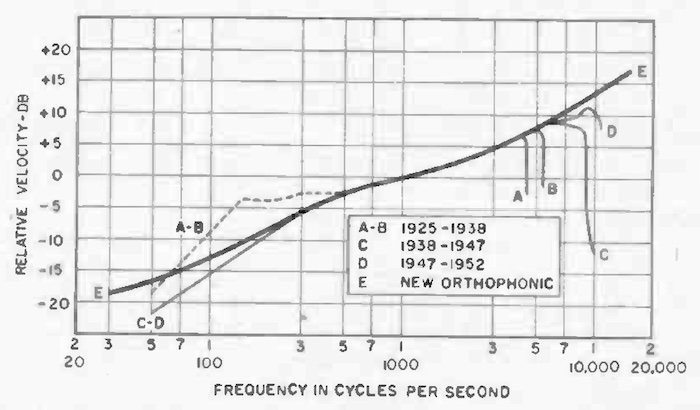
source: “Evolution of a Recording Curve”, R.C. Moyer, Audio Engineering, Vol. 37, No. 7, July 1953, p. 20.
D がいわゆる Old Orthophonic、E が New Orthophonic
この図を信用するならば、Old Orthophonic は 6〜7,000Hz より上は意図的に減衰させているようにみえる
また、重低域ターンオーバが存在していない
この New Orthophonic から、ホットスタイラス技術が組み込まれ、また周波数帯域も 30Hz〜15,000Hz に拡張されて定義されています。The Cash Box 1952年10月11日号の記事 “RCA Victor Announces New Orthophonic Sound Recordings” が、New Orthophonic に関して報じられた、私が探せた中で最も古い記事で、そこにも New Orthophonic の4つの特徴の2番目として、以下のように書かれています。
New Orthophonic employed Hot-Stylus technique, as well as the wider frequency range from 30Hz to 15,000Hz in the definition.The earliest news article I could find regarding New Orthophonic was “RCA Victor Announces New Orthophonic Sound Recordings”, in Oct. 11, 1952 issue of The Cash Box magazine, describing four principal features of New Orthophonic Sound, in which the second feature reads the following:
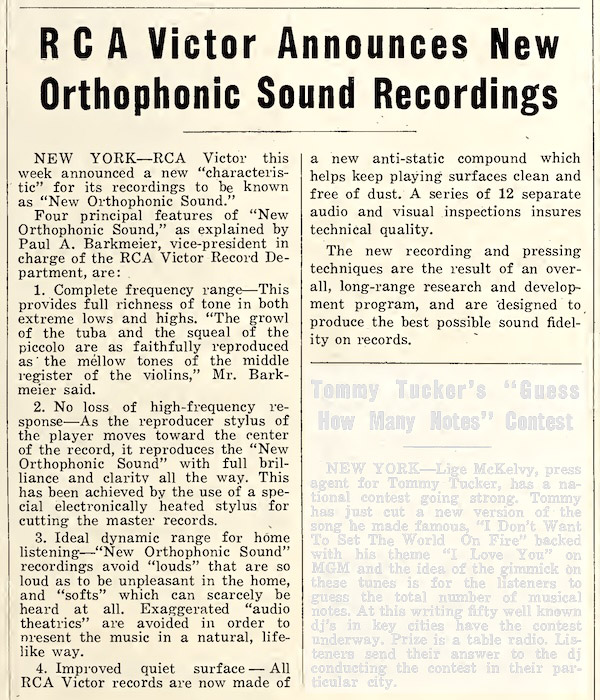
source: “RCA Victor Announces New Orthophonic Sound Recordings, The Cash Box, Oct. 11, 1952, p.21.
2, No loss of high-frequency response — As the reproducer stylus of the player moves toward the center of the record, it reproduces the “New Orthophonic Sound” with full brilliance and clarity all the way. This has been achieved by the use of a special electronically heated stylus for cutting the master records.
2. 高域レスポンスが損なわれない — プレーヤの再生針がレコードの中心に向かって移動する際でも「New Orthophonic Sound」を輝きと透明感たっぷりに再生する。これは、マスター原盤をカッティングする際、特殊な電子加熱式カッター針を採用することで実現した。
“RCA Victor Announces New Orthophonic Sound Recordings, The Cash Box, Oct. 11, 1952, p.21”また、上記と同様の情報に基づく New Orthophonic の技術概要解説が、RCA 発行の販促雑誌 Radio Age 1953年1月号 に「RCA Records Have Improved Quality」として掲載されています。執筆者は、当記事にも幾度となく登場している、RCA Victor レコード部門のチーフエンジニア H.I. Reiskind 氏です。
Also, a technical overview of the New Orthophonic, based on the same information as above, was published in the January 1953 issue of Radio Age, a promotional magazine published by RCA, as “RCA Records Have Improved Quality”. The author is Mr. H.I. Reiskind, who has already appeared several times in my entire article.
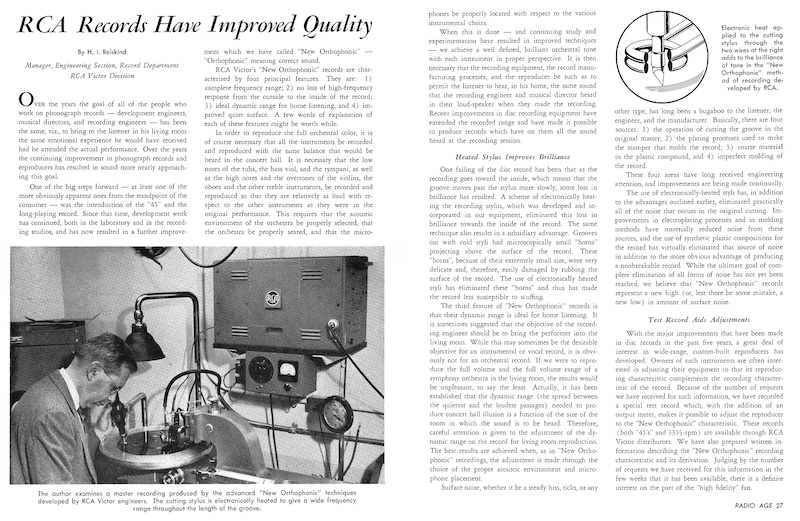
source: “RCA Records Have Improved Quality”, by H.I. Reiskind, Radio Age, January 1953, pp.26-27.
「1952年8月より New Orthophonic 採用」という言及は、Audio Engineering 誌 1953年7月号に掲載された、RCA Victor の R.C. Moyer 氏による有名な記事 “Evolution of a Recording Curve” で確認できます。ただし、下線を入れた箇所については、Peter Copeland 氏が “Manual of Analogue Sound Restoration Techniques” (2008) で「Old / New Orthophonic カーブの差分を簡略化しすぎ」と指摘していることは念の為記しておきます。
The famous article by RCA Victor’s R.C. Moyer, “Evolution of a Recording Curve”, was published on the July 1953 issue of the Audio Engineering magazine. In this article, he notes that “Use of the “New Orthophonic” curve is recommended for all RCA Victor records and records released by RCA Victor since August, 1952”. Also, please note that Peter Copeland writes in his “Manual of Analogue Sound Restoration Techniques” (2008) as “I cannot disagree with it, except” with the exception of the words I have underlined in the below sentence.
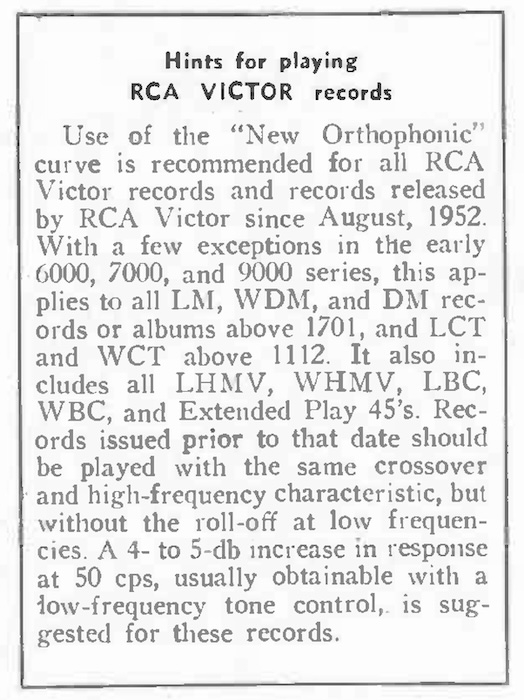
source: “Evolution of a Recording Curve”, R.C. Moyer, Audio Engineering, Vol. 37, No. 7, July 1953, pp. 19-22 & 53-54.
Use of the “New Orthophonic” curve is recommended for all RCA Victor records and records released by RCA Victor since August, 1952.
“New Orhophonic” カーブは、1952年8月以降のすべての RCA Victor レコード、および RCA Vitor によってリリースされたすべてのレコードで推奨される。
With a few exceptions in the early 6000, 7000, and 9000 series, this applies to all LM, WDM, and DM records or albums above 1701, and LCT and WCT above 1112.
6000番台初期、7000番台初期、9000番台初期など一部の例外を除き、この新カーブは、(1952年8月以降リリースの)すべての LM (LP) / WDM (45回転) / DM (78回転) 型番のレコードやアルバム(1701およびそれ以降)、そして LCT / WCT 型番(1112 およびそれ以降)に適用される。
It also includes all LHMV, WHMV, LBC, WBC, and Extended Play 45’s.
すべての LHMV / WHMV / LBC / WBC 型番にも適用されるほか、すべての Extended Play 45回転盤にも適用される。
Records issued prior to that date should be played with the same crossover and high-frequency characteristic, but without the roll-off at low frequencies.
これ以前(1952年8月より前)のレコードについては、(“New Orthophonic” と)同じクロスオーバ周波数と高域特性で再生を推奨するが、その際には重低域のロールオフを省略する必要がある。
A 4- to 5-db increase in response at 50 cps, usually obtainable with a low-frequency tone control, is suggested for these records.
これら古いレコードを(“New Orthophonic” カーブで)再生する際には、50Hz 近辺を 4〜5dB 増幅して再生することが推奨される。これは(アンプに備わっている)低域トーンコントロールで実現可能である。
“Hints for playing RCA VICTOR records”, R.C. Moyer, Audio Engineering, Vol. 37, No. 7, July 1953, p.19.多くの資料では、Old Orthophonic カーブは 500N-12.7 と書かれています(例: EQ CURVES OF OLD RECORDS)。ターンオーバー周波数 500Hz、高域プリエンファシス 12.7dB at 10,000Hz、重低域ターンオーバーなし、です。
Many research documents denote that the Old Orthophonic Curve as “500N-12.7”, with the turnover frequency at 500Hz, high frequency pre-emphasis 12.7 dB at 10,000Hz, without low-bass turnover (ex. EQ CURVES OF OLD RECORDS).
しかし同時に、Pt. 13 セクション 13.2.3 でも触れた通り、当時は RCA Victor ではまだホットスタイラス技術が使われておらず、また 7,000Hz より上はローパスフィルタで意図的に減衰させられているように見えます。
But at the same time, RCA Victor at the time did not use “Hot Stylus” technique (see: Pt. 13 Section 13.2.3), and the plotted curve suggests that the higher frequencies region above 7,000Hz was intentionally attenuated using such equipment as low-pass filters.
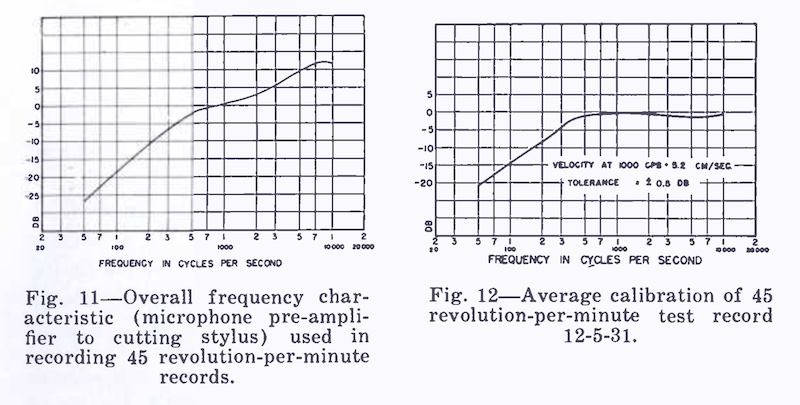
source: “RCA Review, Vol.X, No.2, June 1949”, pp.173-190.
RCA Victor 45回転盤で採用された録音特性(左)、および45回転テストレコード 12-5-31 の記録特性(右)
ですので、再生時は 500N-13.7(ターンオーバー周波数 500Hz、高域プリエンファシス 13.7dB at 10,000Hz、重低域ターンオーバーなし)でいい、という説をとる場合もあります(例: Audacity Plugins: Playback equalization for 78 rpm shellacs and early 33⅓ LPs)。とても納得感のある説です。
So some research documents claim that the appropriate reproducing characteristic would be “500N-13.7”, with turnover frequency at 500 Hz, high frequency pre-emphasis 13.7 dB at 10,000Hz, without low-bass turnover (ex. Audacity Plugins: Playback equalization for 78 rpm shellacs and early 33⅓ LPs). It’s a very convincing theory.
これらの混乱はつまり、現代のRC可変フォノEQで実現しているカーブと、当時のカーブ実現方法は必ずしも一致しておらず、結局は多くが近似値でしか表せない、ということの裏返しでもあります。
These confusions are the fipside of the fact that the curves realized by modern RC variable phono EQs do not necessarily match the way the curves were relized back then, and in the end most of them can only be represented by approximations.
Pt. 16 セクション 16.3.3 で紹介した通り、RCA においても、社内の規格や技術プラクティスが厳格に定められ運用されていました。以下に引用します。
RCA Victor had strict in-house standards and engineering practices, as we have already seen in Pt. 14 Section 16.3.3. Below is the exerpt of the Pt. 14:
本稿で何度となく登場している(多くのことを私に教えてくれた)達人エンジニア・録音技術史研究者 Nicholas Bergh さんも現物を所有しているという、RCA Victor 社内の社外秘技術ドキュメント(1940年2月発行、380ページオーバー、全15セットしか存在せず全てシリアル番号が振られて厳格に管理されていた)を仔細に読み解く機会に恵まれましたが、この中でも、世界中の RCA Victor 管轄のスタジオにおける録音特性は非常に厳格に統一管理されていたことが確認できました。
I had a privilege to read all the way through the confidential technical document of RCA Victor (published in February 1940; over 380 pages; only 15 sets made; each copy with serial number and strictly managed). Mr. Nicholas Bergh, a master engineer and a astonishing historian of recording technology, also owns an actual copy of it. Anyway, I could confirm that RCA Victor had controlled and maintained its in-house recording characteristics throughout its all studios all around the world. So at least major labels had/has adhered to their own recording EQ characteristics quite strictly.
つまり、少なくともメジャーレーベルにおいては、個々のスタジオのマスタリング (カッティング) エンジニアがその時の気分や個人的嗜好で、勝手に録音特性をいじったりすることはなかったのです。
In other words, no mastering (cutting) engineer of major labels could alter the recording characteristics according to his/her moods or his/her preferences.
self-quoted from my Pt. 16 article, Section 16.3.3幸いなことに、RCA Victor のマトリクス刻印 については、過去に素晴らしく研究が進んでいて、それぞれの刻印の意味がほぼ判明しています(例: RCA Victor Master Serial Number Codes – 1942-1980’s at Discogs Forum)。
Luckily enough, there has been a great amount of progress of identification of the RCA Victor’s Matrix Stamp Codes — the meaning of almost all the matrix stamps are already decoded (ex. RCA Victor Master Serial Number Codes – 1942-1980’s at Discogs Forum).
まず、RCA Victor 自社リリース の盤をみていきます。例えば、1950年〜1951年夏までの最初期は後年とは異なる規則でマトリクスが振られていたそうで、例えば RCA Victor LOC-1001 のマトリクスは「E1 LVC 69」「E1 LVC 70」、これを読み解くと「E1」=「1951年」、「L」=「33 1/3回転 LP」、「V」=「Victor ポピュラー」、「C」=「12インチ」となります。
Let’s take a look at RCA Victor’s own releases — early releases (1950 to Summer 1951) used a different matrix scheme than the famous one. For example, RCA Victor LOC-1001 has the stamped matrices “E1 LVC 69” and “E1 LVC 70” on each side. This means: “E1” = “1951”; “L” = “33 ⅓ rpm LP”; “V” = “Victor (Popular)”; and “C” = “12-inch”.
その後はよく知られた規則となり、例えば RCA Victor Red Seal LM-1205 のマトリクスは E1RP 0309 / E1RP 0310 です。これは読み解くと「E1」=「1951年」、「R」=「RCA Red Seal (クラシック)」、「P」=「12インチ 33 1/3回転 マイクログルーヴ」となります。
Later ones uses the famous scheme. RCA Victor Red Seal LM-1205, for example, has the stamped matrices E1RP 0309 / E1RP 0310, which means: “E1” = “1951”; “R” = “RCA Red Seal (Classical)”; and “P” = “33 ⅓ rpm 12-inch LP”.
そして、他レーベルからの委託プレス の場合も、同様の規則でマトリクスが振られています。Urania URLP-7084 という LP の E2KP-9243 / E2KP-9244 というマトリクスが意味するのは、「E2」=「1952年」、「K」=「カスタム(委託)プレス、かつ、テープが送付されてきた(マスタリング / カッティングは RCA Victor で行われた)」、「P」=「12インチ 33 1/3回転 マイクログルーヴ」と読み解ける、といった具合です。
Consigned releases for independent labels share the same matrix scheme: Urania URLP-7084 has the matrices E2KP-9243 / E2KP-9244, which can be decoded as: “E2” = “1952”; “K” = “Custom (consigned) press, tape furnished to RCA (mastering /cutting was done at RCA Victor)”; and “P” = “33 ⅓ rpm 12-inch LP”.
3文字目の「K」が「Q」になっていれば、「カスタム(委託)プレス、かつ、ラッカー盤が送付されてきた(マスタリング / カッティングは録音スタジオ側で行われた)」という意味になります。しかし、この「Q」が確認できるのはほとんどが78回転盤時代に限られ、LP 時代では滅多に見かけないので、RCA Victor に製造委託していた独立レーベルのほとんどは、テープを送付し、RCA Victor でカッティングしてもらっていたことになります。(のちほど、数少ない LP の「Q」の例を紹介します)
If the third letter “K” was replaced with “Q”, it would mean “Custom (consigned) press, lacquer furnished to RCA (mastering / cutting was done at the recording studio outside RCA Victor)”. But few “Q” matrix can be found during the LP years, which means many independent labels sent the recorded tapes to RCA Victor, to get them mastered and pressed at RCA Victor. (Later I will show you some rare examples of “Q” in the LP years)
ちなみに、1952年に Urania レーベルが RCA Victor にカッティング / プレス委託し、1953年春に発売された、この URLP-7084 は、“High Fidelity Demonstration Record” という LP で、裏ジャケには New Orthophonic 録音カーブのグラフが掲載されており、解説には “As can be seen from the curve, the turnover frequency is 500 cycles and the treble de-emphasis required at 10 kc is 13.7 db.”(ターンオーバー周波数 500Hz、高域デエンファシスは 10,000Hz で 13.7dB)と書かれています。重低域ターンオーバーについては言及がありませんが、特性グラフをみるとしっかり存在しています。
By the way, this LP (URLP-7084 from Urania label), mastered by RCA Victor in 1952, and was released in the spring of 1953, is entitled “High Fidelity Demonstration Record”. The back cover have the frequency graph of the recording characteristics used for this particular record, which looks exactly as New Orthophonic (which would become the RIAA Standards next year); liner-notes read as: “As can be seen from the curve, the turnover frequency is 500 cycles and the treble de-emphasis required at 10 kc is 13.7 db.”, which is the same characteristics as that of New Orthophonic. Although the low-bass turnover (bass-shelf) was mentioned in the liner-notes, it surely exists in the frequency graph.
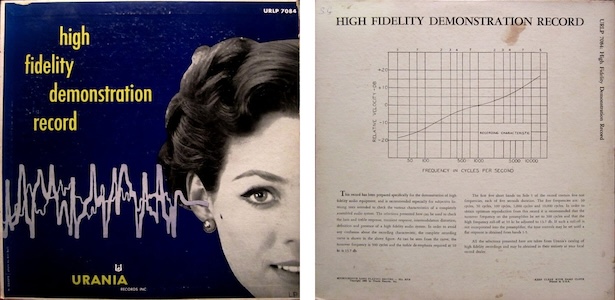
(photo from Discogs entry)
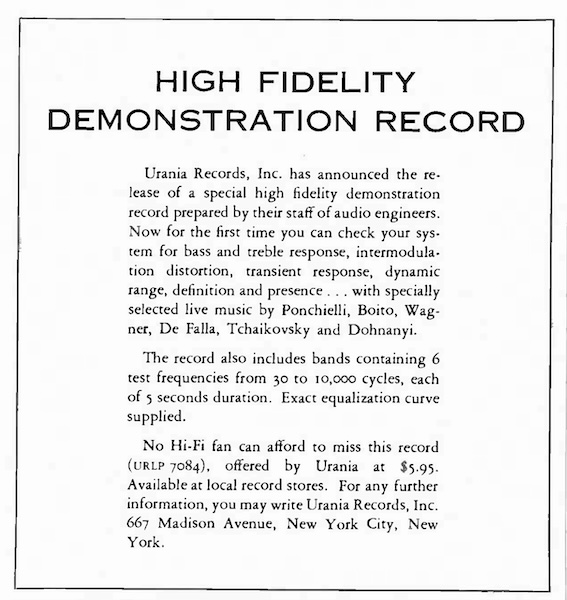
source: Urania Records Ad, High Fidelity, Vol. 3, No. 2, May-June 1953, p. 80.
High Fidelity 誌1953年5/6月号に掲載された、Urania URLP-7084 の紹介コーナー
さらには、同じ URLP-7084 でも、セカンドプレスでは裏ジャケ表記が微妙に変更されており、収録内容が追記されている他、録音周波数特性グラフが 17,000Hz まで伸ばされていること、そして 500Hz / 13.7dB の説明の直後に (R.I.A.A.) と追記されており、明らかに 1954年 RIAA 規格策定後の製造であることがみてとれます。また、両者ともA面のマトリクスが E2 KP 9243 1C と、同じスタンパーから製造されていることが確認できますので、前者も New Orthophonic = RIAA であることが分かります。
Interestingly, the second variation of the URLP-7084 has slightly different back cover, with a slightly modified frequency graph and description. The frequency graph is expanded to 17,000Hz, while in the first variation the graph was drawn up to 15,000Hz. Also, the description has additional phrase (R.I.A.A.) — which means this second variation was manufactured AFTER the 1954 RIAA Standards was formulated and published. The first issue and the second issue of this LP shares the same matrix E2 KP 9243 1C, which means that both copies share the same recording / reproducing characteristics: New Orthophonic = RIAA.
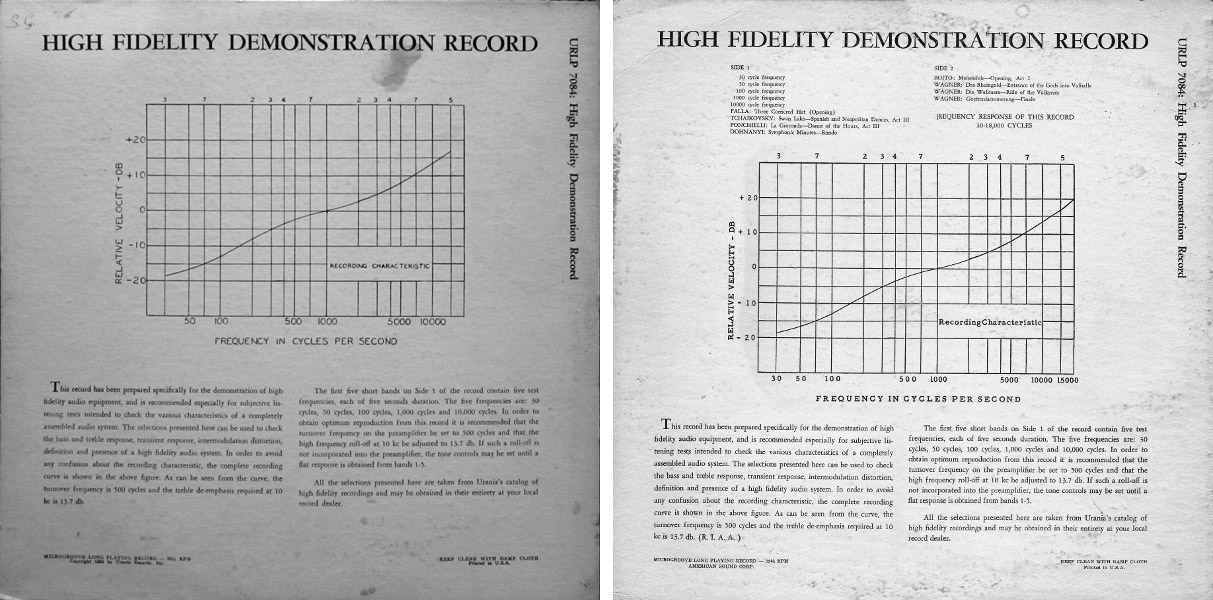
Back covers of URLP-7084
Left: 1st pressing (photo from Discogs entry)
Right: 2nd pressing (photo from Discogs entry)
URLP-7084の裏ジャケ。左が1stジャケ、右が2ndジャケ。)
上述の通り、RCA Victor が、のちの RIAA の雛形となる録音カーブ、通称 New Orthophonic (500R-13.7) を使用し始めるのは、1952年8月頃から だとされていますので、1953年にリリースされた、上の URLP-7084 が、New Orthophonic カーブ準拠なのもうなずけますね。
As previously noted above, it is known that the period RCA Victor switched from (Old) Orthophonic to so-called New Orthophonic (500R-13.7 was around August 1952. So it really makes sense that Urania URLP-7084 (relased in 1953) was mastered using the New Orthophonic curve.
Urania の一部の RCA Victor プレス盤は AES 標準再生カーブにあわせた録音カーブである、とする説もあるようです。例えば “Audacity Plugins: Playback equalization for 78 rpm shellacs and early 33⅓ LPs” に掲載されている説などです。なお、この Audacity Plugins ページでの記載は、複数存在する説をあえて併記している(最後は読者の耳に委ねる)ことに注意してください。
There is another research theory that some Urania LPs (pressed by RCA Victor) should be with the recording curve for the AES Standard Playback Curve (ex. “Audacity Plugins: Playback equalization for 78 rpm shellacs and early 33⅓ LPs”). Please note that the Audacity’s page also notes as: “in case that sources did not agree on one EQ curve, their different opinions are listed and you will have to trust your ears”.
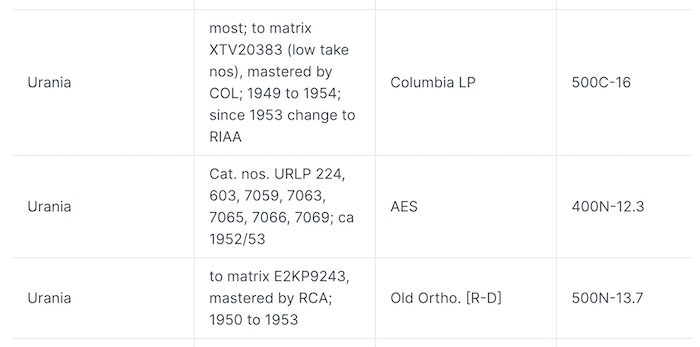
screenshot of “Audacity Plugins: Playback equalization for 78 rpm shellacs and early 33⅓ LPs” entries on Urania releases
確かに、URLP-7074 や URLP-7075 など、RCA Victor 委託マスタリング / プレスの初期の盤では、ジャケット裏に “For optimum reproduction with magnetic cartridges, standard AES equalization should be used with this recording.” と記載があるのが確認できます。以下は URLP-7074 の裏ジャケ下です。
As a matter of fact, back covers of some RCA-mastered LPs such as URLP-7074 and URLP-7075 has the note as: “For optimum reproduction with magnetic cartridges, standard AES equalization should be used with this recording.”. Below is the scan of the bottom back cover of the URLP-7074 LP.

“For optimum reproduction with magnetic cartridges, standard AES equalization should be used with this recording”
photo from: an eBay listing of URLP-7074.
しかし、さきほど上でみた、New Orthophonic でマスタリングされた URLP-7084 のマトリクス番号は 9243 で、この URLP-7074 のマトリクス番号は 9280 です。つまり、URLP-7074 の方が URLP-7084 よりあとにマスタリングされた可能性が非常に高いことになります。
However, the URLP-7084 (which is definitely mastered using New Orthophonic recording characteristics) has the matrix number 9243, while the URLP-7074 (the LP in question) has 9280 — this would highly possibly mean that URLP-7074 was mastered after URLP-7084.
よって、「当時は RIAA 制定前だった」「New Orthophonic とは元来カーブの名前ではなく、カーブを含めた RCA Victor のキャッチフレーズだった」「Columbia LP / NAB カーブで再生するよりも(当時の再生用統一カーブとして提唱されていた)AES 標準再生カーブで再生する方が、より意図した音になると制作者側が考えた」といったあたりが真実ではないかと考えます。
So my hypothesis here is: “it was still before the formulation of the RIAA Standards at the time”; “New Orthophonic was not a name for the recording / reproducing characteristics, but just a slogan used for RCA Victor LPs at the time”; “the producer of Urania LPs (and the writer of the liner-notes) thought it would be much better to get it reproduced using the AES Playback Characteristics (that was proposed for unified reproducing characteristics at the time) than using Columbia LP / NAB curve”, etc.
当方の仮説は セクション 17.7.10 もあわせてご覧ください。
Please see also Section 17.7.10 for my thoughts behind this hypothesis.
以上のことから、RCA Victor でマスタリング(カッティング)された盤の録音カーブは、独立系レーベルの RCA Victor 委託プレスであっても、カッティングされた当時の RCA Victor のものに準拠することになります。すなわち、1952年8月より前は Old Orthophonic カーブ で、1952年8月以降は New Orthophonic カーブ、ということです。
So, all of the above information might strongly suggest that, any consigned LP records that was mastered (cut) by RCA Victor used the recording characteristics RCA used at the time: that is to say, (Old) Orthophonic curve before August 1952, and New Orthophonic curve since August 1952.
17.5.3 Capitol and its studios
一方、1949年4月、RCA Victor の45回転盤リリースとほぼ同時に45回転盤を開始した Capitol は、当初から RCA Victor に製造委託したり技術協力を仰いだり、RCA Victor から James Bayless 氏を引き抜き Scranton 工場と Los Angeles 工場の責任者として迎え入れたりしていました(Pt. 14 セクション 14.1.2 および Pt. 14 セクション 14.1.12 を参照)。
Another major (or semi-major) label Capitol started releasing 45 rpms along with the originator RCA Victor in April 1949. Also, Capitol initially consigned 45 rpm manufacturing to RCA Victor, then asked for technical collaboration; also, Capitol head-hunted James Bayless from RCA Victor to appoint him as the head of the Capitol’s own Scranton / Los Angeles plants (see: Pt. 14 Section 14.1.2 as well as Pt. 14 Section 14.1.12).
ですので、Capitol 自社マスタリングスタジオでのカッティングは、当時の RCA Victor と同じ Old Orthophonic (500N-12.7) か、それに近いカーブ(例えば AES 標準再生カーブに呼応する録音カーブ)が選定されていたと考えられます。パッシブLRCイコライザなのか、アクティブRCイコライザなのか、は分かりません。
These facts strongly suggest that Capitol arguably adopted Old Orthophonic (500N-12.7) or similar curve (such as the recording curve corresponding to the AES Standard Playback Curve). Not sure Capitol used passive LRC equalizers or active RC equalizers, though.
一次資料が見つかっていない(または公になっていない)ので聴感による仮説のひとつなのでしょうが、一説には Capitol では 400N-12.7 というカーブを採用していた、とする識者もいるようです(例: EQ CURVES OF OLD RECORDS)。これは、AES 標準再生カーブ (400N-12) のターンオーバーと、Old Orthophonic カーブ (500N-12.7) のプリエンファシスの折衷案的にも見えますね。いずれにせよ、AES 再生カーブ (400N-12) でほとんど問題がないでしょう。
Although no primary source is known to exist (or made public), some researchers point out the hypothesis that Capitol might have used its unique 400N-12.7 curve (ex. EQ CURVES OF OLD RECORDS), which looks like a compromise between the AES curve (400N-12) and RCA Victor’s (Old) Orthophonic curve (500N-12.7). Anyway, AES playback curve (400N-12) would fit nicely for Capitol LPs at that time.
ちなみに、Capitol の有名な Melrose Studio は 1949年1月10日オープン、録音スタジオとマスタリング設備(カッティングレース)を備えていました。もともと NBC Radio のスタジオ だった場所です。このスタジオセットアップ作業は、Roy DuNann 氏と Warren Birkenhead 氏という Capitol を代表する2人のエンジニアがその任にあたりました。
By the way, Capitol’s famous Merlose Studio was established on January 10, 1949. The studio, originally an NBC Radio studio, had recording studios and mastering equipment (cutting lathes etc.). The setup for the studio was done by two Capitol engineers at the time: Roy DuNann and Warren Birkenhead.
Capitol had been using independent studios, but by 1947 they were selling a lot of records, and they wanted their own. They needed some technical types to outfit the new studio and set it up for them, and Roy and his friend Warren Birkenhead were drafted.
Capitol は独立スタジオを使用していたが、1947年までに大量のレコードを販売するようになり、自社のスタジオ設立が急務となった。Capitol は新スタジオの設備およびそのセットアップにエンジニアを必要としており、Roy (DuNann) と彼の友人である Warren (Birkenhead) が起用された。
(…snip…) Roy and Warren set up four lathes for lacquer mastering in Capitol’s new studio on Melrose Boulevard in Hollywood. They designed an innovative system connecting two lathes with a 12″ aluminum bar, which could record two originals simultaneously. Roy remembers that, even before they were finished setting up the studio, Capitol acquired an Ampex single-track tape recorder, serial number 3.
(…中略…) Roy と Warren は、Hollywood メルローズ大通りの Capitol 新スタジオに4台のカッティングレースをセットアップし、ラッカーマスタリング(カッティング)ができるようにした。またふたりは、2台のカッティングレースを12インチのアルミニウム製のバーで連結した革新的なシステムを設計し、これにより同一ラッカーを2枚同時にカッティングできるようにした。Roy の記憶では、まだスタジオのセットアップが完了する前に、Capitol は Ampex のシングルトラックテープレコーダ(シリアル番号3番)を確保していたとのことである。
“The Search for Roy DuNann, Page 2”, Stereophile, by Thomas Conrad, first published Apr. 2, 2002なお、Pultec EQP-1 のエピソードで登場した、Clair Krepps 氏は、戦時中に上官だった Capitol のチーフエンジニア Warren Birkenhead 氏に請われ、Oliver Summerlin 中尉と共に1946年に Capitol Recording New York マスタリングスタジオのセットアップに関わりました。
By the way, Clair Krepps (whom I previously mentioned in the Pultec EQP-1 episode) was hired by Warren Birkenhead (Capitol’s chief engineer at the time), and Krepps (along with Lieutenant Oliver Summerlin) would be responsible for building the Capitol Records New York mastering studio in 1946 (Krepps and Summerlin was under Birkenhead’s command during the war).
Nevertheless, in 1946, Krepps and Summerlin set up Capitol’s first New York studio, initially just a mastering room with a Scully recording lathe, amplifiers, and speakers, located in an office space on Broadway and Fifty-Seventh Street. Capitol in Los Angeles sent recordings to New York to be copied or remastered and then shipped to the pressing plant in Scranton, Pennsylvania.
それ(電子工学の幅広い知識はあったもののレコード制作・製造経験は全くなかった)にも関わらず、1946年に、Krepps と Summerlin は Capitol の初となる New York スタジオのセットアップを行った。ブロードウェイ57番街のそのスタジオは、当初は Scully カッティングレース、アンプ、スピーカを備えたマスタリングスタジオであった。ロサンゼルスの Capitol は、ニューヨーク(のスタジオ)に音源を送り、コピーしたりリマスターした上で、ペンシルバニア州の Scranton プレス工場に送った。
“Chasing Sound: Technology, Culture, and the Art of Recording from Edison to the LP”, p.85, by Susan Scmidt Horning, The John Hopkins University Press, 2013.もっとも興味深いのは、1952年8月に RCA Victor が New Orthophonic カーブを導入したのち、自社カッティング(つまり、委託カッティング / プレス以外)のレーベルで、もっとも早くこの New Orthophonic カーブ(正確には 1953 NARTB カーブ)を採用したのが Capitol だった、という点です。1953年秋頃までには New Orthophonic とほぼ同等のカーブに移行していることは、Capitol SAL-9020 “Full Dimensional Sound — A Study in High Fidelity” というボックスアルバムで確認できます。
The most interesting fact is that, among the labels that did in-house mastering (i.e. that did not outsourced mastering to larger labels or independent plants), Capitol was the earliest to adopt New Orthophonic (or more precisely, 1953 NARTB) curve, after the adoption of New Orthophinic by RCA Victor in August 1952. The fact that Capitol’s switch to New Orthophonic (or very similar) curve until the Fall of 1953 can be confirmed with the box LP album, Capitol SAL-9020 “Full Dimensional Sound — A Study in High Fidelity”.
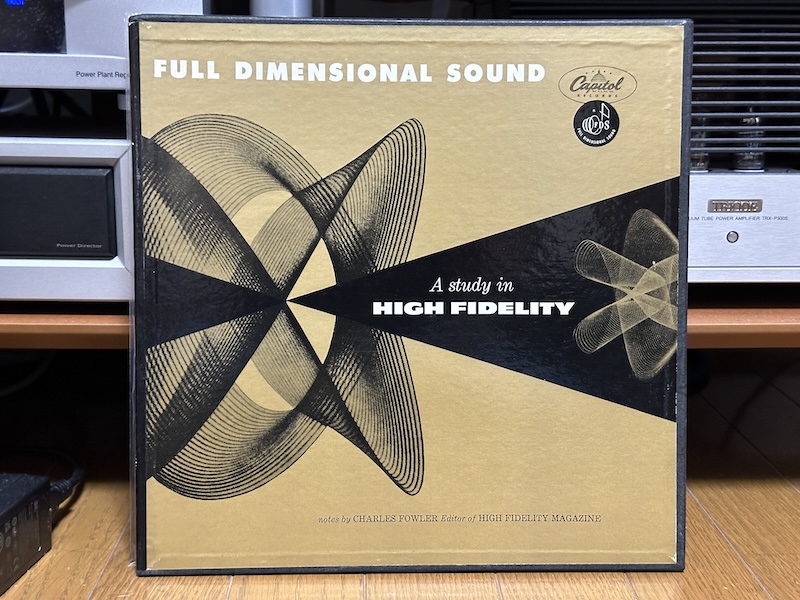
同アルバムの広告が High Fidelity 誌 1953年11/12月号の裏表紙 や The Billboard 1953年10月24日号 p.27 に掲載されています。つまり、1953年秋、おそらくは1953年9〜10月頃にはリリースされていたと考えられます。
Also, the back cover of the Nov./Dec. 1953 issue of High Fidelity magazine as well as The Billboard’s Oct. 24, 1953 issue p.27 have the advertisement of this Capitol SAL-9020 itself. These prove that it was already released in the Fall of 1953, probably in September or October, 1953.
また、The Billboard 1953年10月17日号 p.20 の記事 “Capitol Bases Oct., Nov. Merchandising on Hi-Fi” 中でこのアルバムに触れられているほか、Audio Engineering 誌 1953年12月号 p.44 のレコードレビューでこのアルバムが取り上げられているのが確認できます。
This album was featured in the article “Capitol Bases Oct., Nov. Merchandising on Hi-Fi” in The Billboard Oct. 17, 1953 issue, p.20, as well as in the “Record Revue”, p.44, Dec. 1953 issue of Audio Engineering magazine.

source: Record Revue by Edward Tatnall Canby, Audio Engineering, Vol. 37, No. 12, December 1953, p.44.
Audio Engineering 誌 1953年12月号の Record Revue で取り上げられたレビュー記事
Those who have attended recent Audio Fairs will know all about this album, which was distributed to practically every exhibitor and immediately put to use. (There was also a “trade” hi-fi record with announcer, but that one is not on public sale.)
最近開催されたオーディオフェアに参加された方々であれば、このアルバムのことはご存知であろう。本アルバムは、ほぼ全ての出典ブースに配布され、デモ再生されていたからだ。(アナウンス入りの販促用ハイファイレコードも同じく再生されていたが、こちらは一般向けの販売は行われていない)
An excellent job and to my knowledge the first of its type from a major record company’s catalogue. The material is predominantly classical music on once side, popular on the other, but the range is greater than this implies — and only goes to show, as a matter of fact, how Hi-Fi has levelled out the old differences between those arbitrary categories.
優れたアルバムで、私の知る限り、メジャーレーベルのカタログにこのタイプのアルバムがラインアップされるのは初めてである。片面はほぼ全てがクラシック音源で占められ、もう片面はポピュラー音楽が収録されているが、その(音楽性の)幅は想像以上に広い。また実際、音楽カテゴリの恣意的な違い、という古い考え方が、Hi-Fi 技術によっていかに平準化されたか、を示していると言える。
From Glazounoff to Stan Kenton, Bloch to Foghorn Boogie, this disc illustrates most of the major points of Hi-Fi sound and its interest for addicts will be as great as it is transient — what with isolated single-movement exerpts — to the music lover, popular or classical. Try the Studies in Percussion, parts 1 and 2, first. Cowbells, gongs, drums, etc.
グラズノフからスタン・ケントンまで、ブロッホからフォグホーン・ブギまで、本アルバムは Hi-Fi サウンドの主要ポイントをほぼ提示しており、オーディオ愛好家にとっては大いに興味をひくところであろう。単楽章の抜粋などで構成されているため、音楽愛好家にとっては刹那的なアルバムではある。まずは(パーカッション奏者 Hal Rees による)「Studies in Percussion Part 1」および「Part 2」をお試しあれ。カウベル、ゴング、ドラムスなど(聴き応え満点である)。
The surfaces are exceptionally quiet (and other Capitols have been relatively noisy at times). A significant innovation is the soft plastic envelope for the record, which has enough overlap to allow a fold that is dustproof. Not practical for standard records probably (it won’t fit into an ordinary record sleeve), but a step in advance nevertheless.
レコード盤のサーフェスは非常に静粛である(Capitol の他の盤は比較的ノイズが多いが)。注目すべきイノベーションは、レコードが入れられたソフトプラスチックのスリーヴで、取り出し口部分を折ることで中にホコリが入らないようにできる。ただし(このアルバムはボックスセットだが)通常のレコード向けではないだろう、おそらく通常のスリーヴ(レコードジャケット)の中に収納できない。それでも一歩前進ではある。
Enthusiastic notes, at length, by Charles Fowler. No vocal explanations on the disc itself.
Charles Fowler 氏による長文のマニア向け解説が同梱されている。レコードの音源自体にはヴォーカルによる解説は収録されていない。
“Record Revue”, Edward Tatnall Canby, Audio Engineering, Vol. 37, No. 12, December 1953, p.44.このアルバムは幸い手元に所有しています。上で引用したレビュー記事内に書かれていた、ソフトプラスチック製の大型スリーヴも確認できます。
I have (luckily) own the copy of this album. You can see the “soft plastic envelope for the record” (as Edward Tatnall Canby describes) on the photo below.
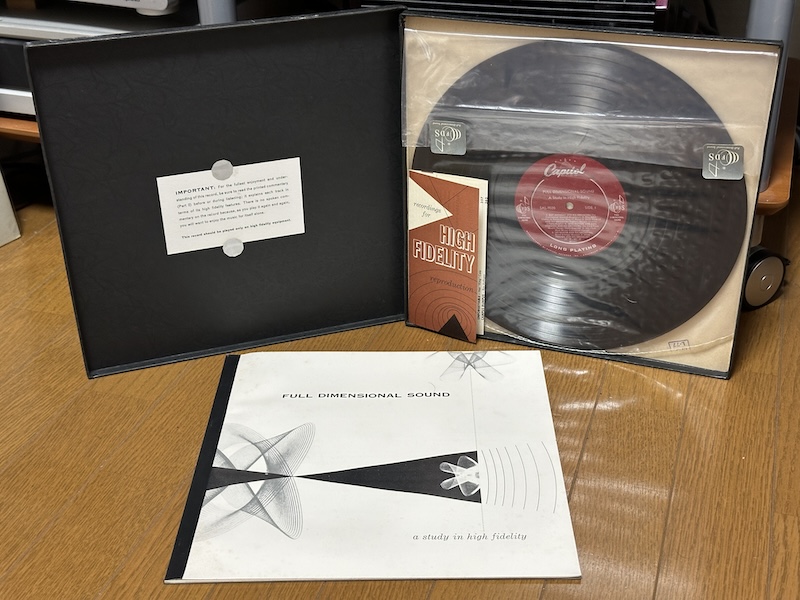
また、添付のブックレットには、High Fidelity 誌の編集長 Charles Fowler 氏による長文技術解説のほか、再生特性カーブと周波数特性表が掲載されています。高域デエンファシスが 13.7dB ではなく 13.5dB と書かれていますが、グラフは 15,000Hz まで定義されており、同時に重低域ターンオーバーも存在していることから分かる通り、全体の特徴はまごうことなき 1952 New Orthophonic = 1953 NARTB = 1954 改訂 AES = 1954 RIAA そのものです。
Enclosed is the booklet, with enthusiastic notes written by Charles Fowler, editor of the High Fidelity magazine at the time. Also, the frequency graph of the playback curve (for this LP) as well as a tabulation of several points along the curve is shown in the booklet. Although the relative response at 10,000Hz is noted as “-13.5dB”, not New Orthophonic’s “-13.7dB”, the overall characteristic is the playback curve for 1952 New Orthophonic = 1953 NARTB = 1954 new AES = 1954 RIAA — no doubt about it. The low-bass turnover (bass-shelf) is also there.
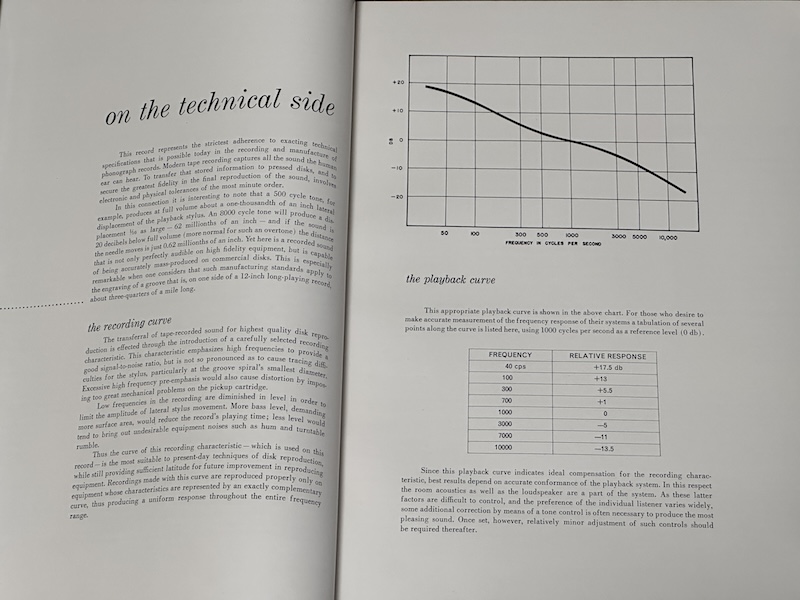
This record represents the strictest adherence to exacting technical specification that is possible today in the recording and manufacture of phonograph records. Modern tape recording captures all the sound the human ear can hear. To transfer that stored information to pressed disks, and to secure the greatest fidelity in the final reproduction of the sound, involves electronic and physical tolerances of the most minute order. (…snip…)
本盤は、レコードの録音および製造において可能となった、最も厳格な技術仕様に忠実に作られたものである。近年のテープ録音は、人間の可聴帯域すべての音をとらえている。その保存された情報をレコード盤にプレスすることで転送し、最終的な再生において最大の忠実度を確保するためには、電気的・物理的な公差を非常に小さくすることが必要である。(…中略…)
the recording curve
録音カーブ
The transferral of tape-recorded sound for highest quality disk reproduction is effected throught the introduction of a carefully selected recording characteristic. This characteristic emphasizes high frequencies to provide a good signal-to-noise ratio, but it is not pronounced as to cause tracing difficulties for the stylus, particularly at the groove spiral’s smallest diameter. Excessive high frequency pre-emphasis would also cause distortion by imposing too great mechanical problems on the pickup cartridge.
最高品質でのレコード再生を目的として、テープ音源をディスクに転送する際、慎重に選択された録音特性を導入することにより効果的となる。この録音特性は、良好なS/N比を提供するために高周波帯域を強調するものだが、特にディスク内周においてスタイラスのトレースに困難をもたらすほど顕著なものではない。また、過度の高域プリエンファシスは、ピックアップカートリッジに機械的な問題が発生しやすく、歪みの原因となる。
(…snip…) Thus the curve of this recording characteristic — which is used on this record — is the most suitable to present-day techniques of disk reproduction, while still providing sufficient latitude for future improvement in reproducing equipment. Recording made with this curve are reproduced properly only on equipment whose characteristics are represented by an exactly complementary curve, thus producing a uniform response throughout the entire frequency range.
(…中略…) したがって、このレコードに使われている録音特性のカーブは、現在のディスク再生技術に最も適したものであると同時に、将来の再生機器改良に十分な余裕を与えるものでもある。この録音カーブで作られたレコードは、呼応する(録音カーブを打ち消す)再生カーブを備えた機器でのみ正しく再生され、その結果、前周波数帯域にわたって均一な応答が得られることとなる。
the playback curve
再生カーブ
(…snip…) Since this playback curve indicates ideal compensation for the recording characteristic, best result on accurate conformance of the playback system. In this respect the room acoustics as well as the loudspeaker are a part of the system. As these latter factors are difficult to control, and the preference of the individual listener varies widely, some additional correction by means of a tone control is often necessary to produce the most pleasing sound. Once set, however, relatively minor adjustment of such controls should be required thereafter.
(…中略…) この再生カーブは、録音特性に対する理想的な補正であり、再生システムが(この再生カーブに)正確に適合することで、最良の結果をもたらす。この点では、室内音響(ルームアコースティック)やラウドスピーカの特性も再生システムの一部である。この後者2つの要因は制御が難しく、またリスナー個々人の好みも大きく異なるため、最も心地よい音を再生するには、トーンコントロールによる追加補正が必要になることが多い。しかし、一度設定しさえすれば、その後は比較的軽微な調整で済むはずである。
Technical notes written by Charles Fowler, Capitol SAL-9020 (1953)「この録音特性は、良好なS/N比を提供するために高周波帯域を強調するものだが、特にディスク内周においてスタイラスのトレースに困難をもたらすほど顕著なものではない。」という箇所の記述が、「高域増幅しすぎると歪みが発生してしまう」、つまり、NAB カーブや Columbia LP カーブの高域増幅(+16dB at 10,000Hz / 100μs プリエンファシス)では内周へ近づくにつれて歪みが増大するため、より抑えめの高域増幅(約+13.5dB at 10,000Hz / 75μs プリエンファシス)にしている、という説明と読み解くのが正しいでしょう。
The paragraph “this characteristic emphasizes high frequencies to provide a good signal-to-noise ratio, but it is not pronounced as to cause tracing difficulties for the stylus, particularly at the groove spiral’s smallest diameter” would be with the problem (that excessive high frequency pre-emphasis would result in distortion and other defects) in mind. So we can assume that Capitol chose lesser pre-emphasis (+13.5dB at 10,000Hz / 75μs) rather than NAB or Columbia LP curves (+16dB at 10,000Hz / 100μs), because of that reason.
そして、本稿 Pt. 10 (1949 NAB 規格策定の歴史)、および Pt. 15 (「ハイ・フィデリティ」という用語の歴史) などでも紹介した通り、高域プリエンファシスを弱めるべき、という議論の延長線上で新カーブを選定した(= RCA Victor の New Orthophonic とほぼ同じ特性のカーブを採用した)ことが伺えます。そういう意味では、Capitol は Columbia 陣営ではなく RCA Victor 陣営といって差し支えないでしょう。
Also, the discussion of excessive high-frequency pre-emphasis had been there since the 1940s, as we already have seen in Pt. 10 (history of 1949 NAB Standards) and in Pt. 15 (history of the term “High Fidelity”). In that sense, it is safe to say that Capitol was in the RCA Victor camp, rather than in the Columbia’s camp.
17.5.4 Reeves Sound Studios (Mercury, etc.)
そして、さきほど セクション 17.3 で見てきたように、大手独立系スタジオである Reeves Sound Studios では1949年LP製造開始当初は、NAB カーブ(Columbia LP にかなり近い)を採用していた可能性があります。そして遅くとも 1951年に AES 再生カーブが発表される前後(恐らくは AES 再生カーブの議論が始まる 1950年夏頃?)から、AES 再生カーブに対応する録音カーブを採用していました。
As we have already learned in the Section 17.3, one of the largest independent studios, Reeves Sound Studios could have used the NAB recording characteristics (same as Columbia LP curve except the low bass region) in the very early LP years (1949 and 1950). Then in 1951 at the latest, recording characteristics for the AES Standard Playback Curve was adopted at Reeves.
そして C. Robert Fine 氏は 1951年暮れに Reeves Sound Studios から独立し、1952年3月に自身の Fine Sound Inc. を立ち上げ(セクション 17.3.5 参照)、RIAA に切り替えるまでの間は AES 再生カーブにあわせた録音カーブでマスタリングを続けます。
Then Mr. C. Robert Fine resigned his position as a chief engineer at Reeves in late 1951, then started his own company, Fine Sound Inc. in March 1952 (see: Section 17.3.5), and continued using the recording characteristics for the AES Playback Standard
17.5.5 WOR Recording Studios and Blue Note (early LP years, before Van Gelder years)
1950年代初期のその他の独立系スタジオ、マイナーレーベルではどうだったでしょうか。この辺り、正確な技術情報がほぼ見つからないので、類推しかできないのがつらいところです。
How about the situations in early 1950s at other independent studios and minor labels? However, there is few possibilities of finding any primary source for these, so it’s a pity that we only can do some analogical constructions at most.
例えば、Hackensack 〜 Englewood Cliffs の Rudy Van Gelder Studio を使う以前の Blue Note レーベルはどうでしょうか。同レーベルの初LP、1950年(1951年説もあり)リリースの “Sidney Bechet’s Blue Note Jazz Men (BLP-7001)” を考えてみましょう。収録されている8曲のうち6曲は、WOR Recording Studios 録音で、78回転盤リリース用の録音、2曲がパリ録音となっています。
Blue Note label before the RVG years, for example. Blue Note’s first LP release was “Sidney Bechet’s Blue Note Jazz Men (BLP-7001)” in 1950 (or 1951). Six out of eight tracks on this LP was recorded at the WOR Recording Studios, originally intended for 78 rpm releases; other two recorded in Paris, France.
いわゆる耳マークがあることから、プレス工場が Plastylite であることも分かっています。しかし当たり前ですが、EQカーブを規定するのはプレス工程ではなく、マスタリング(カッティング)工程です。
It is known that this particular LP was pressed at Plastylite, because the run-out area has so-called “Ear” mark. Of course, it is not the pressing process but the mastering process when the recording characteristic was applied.
では、どのスタジオでマスタリング(カッティング)されたのか? おそらくは WOR Recording Studios でしょう。Blue Note のディスコグラフィーをみても、1945〜50年、続く 1951〜52年、と、当時はほとんどが WOR Studios 録音とされています。
So, which studio mastered (cut) the blank for this particular LP? Highly probably it was the WOR Recording Studios. As a matter of fact, according to the discographical information of Blue Note’s 1945~50 and 1951~52, almost all recordings were done at the WOR Studios.
ちょうど、Audio Record 誌 1952年2月号に「A World Of Recording at WOR」という、WOR Recording Studios を紹介する記事が掲載されています。「ワークショップスタジオ」と呼ばれるスタジオCには、ディスクコピー目的の可変イコライザ付きダブルターンテーブルコンソールと、Rangertone テープから市販用LP用マスターラッカー製作を行う Scully カッティングレースが備えられていると記されています。
Incidentally I found the article “A World Of Recording at WOR” in the Feb. 1952 issue of the Audio Record magazine. The article notes two systems: one is a double-turntable re-recording console for copying (and improving the sound of) records and transcriptions; the other is for creating masters such as commercial LPs, from Rangertone tape machines to Scully lathes.
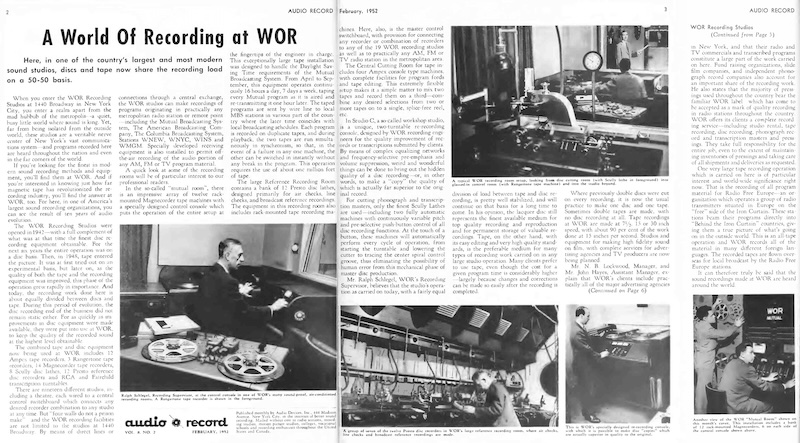
source: “A World Of Recording at WOR”, Audio Record, Vol. 8, No. 2, February 1952, pp.2-3, 6.
For cutting phonograph and transcription masters, only the finest Scully Lathes are used — including two fully automatic machines with continuously variable pitch and pre-selective push-button control of all disc recording functions. At the touch of a button, these machines will automatically perform every cycle of operation, from starting the turntable and lowering the cutter to tracing the center spiral control groove, thus eliminating the possibility of human error from this mechanical phase of master disc production.
市販レコードと放送局用トランスクリプション盤のマスターカッティングには、最高級の Scully レースのみが使用される。これには、連続可変ピッチ機能と、プッシュボタン制御の全自動録音機能を備えた2台の全自動マシンが含まれる。ボタンに触れるだけで、ターンテーブル始動からカッターの下降、センタースパイラルコントロール溝のトレースまで、あらゆる操作サイクルを自動的に実行するため、マスターディスク製造工程における機械的操作からヒューマンエラーの可能性を排除可能になっている。
“A World Of Recording at WOR”, Audio Record, Vol. 8, No. 2, February 1952, p.3市販レコード用EQカーブについての記載はありませんが、一般的には AES 再生カーブ適用で問題ない録音カーブが使われていた、とされているようです。
There is no mention on the recording characteristics used at the WOR Studios at the time, while it is expected that WOR Studios used the characteristics that suited with the AES playback curve.
また、本稿 Pt. 16 セクション 16.4.1 で紹介した通り、AES 標準再生カーブを議論の末に策定した AES 標準規格委員会のメンバに、WOR Studios のチーフエンジニア Ralph Schlegel 氏が含まれていることも見逃せないでしょう。
Also, it should be noted that Ralph Schlegel — chief engineer at the WOR Recording Studio — was one of the the AES Standards Committee members, who discussed and forumated the AES Standard Playback Curve itself.
もちろん、セクション 17.3.3 の Reeves Sound Studios / Mercury で仮説を述べた通り、当初は(LP 本家本元の Columbia LP カーブに近い、かつ放送局用トランスクリプション盤として標準規格化されていた)NAB カーブを採用し、どこかのタイミングで AES 標準再生カーブにあわせた録音カーブに変更した可能性も残っています。
Of course, there is a possibility that Reeves initially used NAB curve (which was the standard for transcriptions, and very similar to Columbia LP curve) for mastering LPs then switched to the AES curve later, like I noted my possible hypothesis in Section 17.3.3 (Reeves Sound Studios / Mercury).
17.5.6 Good Time Jazz / Contemporary label (early years)
Lester Koenig 氏によって1949年に設立された Good Time Jazz レーベル、および1951年に設立された Contemporary レーベルの場合はどうでしょうか。元々 Capitol の録音エンジニアで、1956年から Contemporary に移籍した伝説の録音エンジニア Roy Dunann 氏への貴重なインタビューにヒントがあります。
Next label — how about Good Time Jazz (established in 1949) and Contemporary (in 1951), both by Lester Koenig? Fortunately, there is an invaluable interview with a legend Roy Dunann, who was originally a recording engineer at Capitol Records and later moved to Contemporary in 1956.
Capitol rented its recording facilities to other labels, and also cut masters for them. One was a Dixieland label called Good Time Jazz, owned by Lester Koenig. “Lester was a very fussy guy, a perfectionist, and he thought Capitol was the best mastering facility,” Roy remembers.
Capitol は、他のレーベルに録音設備を貸し、さらにマスターのカッティングも行っていた。そんなレーベルの中に、Lester Koenig 氏の Good Time Jazz というディキシーランドレーベルがあった。DuNann 氏はこう回想する:「Lester は気難しくて完璧主義者で、Capitol が最高のマスタリング施設だと考えていた」。
It’s easy to understand why Koenig would want to hire Roy away from Capitol, but it’s more difficult to understand why Roy would accept the offer. But life as studio manager for a large label was becoming stressful. “The business guys” at Capitol were starting to come around the studio too much. Roy liked Lester and liked Dixieland—almost as much as Tex Ritter.
Koenig 氏が Roy 氏を Capitol から引き抜きたいと思った理由は容易に想像できるが、Roy 氏がその申し出を受け入れた理由を理解するのはやや難しい。しかし、メジャーレーベルのスタジオ・マネージャとしての日々は、Roy 氏にとってストレス多きものとなっていた。Capitol の「ビジネスマン」達が、スタジオに出入りし始めたのである。 Roy 氏は Lester 氏のことが好きで、Tex Ritter と同じくらいディキシーランド(ジャズ)が好きだったのだ。
“The Search for Roy DuNann”, Stereophile, by Thomas Conrad, first published Apr. 2, 2002そういえば、Contemporary レーベルや、その前身である Good Time Jazz レーベルの最初期のリリースには、ダイヤモンドの中に E が入った刻印が共通しています。この刻印は、ロサンゼルスの Charles Eckart Company でカッティングされたことを意味するそうです。
By the way, many of the early releases from Contemporary and Good Time Jazz labels have “E in diamond” stamp in the deadwax area (meaning the records were mastered at Charles Eckart Company).
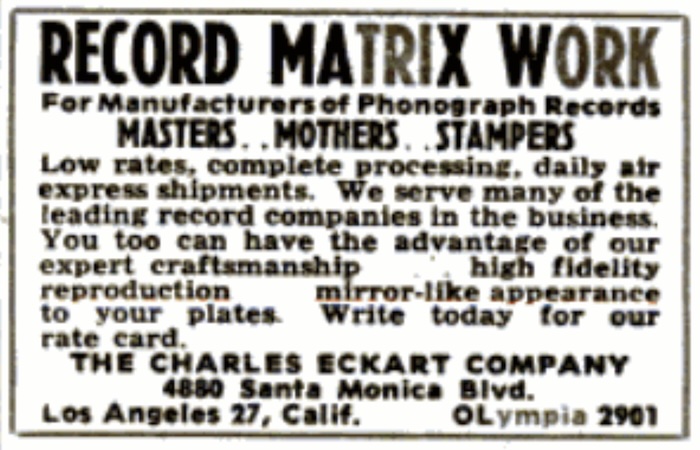
source: Charles Eckart Company Ad, The Billboard, January 6, 1951, p.20.
The Billboard 1951年1月6日号に掲載された、The Charles Eckart Company の広告。マスター制作(カッティング)、マザー / スタンパー制作と書かれている。
Charles Eckart Company には、Good Time Jazz や Contemporary の他、Fantasy (例: Fantasy 3-1)、Discovery (例: Discovery DL-3009) など多くの西海岸のレーベルがマスタリング委託していたことが知られています。
It is known that many West-Coast independent labels, not only Good Time Jazz / Contemporary, but also others such as Fantasy (ex: Fantasy 3-1) and Discovery (ex: Discovery DL-3009) had consigned the mastering and manufacture to Charles Eckart Company.
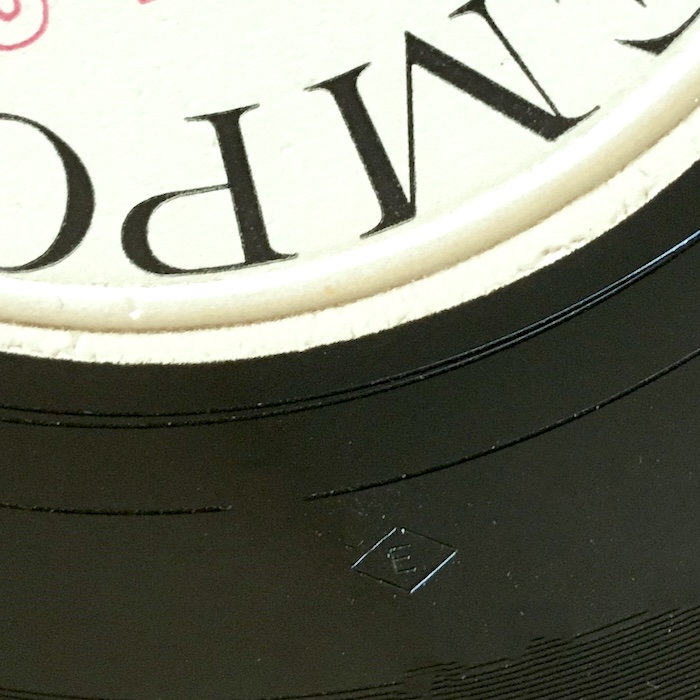
Photo courtesy of Tohru Seya.
“E in diamond” stamp on Contemporarys 78rpm C-354’s deadwax area.
Contemporary 78回転盤 C-354 のデッドワックスに確認される「菱形の中にE」のスタンプ。瀬谷徹さん提供。
のちには有名な「☆」刻印(Capitol Records LA プラント プレス)が見られるようになります。さらにその後は「H」刻印(RCA Victor Hollywood プラント プレス)になります。
Then Contemporary discs’ deadwax would gradually have famous “☆” stamp (pressed at Capitol Records LA Plant); then to the “H” stamp (RCA Victor Hollywood Plant).
つまり、Roy DuNann 氏が Capitol にいた時代(セクション 17.5.3 コラム も参照)は、Charles Eckart Company に録音テープを送ってマスタリング(カッティング)を委託して Circle Record Company にプレス委託したり、Capitol スタジオを借りて録音およびマスタリングまで行ってもらったのち、Capitol にプレスを委託していたのでしょう。
So the real story would be arguably something like this: while Roy DuNann was a Capitol engineer (see also: Section 17.5.3’s column), Contemporary sent the recorded tapes to Charles Eckart and asked for mastering (cutting) then the pressing was done at the Circle Record Company; or rented a Capitol studio and asked for recording and mastering (cutting), then Capitol did the pressing.
そして、Contemporary が Capitol から DuNann 氏を引き抜いた 1956年〜からは、DuNann 氏が Contemporary でマスタリング(カッティング)し、RCA Victor の Hollywood プラントにラッカー盤を送ってプレス委託をしていた、というところでしょうか。
After Mr. DuNann moved from Capitol to Contemporary in 1956, recording and mastering (cutting) was done by DuNann at Contemporary, then lacquer was sent to RCA Victor’s Hollywood plant.
そう考えると、初期の Contemporary のほとんどが AES 標準再生カーブにあわせた録音特性とされるのも、上の Capitol のセクション 17.5.3 で見た通り、Old Orthophonic 相当〜AES相当あたりでカッティングされていた(AES 再生カーブを前提とした録音カーブ)という仮説と合致します。
If viewed in this way, it is natural that the AES curve would fid for almost all early Contemporary records: because as I noted in the Section 17.5.3 (Capitol), Capitol arguably used the recording characteristics similar to Old Orthophonic or AES: in other words, some recording characteristics aimed for the AES Standard Playback Curve.
17.5.7 Peter Bartók Studios and various labels
もう1箇所、特徴的なスタジオを忘れていました。あの Peter Bartók 氏のスタジオです。Peter 氏の父親はもちろん、あの Béla Bartók (1881-1945) です。Peter Bartók 氏が関わった録音で最も有名な作品は、János Starker 演奏の “KODALY: Sonata for Unaccompanied Cello, Op. 8” (Period SPL-510, 1950) でしょう。
I nearly forgot yet another distinctive studio by Peter Bartók. Peter was a son of that famous Béla Bartók (1881-1945). One of the most famous recording by Peter Bartók would be “KODALY: Sonata for Unaccompanied Cello, Op. 8” (Period SPL-510, 1950), performed by János Starker.
その Peter Bartók 氏は、自身で立ち上げた Bartók レーベルの録音・マスタリングを行っていた他、Period レーベル、Caedmon レーベル、Folkways レーベル、Lyrichord レーベル、Unicorn レーベル、そして最初期の Elektra レーベルなどの仕事も行っていたことが知られています。
Mr. Bartók founded his own Bartók label and did recordings and masterings. He also did for such labels as Period, Caedmon, Folkways, lyrichord, Unicorn etc. He was also responsible for some early releases from Elektra label.
Peter Bartók 氏がマスタリング(カッティング)した盤のデッドワックスには、P と B を重ね合わせて正方形の中に押し込めたような、特徴的な刻印が刻まれています。
The discs mastered (cut) by Peter Bartók have unique stamp in the runout (deadwax) area, “P” and “B” combined and enclosed in a square.
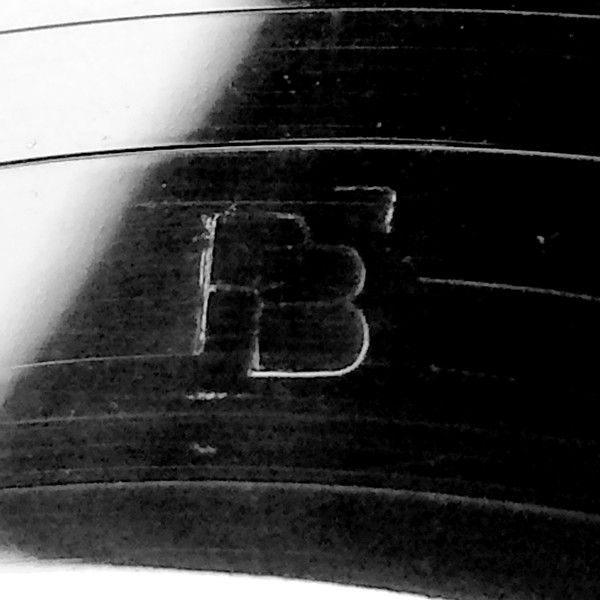
source: Discogs page for Peter Bartók.
興味深いことに、この Bartók 氏がマスタリング(カッティング)に関わった盤の中には、1953年頃までは、NAB /Columbia LP 録音カーブを基調にしつつも、ターンオーバ周波数を 629Hz にとった、通称「Bartók カーブ」、いわゆる 630N-16 or 630B-16 or 630C-16 というものが少なくない、と言われています(正確には 629 ですが、ざっくりと 630 と表記されることも多いようです)。
Interestingly enough, it has been often said that Peter Bartók used so-called “Bartók curve” like 630N-16 or 630B-16 or 630C-16 (more precisely, “630” should be “629”) for many masterings he had conducted. It is said that his recording characteristic was basically NAB / Columbia LP, except the turnover frequency set at 629Hz.
しかし、彼が関わった盤が必ずしも Bartók カーブではないことも分かっており、状況は複雑そうです。
On the other hand, it is also known that not all the records he had mastered used the “Bartók curve” — that makes the situation rather complicated.
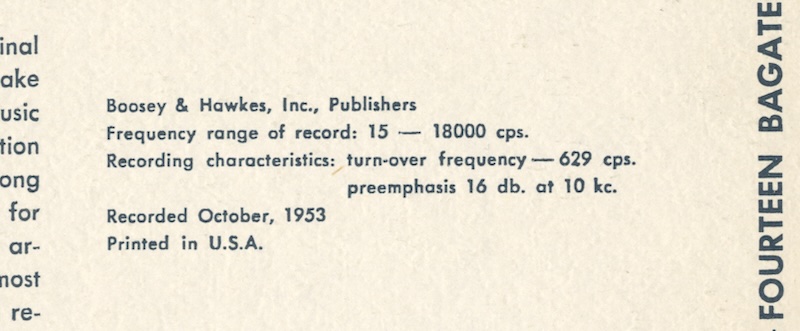
from my own collection of Bartók BR-918 (1954).
1953年10月録音、1954年リリースの Bartók BR-918 の裏ジャケより
“Recording characteristics: turn-over frequency — 629 cps. preemphasis 16 db, at 10 kc.” と明記されている
Bartók 氏がなぜあえてターンオーバー周波数を高めに設定しようとしたのかは分かりませんが、まだ Pultec などの可変イコライザが普及する以前、NAB / Columbia LP カーブ前提で再生する際に、音作りの一環として選定したのかもしれません(あくまで想像です)。
I have no idea why Mr. Bartók selected the turnover frequency at 629Hz, not 500Hz. My light conjecture is: he altered the turnover frequency to make it sound “better” when reproduced with NAB / Columbia LP reproducing characteristics, when the variable (program) equalizers were not so popular in the studios (please note it’s just my guess anyway).
Peter Bartók 氏が録音・カッティング・解説執筆を担当し、1954年に販売開始された “Sounds Of Frequency” というテストLPレコードがあります。FPX-100 (B面11トラック) と FX-6100 (B面10トラック) という2種類のカタログ番号が確認されていますが、恐らく FPX-100 がファーストプレス、FX-6100 がセカンドプレスと思われます。
There is a test LP record entitled “Sounds Of Frequency”, recorded, cut, and commentary written by Peter Bartók. The LP was initially released in 1954, and I guess FPX-100 was the first pressing (B-Side containing eleven tracks), and the FX-6100 being the second pressing (B-Side containing ten tracks).
前者は RCA Victor 委託プレス(E4-QP マトリクス)、後者は Plastylite 委託プレス(耳マークあり)です。私が所有するのは後者です。
The former is an RCA Victor consignment pressing (with E4-QP matrix prefix), and the latter is a Plastylite consignment pressing (with “ear” marks). I have the latter variation.
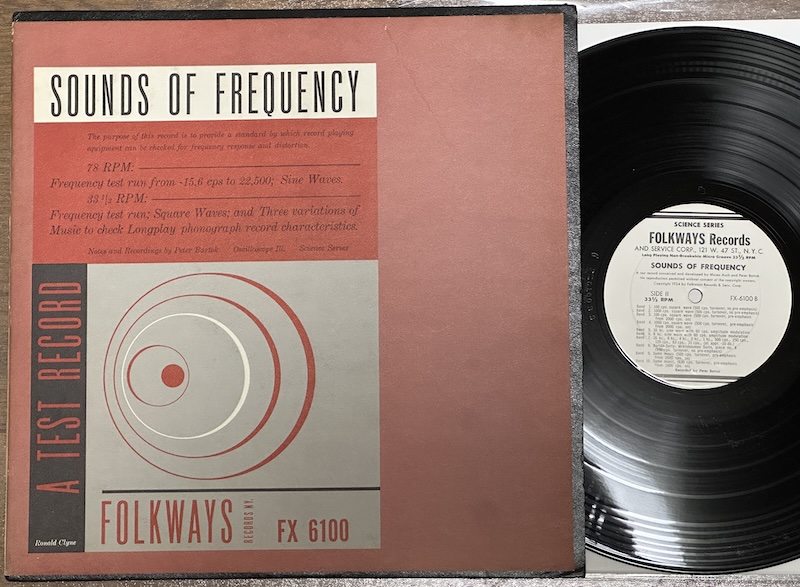
“Sounds of Frequency” (Folkways FX-6100, 1954, probably the reissue of FPX-100)
from my own collection
FPX-100 のB面の B-9 〜 B-11(FX-6100 では B-8 〜 B-10)には、“Bartók-Serly: Mikrokosmos Suite, piece #8 (Sixth dance in Bulgarian Rhythm)” が収録されているのですが、同一音源を3つの録音特性で記録したものとなっています。「“500 cps. turn-over, no preemphasis”(ターンオーバー 500Hz、プリエンファシスなし)」「“500 cps. turn-over, preemphasis starts at 2000 cps.”(ターンオーバー 500Hz、プリエンファシスは 2,000Hz より)」「“630 cps. turnover, preemphasis starts at 1600 cps.”(ターンオーバー 630Hz、プリエンファシスは 1,600Hz より)」、と、3つの特性が使い分けられています。この「2,000Hzより」「1,600Hzより」という表記は、後年の時定数による厳密な表記(75μs: 2,122Hz や 100μs: 1,591Hz)とは異なることには注意が必要です。
Tracks B-9 to B-11 of FPX-100 (B-8 to B-10 of FX-6100) are the same “Bartók-Serly: Mikrokosmos Suite, piece #8 (Sixth dance in Bulgarian Rhythm)” performance, except these three tracks were cut (very interestingly) using the three different recording characteristics: “500 cps. turn-over, no preemphasis”; “500 cps. turn-over, preemphasis starts at 2000 cps.”; and “630 cps. turnover, preemphasis starts at 1600 cps.”. Please note that these “2000 cps” and “1600 cps” are not the same notations as later values precisely with time constants (75μs: 2,122 HZ or 100μs: 1,591Hz).
重低域ターンオーバーについての言及はないものの、B-9 は、いわゆる 500N-FLAT でしょう。B-10 は 500N-14 or 500R-14、すなわちNew Orthophonic = 1953 NARTB = 1954 改訂 AES = 1954 RIAA とほぼ同じとみなせます。B-11 は通称 Bartók カーブ、630N-16 or 630B-16 or 630C-16 となるでしょう。
Although there is no mention on the low-bass turnover (bass-shelf), B-9 would be so-called “500N-FLAT”. B-10 would be very similar to 500N-14 or 500R-14, thus New Orthophonic = 1953 NARTB = 1954 new AES = 1954 RIAA. And B-11 would be so-called “Bartók curve”, which is either 630N-16 or 630B-16 or 630C-16.
特にこの後者2つのカーブは、もしかしたら Peter Bartók 氏が1950年代前半に実際に使っていたものなのかもしれません。
I guess that the latter two characteristics were actually used by Peter Bartók for mastering commercial records in the early 1950s.
このLPに付属するブックレットには、Peter Bartók 氏による以下のような説明が書かれています。
The booklet accompanying this LP contains the following description by Peter Bartók himself:
From bands 9, 10 and 11 it should be evident that the loudest is Band 11, thus the advantage of the long-playing characteristics are proven. (The choice of recording characteristics is made with the purpose of finding one that will make it possible to record with the highest volume without overcutting at low frequencies and without creating excessive distortion at high frequencies.)
(FPX-100 B面の)9トラック目〜11トラック目から、最も大音量で再生されるのは11トラック目であることは明らかで、このLP用記録特性の優位性が証明されたことになる。(録音特性の選択は、低域でオーバーカットせず、高域で過大な歪を発生させず、最大の音量で録音できるものを探す目的で行われる)
No sample of a completely “flat” characteristics was included inasmuch as this would have been rather soft and only bass notes would have been heard.
完全にフラットな特性で記録されたサンプルは、(通常のマグネットカートリッジ用の補正回路で再生すると)ソフトで低音しか聞こえなくなるため、ここには収録していない。
Liner-notes of “Sounds of Frequency” (Folkways FX-6100, 1954)(1) NAB / Columbia LP と同じ 16dB at 10,000Hz という強い高域プリエンファシス(高域歪の点では不利)であるにも関わらず、Bartók 氏が「高域で過大な歪を発生させず」と書いていること。また、(2) 再生用補正について厳格に指定しているわけではないのに「このLP用記録特性の優位性」を謳っていること。これらのことからも、629 (or 630) Hz ターンオーバーという自らの独自記録特性にこだわる姿勢が伺えます。
Bartók’s insistence on his own unique recording characteristic of 629 (or 630) Hz turnover is evident in the fact that (1) he claims “the advantage of the long-playing characteristics are proven” (although he doesn’t clearly note the recommended compensating settings), and (2) he writes “without creating excessive distortion at high frequencies”, despite he adopts the same strong high-frequency pre-emphasis of 16 dB at 10,000Hz as the NAB / Columbia LP curves, that had been known to cause excessive distortion.
一方、のちほど セクション17.6.4 でも改めて触れますが、自らマスタリングした盤であっても、Bartók カーブでないものもかなり存在していることが分かっています。小規模の独立レーベル・独立スタジオであったこともあり、「レーベルなどからの要望に応じて、録音特性を変更した」非常に数少ないサンプルである可能性もあります(現時点では、あくまでも「可能性」です)。
On the other hand, as will be discussed later in Section 17.6.4, it is known that there are quite a few recordings that were not mastered with the “Bartók curve”. So we can hypothesize that the Peter Bartók Studio (and Mr. Bartók himself) possibly was one of the rare examples of “changing recording characteristics according to the requests of the labels and others”. Please note this is just my hypothesis.
17.5.8 US Decca and London
米国3大レーベルの一角であり、自社録音/マスタリングスタジオや自社プレス工場を保有していた Decca に触れてきませんでしたが、ここにも大きな謎があります。ここでいう Decca とは、もちろん UK Decca / England Decca (Decca Record Co., Ltd.) ではなく、US Decca / American Decca (Decca Records, Inc.) の方の話です。
The last among the “Big Three Major U.S. labels” Decca, that had its own recording / mastering studios and pressing plants, has big mysteries. Here, I mean, of course, the US Decca / American Decca (Decca Records, Inc.), not the UK Decca / England Decca (Decca Record Co., Ltd.).
LP初期の US Decca は手元に1枚もないので(笑)、web 上の情報をまとめるにとどまるのですが、おおよそ「最初期は 500C-10.5 または 800N-8」「1953年頃は AES」「その後 1955年11月 RIAA 採用直前までは NAB」という説が一般的のようです。なぜそのように言われているのか、根拠を調べてみました。
Unfortunately I don’t own any early US Decca LPs here: I only can do some information research on the web. Many lists notes the US Decca characteristics as: “500C-10.5 or 800N-8 in very early LP years”; “AES around 1953”; and then “NAB until the adoption of RIAA in November 1955”. So I started doing searches for the info why these are said so.
最初期の「800N-8」の根拠はよく分かりませんが、「500C-10.5」というのはどうやら、 US Decca が 1950年9月に “Gold Label” シリーズのリリースを開始、これが Deutsche Grammophon および Parlophone 製造原盤の米リリースだったから、ということのようです。確かに The Billboard 1954年8月28日号の (US) Decca 特集で、以下のような記述を認めることができます。
I couldn’t find any logical proof of “800N-8” in early years, but as for “500C-10.5” would be the result of US Decca’s classical releases whose matrices were imported from Europe: US Decca started releasing “Gold Label” series in September 1950, and Aug. 28, 1954 issue of The Billboard magazine has Decca special articles, which has the following paragraph:
In September 1950, Decca made its first strong bid to enter the classical field with the creation of its Gold Label series. In addition to domestic recordings, the label was to deal in the issuance of matrices made in Europe by both the Deutsche Grammophon Company and Parlophone Records.
1950年9月、Decca は “Gold Label” シリーズを創設、クラシック分野に初めて強力に参入した。国内で録音された音源に加え、Deutsche Grammophon および Parlophone の両レーベルのヨーロッパ製造マトリクス盤も取り扱いリリースすることとなった。
“A 20-Year History of Decca: Saga of Industry and Vision”, The Billboard, August 28, 1954, p. 15しかし、その後なぜ AES から NAB に逆戻り(?)したとされるのか、その理由がどうもピンときません(NAB から AES ならまだ理解できる)。そして、その両者の差を特定するマトリクス刻印の違いは判明していないようですし、AES と NAB の根拠となる技術情報がみあたりません。また、これらの情報はクラシック盤に限定された情報のようにも思えますし、当時のポピュラー盤についてはよく分かりません。
However, I still don’t have any clear ideas in my mind why it has been said that US Decca switched (back) from the AES curve to the NAB curve: if Decca switched from NAB to AES sometime in this period, it would make sense. Also, any deadwax matrix info won’t show us the hint(s) for the basis of which curve was used. Furthermore, it seems like many information on US Decca’s EQ are for classical releases only: no clear information for popular releases.
おそらくですが、これらの情報は、同じLPのプレス時期による試聴での比較による判断なのでしょう。以下のページでも複数の説が併記されています。UK Decca とは違って US Decca のこの辺りは情報も乏しいように思われますので、識者にお任せすることとします。もしなにか情報があれば教えてください(笑)
So the information is probably the subjective listening tests, comparing the same LPs, between an older pressing and a newer pressing, etc. Below pages show multiple theories at once. Anyway, it seems that, US Decca has few reference information and documentation, while those for UK Decca are plenty. So I will leave it to the experts — if there’s anyone who is familiar with US Decca, please let me know.

screenshot of “Audacity Plugins: Playback equalization for 78 rpm shellacs and early 33⅓ LPs” entries on US Decca releases

screenshot of “EQ CURVES OF OLD RECORDSs” entries on US Decca releases
17.6 Early list from “Dialing Your Disks”
当時の全てのスタジオやレーベルを網羅できていない割には(笑)ごちゃごちゃと書いてきましたが、「1950年代前半の米国での状況」を、ここでいったんまとめます。
I’m sorry I was ranting on, while not all the studios and labels were covered. Anyway I am going to summarize the situation of the early 1950s in the United States.
RCA Victor、Columbia、Decca、Capitol のように、録音スタジオ、マスタリング(カッティング)スタジオ、プレス工場を、全て自社で賄うレーベルもありました。
Some labels had everything — recording studios, mastering (cutting) studios, pressing plants — RCA Victor, Columbia, Decca and Capitol, for example.
Mercury のように、自社録音スタジオを持たず(東海岸では Reeves Sound Studios や Fine Sound Studios、西海岸では Radio Recorders や Capitol Studios を多用)、マスタリング(カッティング)は懇意にしていた提携スタジオ(C.R. Fine 氏のいた Reeves Sound Studios 〜 Fine Sound Studios 〜 Fine Recordings)や、のちにはマスタリング専門の自社 Mercury Sound Studios を使い、自社工場でプレスする、そんなレーベルもありました。
Some labels, like Mercury, did not have its own recording studios (Mercury frequently used Reeves Sound Studios and Fine Sound Studios in the East Coast; Radio Recorders and Capitol Studios in the West). Then mastering (cutting) was done at the partner studios (Reeves Sound Studios, Fine Sound Studios, and later Fine Recordings for Mercury) or at mastering-only own studio (Mercury Sound Studios), and disc manufacturing was done at its own pressing plants.
WOR Studios 時代の Blue Note は、WOR Studios で録音およびマスタリング(カッティング)を行い、Plastylite 社にプレス委託していました。Capitol 時代の Contemporary は、録音スタジオも Capitol から借り、そのまま Capitol でマスタリング(カッティング)・プレスをしてもらっていました。
Blue Note of the WOR Studio years did the recordings at the WOR Studios; mastered (cut) at the WOR as well; then pressed at Plastylite. Contemporary label of Capitol years used Capitol’s recording studio; then mastered (cut) and pressed at Capitol as well.
Atlantic のように、自社で録音・マスタリング (カッティング) スタジオを備えているが、プレスは社外に委託していたレーベルもありました。また、Atlantic ほど大手ではなくても、録音エンジニアが責任をもって自らカッティングし、委託プレス工場に送ったところもあったでしょう。後年の Van Gelder 時代の Blue Note や Roy Dunann 時代の Contemporary がこのパターンです。
Some other labels, like Atlantic, had its own recording / mastering (cutting) studios, while disc manufacturing was consigned to other labels or independent pressing plants. Some minor labels, like Blue Note of the RVG years, and Contemporary of Roy DuNann years would fall in this group as well.
その他の多くのマイナーレーベルは、独立スタジオで録音し、テープを Columbia や RCA Victor、Capitol などに送り、マスタリング(カッティング)およびプレスを委託していました。Charles Eckart 時代の Contemporary もこのパターンと考えられます。
On other minor labels, recording was done at some independent recording studios; tape was sent to Columbia, RCA Victor, Capitol, etc., then mastering (cutting) and pressing was consigned. Contemporary of Charles Eckart years would fall in this group as well.
一部の独立系スタジオでは、クライアント(カッティング委託元レーベル)の要望にあわせて録音カーブを変更していた可能性も捨てきれませんが、恐らくほとんどのスタジオにおいては、録音カーブをコロコロ変えることなく固定ユニットで使用していたと考えられます。代わりに、Pultec に代表される可変イコライザなどでの音作りは徐々に始まっていました。
There could possibly be some independent studios where the recording characteristic was changed from time to time, according to requests from the clients (the labels that consigned the mastering job to the studio). However, majority of such studios would have used fixed recording EQ units. Meanwhile, the sound-making using the variable (program) equalizers were about to become popular.
さて、ここで改めて、1950年秋に制定され、1951年初頭に AES 学会誌上で発表された AES 再生カーブが登場してから、各社の動きは全体の傾向としてどのようなものだったのでしょうか。
Well, here once again, I’m going to summarize the situation of the phonograph industry during the period, after the AES Standard Playback Curve was forumated and published in early 1951.
そこで参考になるのが、High Fidelity 誌に掲載されていた、かの有名なコーナー「Dialing Your Disks」です。
There is some useful information for that purpose. It is a famous section in the High Fidelity magazine, “Dialing Your Disks”.
1953年1/2月号に始まり、1957年4月号に終わる(最後に1957年10月号に1回だけ復活掲載)まで、毎号掲載されていた、この「Dialing Your Disks」コーナーなのですが、実は 信憑性はあまり高くない と思っています。
That famous “Dialing Your Disks” section initially appeared in the Jan./Feb. 1953 issue, and ended in the Apr. 1957 issue (actually, it reappeared once again in the Oct. 1957 issue). However, I believe the series of these sections is not highly reliable.
それを最も表しているのが、号を経るに従って、微妙に違うカーブも雑に同一カテゴリにまとめようとしたり、途中から推測や思い込み、試聴のみによる判断などが混じっているように見えたりすることです。まるで現在のEQカーブをとりまく市井の現状と同じ(笑)ような状態ですね。この話はまた改めてまとめて書く予定です。
Apparently, as the issues went by, it seemed that several different curves sometimes went into the same category; some guesses, prejudice and subjective judgements mixed in. It is just like the current situation of the BS discourses about phono EQ curves that we sometimes encounter. I think I will write that story some other time.
そのような点を差し引いても、“Dialing Your Disks” の最初期、特に1953年前半の掲載情報は非常に貴重です。なぜなら、High Fidelity 誌の編集者が「シュワンのレコードカタログに掲載されているLP製造レーベルに片っ端から連絡をとり、公式回答が得られたものを掲載している」と書いているからです。また、1953 NARTB も 1954 改訂 AES も 1954 RIAA も、まだ規格が存在していなかった時期であることも重要です。
However, even thinking about such defects, early “Dialing Your Disks” data, especially from early 1953, is invaluable, because the editor stated that he “asked all LP-makers listed in Schwann’s Catalogue to report what playback compensation their records required” and only the responses from the LP makers that complied his request were published. It is also important that “early 1953” is the period before any standardization: no 1953 NARTB, no 1954 new AES, no 1954 RIAA.
Many amplifiers now incorporate “equalizing” controls, to compensate for the various recording characteristics used by different record companies in cutting their disks. However, the record companies have been slow to indicate what these characteristics are (a few do, on their record jackets, and others plan to; these are starred in the list below). The Characteristics normally include a treble boost, to submerge surface-noise, and a bass-droop, to minimize groove-excursion and save space. The latter takes effect below a point in the tone-scale called the turnover frequency.
現在、多くのアンプには「イコライジング」コントロールが組み込まれており、各レコード会社がディスクカッティング時に用いる異なる録音特性を補正できるようになっている。しかし、これらレコード会社は、使用している録音特性をなかなか提示しようとしない(ただ、一部のレーベルはジャケットに使用特性を明記しているほか、近々明記する予定のレーベルもある。これらのレーベルは、以下の表において★印をつけてある)。ディスク録音特性には通常、サーフェスノイズを目立たなくするための高域ブースト、そして記録スペースを節約するための低域減衰が含まれる。後者は、ターンオーバ周波数と呼ばれる周波数以下に適用される。
To make things easier for record-owners, HIGH-FIDELITY asked all LP-makers listed in Schwann’s Catalogue to report what playback compensation their records required. At press time, 17 had complied. As can be seen, most use one of two common curves, that of the National Association of Broadcasters, as modified by Columbia, and that of the Audio Engineering Society. The NAB curve incorporates a turnover-point of 500 cycles and a treble-droop of 16 db at 10,000 cycles. The AES turnover is at 400 cycles, its treble-droop is 12db at 10,000 cycles.
レコード所有者の便宜を考え、当 HIGH FIDELITY 誌は、Schwann レコードカタログに掲載されている全LPレコード製造レーベルに対し、必要とされる補正(再生)特性を報告 してくれるよう依頼を行った。本記事掲載時点においては、17社が回答してくれている。ご覧の通り、ほとんどのレーベルが代表的な2つのカーブのいずれかを使っている。1つは、全米放送協会 (NAB) 規格の再生カーブを Columbia が微修正を施したカーブと、オーディオ技術協会 (AES) の再生カーブである。NAB カーブでは、ターンオーバ周波数は 500Hz に設定され、10,000Hz で 16dB の高域減衰を行うようになっている。一方 AES 標準再生カーブでは、ターンオーバ周波数は 400Hz であり、高域減衰は 10,000Hz で 12dB となっている。
“Dialing Your Disks”, High Fidelity, Vol. 2, No. 4, Jan/Feb 1953, p.64勘違いしやすい点ですが、上に引用した通り、HIGH FIDELITY 誌が問うたのはあくまで「必要とされる補正(再生)特性」であり、「記録特性」ではありません。つまり、どのカーブで記録したか、の回答ではなく、どのカーブで再生されることを前提としているか、の回答というわけです。すなわち、たとえレーベルから得られた回答を元にしているからといって、この一覧が「この再生カーブに対応する録音カーブで記録された」ことを保証するものではない、ということです。
Attention is needed that the HIGH FIDELITY asked all LP-makers to report “what playback compensation their records required”, not what “recording characteristics” used for mastering their LPs. In other words, the “Dialing Your Disks” list never guarantees that each label used the recording characteristics that was the inversion of the listed reproducing characteristics.
以下、“Dialing Your Disks” の最初の3号(1953年1/2月号、3/4月号、5/6月号)に徐々に掲載された、各レーベルに問い合わせをした結果回答が得られた、レーベルが想定している再生カーブのターンオーバーとロールオフの一覧をまとめてみました。1/2月号の表記と、3/4月号の表記で、編集者の意図ですでに変更されているものもあったりするのは愛嬌ですが、論理的整合性を優先して調整してあります。
Below is the merger of the “Dialing Your Disks” from the first three issues: Jan./Feb. 1953, Mar./Apr. 1953, and May/Jun. 1953. Each row represents the reproducing curve of what each label intended to be used for its reproduction. Although there is a minor inconsistencies between the Jan./Feb. issue and the Mar./Apr. issue, I have managed to combine them to keep logical consistency.
| LABEL | Turnover | Treble Rolloff (at 10,000Hz) |
(comment) |
|---|---|---|---|
| Atlantic | NAB | NAB | Mar/Apr 1953 |
| Bartók | 629 | 16dB | Mar/Apr 1953 |
| Blue Note | AES | AES | Jan/Feb 1953 |
| Caedmon | 629 | 16dB | Mar/Apr 1953 |
| Canyon | AES | AES | Mar/Apr 1953 |
| Capitol | AES | AES | Jan/Feb 1953 |
| Capitol-Cetra | AES | AES | Mar/Apr 1953 |
| Cetra-Sonia | NAB | NAB | Jan/Feb 1953 |
| Columbia | COL | NAB | Jan/Feb 1953 initially listed as “NAB / NAB” |
| Cook Laboratories | NAB | AES | Mar/Apr 1953 |
| Decca | COL | NAB | Mar/Apr 1953 |
| Elektra | 629 | 16dB | May/Jun 1953 |
| EMS | AES | AES | Mar/Apr 1953 |
| Esoteric | NAB | AES | May/Jun 1953 |
| Good Time Jazz | AES | AES | Jan/Feb 1953 |
| Haydn Society | COL | NAB | Mar/Apr 1953 |
| Lyrichord, new | 629 | 16dB | Mar/Apr 1953 some older NAB; others AES |
| London | 450 | 10.5dB | Jan/Feb 1953 |
| M-G-M | 500 | AES | Jan/Feb 1953 |
| Mercury | AES | AES | Jan/Feb 1953 ★ |
| Oceanic | COL | NAB | Jan/Feb 1953 initially listed as “NAB / NAB” |
| Philharmonia | AES | AES | Jan/Feb 1953 |
| Polymusic | NAB | NAB | Mar/Apr 1953 |
| RCA Victor | 500 | 13.7dB | Jan/Feb 1953 |
| Remington | NAB | NAB | Mar/Apr 1953 |
| Tempo | NAB | NAB | Jan/Feb 1953 |
| Urania | mostly COL / NAB; a few AES | Jan/Feb 1953 ★ initially listed as “mostly NAB / NAB” |
|
| Vanguard-Bach Guild | COL | NAB | Jan/Feb 1953 ★ initially listed as “NAB / NAB” |
| Vox | COL | NAB | Jan/Feb 1953 |
| Westminster | NAB, unless indicated AES | Jan/Feb 1953 ★ | |
本稿(Pt.0〜Pt.17)でいままで見てきた様々な知見を念頭に、この一覧を眺めると、ざっくりとしたグループに分けられることが分かります。
If we look at this table, based on the various information we have learned so far (Pt.0 to Pt.17), these labels can be roughly classified into several groups.
ざっくりいうと、「本家Columbia、Columbia 委託製造レーベル、およびトランスクリプション盤技術応用の独立スタジオ系グループ」、「対抗馬 RCA Victor、RCA 委託製造だが AES 推奨としていたレーベル、および Capitol のグループ」、「AES再生カーブ登場に合わせて AES に寄せようとした独立スタジオ系グループ」となり、さらに例外的に「独自の Peter Bartók」くらいに分類できそうです。
The classification would roughly be as follows: “The original Columbia / labels outsourced to Columbia / other independent studios using the NAB curve originally for transcriptions”; “The counterpart RCA Victor / labels outsourced to RCA Victor, but recommended AES for playback / Capitol weakly following RCA Victor”; “many independent studios adopting the AES Standards after the publication”; and the rare exception of “Peter Bartók Studio going its way”.
本稿は「米国における」録音技術・ディスクEQカーブの歴史について主に学んでいますので、英Deccaカーブを使っている(英Deccaで製造され米に輸入された) London (450, 10.5dB) は議論から除外しておきます。
As this article (and the entire series) is primarily focusing on the history of recording technology and disc EQ curves “in the United States”, I omitted the London label that uses UK Decca curve at the time (450 / 10.5dB) from the discussion. (London LPs were manufactured in UK, then imported to U.S.)
そして、自らカッターヘッドやアンプを開発したり、バイノーラルディスクの特殊な録音特性(内側と外側で特性が異なる)など、あまりにも独自すぎて唯我独尊すぎる(笑)Cook Laboratories もここでは除外しておきます(“Dialing Your Disks” には NAB / AES と書かれているが、これもアテにならなさそう)。
Also, extraordinarily exceptional Cook Laboratories (that invented its own cutterheads and amplifiers; and that famous “binaural” records with two separate grooves for stereo) is ommited as well, although in the “Dialing Your Disks” entry it is labelled as “NAB / AES”.
1989年9月の Emory Cook 氏へのインタビューが掲載されているサイトがありましたので、参考までに紹介します。
For your information, here is an interview with Emory Cook, conducted in September 1989.
また、Tele-Tech 誌 1952年11月号 pp.48-50,136,138,140 に「Recording Binaural Sound on Discs」という記事を寄稿しており、ここでバイノーラル盤制作に関する技術情報が解説されています。バイノーラル盤用再生用の簡易式アンプ回路図(クリスタルピックアップ前提)、および完全版アンプ回路図(マグネティックピックアップ前提)も掲載されています。
Also, I found the article “Recording Binaural Sound on Discs” by Emory Cook, published in the Novemver 1952 issue of the Tele-Tech magazine, pp. 48-50, 136, 138 and 140. Mr. Cook outlines the technology used for manufacturing binaural discs, including a minimum binaural amplifier design (for crystal pickups) and a complete schmatic of high quality binaural amplifiying system (for magnetic cartridges).
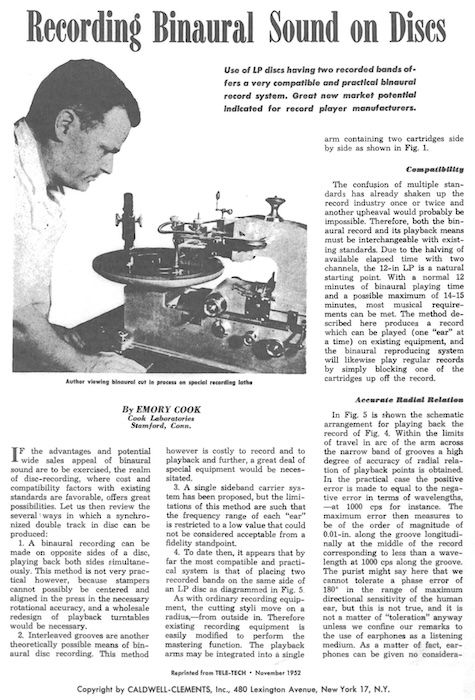
17.6.1 Columbia and consigning labels / NAB Group
| LABEL | Turnover | Treble Rolloff (at 10,000Hz) |
(comment) |
|---|---|---|---|
| Atlantic | NAB | NAB | Mar/Apr 1953 |
| Cetra-Sonia | NAB | NAB | Jan/Feb 1953 |
| Columbia | COL | NAB | Jan/Feb 1953 initially listed as “NAB / NAB” |
| Decca | COL | NAB | Mar/Apr 1953 |
| Haydn Society | COL | NAB | Mar/Apr 1953 |
| Lyrichord, new | 629 | 16dB | Mar/Apr 1953 some older NAB; others AES |
| Oceanic | COL | NAB | Jan/Feb 1953 initially listed as “NAB / NAB” |
| Polymusic | NAB | NAB | Mar/Apr 1953 |
| Remington | NAB | NAB | Mar/Apr 1953 |
| Tempo | NAB | NAB | Jan/Feb 1953 |
| Urania | mostly COL / NAB; a few AES | Jan/Feb 1953 ★ initially listed as “mostly NAB / NAB” |
|
| Vanguard-Bach Guild | COL | NAB | Jan/Feb 1953 ★ initially listed as “NAB / NAB” |
| Vox | COL | NAB | Jan/Feb 1953 |
| Westminster | NAB, unless indicated AES | Jan/Feb 1953 ★ | |
LP を開発した大元である Columbia は、 RIAA 採用前はずっと Columbia LP カーブ (500C-16) 一択でした。
Columbia was an originator of Long Playing Microgroove records. They were constant using the Columbia LP curve (500C-16), until the adoption of RIAA.
Atlantic は1949年当初は Columbia に LP 製造を委託していました(本稿 Pt. 14 セクション 14.1.8 参照)。のちに自社の Atlantic Studios で LP のマスタリング(カッティング)を行えるようになってから、重低域を除き Columbia LP カーブに準拠した NAB カーブでカッティングを続けた(あるいは Columbia LP カーブそのものを使った)、ということではないかと推測します(あくまでわたし個人のいち仮説)。
Atlantic initially consigned mastering and manufacture of LP to Columbia in 1949 (see: Pt. 14 Section 14.1.8). Shortly after that its own Atlantic Studios did mastering (cutting). It is highly probable that Atlantic Studios chose the NAB recording characteristics, which was very close to the original Columbia LP curve except the low-bass region. (it’s just my guess, though)
Cetra-Soria(Pt. 14 セクション 14.1.6 参照)、Haydn Society、Oceanic、Vanguard、The Bach Guild、Vox などは、XTV マトリクスから分かる通り、Columbia にマスタリング(カッティング)およびプレス委託をしていたので、Columbia LP カーブということになります。
Such labels as Cetra-Soria (see: Pt. 14 Section 14.1.6), Haydn Society、Oceanic、Vanguard、The Bach Guild、Vox all consigned mastering and pressing to Columbia, becaust the deadwax matrix stamp of these records are XTV — meaning these records were mastered using Columbia LP curve.
そして、盤によって Columbia と RCA Victor の両方にマスタリング(カッティング)およびプレス委託をしていた Urania や Westminster は、Columbia 委託の盤(XTV マトリクス)は Columbia LP カーブということになります。
Such labels as Urania and Westminster outsourced their mastering (cutting) and pressing to both Columbia and RCA Victor, depending on the discs. So the Columbia-outsourced discs (with XTV matrix) should be recorded with Columbia LP curve.
Polymusic、Remington、Tempo のマスタリングスタジオはちょっと分かりませんでしたが、恐らくはトランスクリプション盤カッティング機材を流用してマイクログルーヴ盤を製造、つまり NAB カーブを使った、ということではないかと推測します。
I couldn’t find any info on which mastering studios Polymusic, Remington, and Tempo used. But I presume these labels used the NAB curve by diverting the equipments for radio transcriptions.
一部が NAB、一部が AES、しかし 629 / 16dB (Bartók) と掲載されている Lyrichord ですが、Discogs 上のマトリクス情報をみる限りにおいては、間違いなく Peter Bartók マスタリングと確認できるのは Lyrichord LL-11 のみでした。それ以外はほとんどが独自マトリクスのため、やはり NAB カーブを使っていたと考えるのが妥当でしょうか(詳細不明)。
On “Dialing Your Disks”, Lyrichord was noted as “some older NAB; others AES” but labelled as “629 / 16dB”. After disc to disc search on Discogs, it was only one LP Lyrichord LL-11, which definitely was mastered by Peter Bartók. Other Lyrichord LPs on Discogs have proprietary matrix inscriptions in the dead-wax area, so I presume that Lyrichord also used NAB curve (details still unknown).
さきほど セクション 17.5.8 で謎多しと触れた (US) Decca ですが、この1953年3/4月号時点では Columbia / NAB カーブと記載されており、暫定的にこのグループに入れてあります。
The mysterious (US) Decca (see: Section 17.5.8) is labelled as “Columbia / NAB”, at least in the Mar./Apr. 1953 issue. So I have placed Decca tentatively in this camp.
それにしても、Dialing Your Disks では、低域ターンオーバが「COL」(500C)と書かれていたり「NAB」(500B)と書かれていたりと、ゴチャゴチャに混在していることを見るにつけ、やはりこのテの表をそのまま鵜呑みにしてはいけないな、と改めて思わされます。
Besides, some labels in this Columbia camp are tagged as “turnover: COL”, while some others as “turnover: NAB”, mixed inconsistently on “Dialing Your Disks” — I am reminded once again that we should not take the information in these tables as is.
17.6.2 RCA Victor and consigning labels Group, and Capitol
| LABEL | Turnover | Treble Rolloff (at 10,000Hz) |
(comment) |
|---|---|---|---|
| Capitol | AES | AES | Jan/Feb 1953 |
| Capitol-Cetra | AES | AES | Mar/Apr 1953 |
| Esoteric | NAB | AES | May/Jun 1953 |
| Philharmonia | AES | AES | Jan/Feb 1953 |
| RCA Victor | 500 | 13.7dB | Jan/Feb 1953 |
| Urania | mostly COL / NAB; a few AES | Jan/Feb 1953 ★ initially listed as “mostly NAB / NAB” |
|
| Westminster | NAB, unless indicated AES | Jan/Feb 1953 ★ | |
セクション 17.5.2 でみた通り、RCA Victor は 1952年8月より前は Old Orthophonic カーブ(500N-12.7)、1952年8月以降は New Orthophonic カーブ(500R-13.7)です。この “Dialing Your Disks” においても、RCA Victor だけ厳密に「500 / 13.7dB」と書かれており、むしろこの一覧の中では浮いてみえるほどです。
As seen in Section 17.5.2, RCA Victor used Old Orthophonic curve (500N-12.7) prior to August 1952, and New Orthophonic curve (500R-13.7) after August 1952. In this “Dialing Your Disks”, only RCA Victor was written strictly as “500 / 13.7dB”, which seems odd in the “Dialing Your Disks” list.
そして、Old Orthophonic カーブの盤を 500R-13.7 で再生しても特に問題ないと判断したから、RCA Victor 担当者は High Fidelity 雑誌に “500 / 13.7dB” と回答したのでしょう。
Also, RCA Victor must have answered “500 / 13.7dB” to High Fidelity magazine because they judged that there was no problem in playing old records (with Old Orthophonic) with 500R-13.7.
Capitol は、セクション 17.5.3 でみたとおり、最初期は Old Orthophonic (500N-12.7) や AES (400N-12) あたりの再生カーブを念頭に置いた録音カーブを使って自社カッティング、1953年秋から RCA Victor にあわせて New Orthophonic / 1953 NARTB (500R-13.7) 録音カーブで自社カッティング、となっていました。なので、Capitol も、RCA Victor 一派に入れて差し支えないでしょう。
As seen in Section 17.5.3, it is known that Capitol mastered (cut) in-house with the recording characteristics with either Old Orthophonic (500N-12.7) or AES (400N-12) in mind. Then since around Fall of 1953, Capitol switched to the new recording characteristics of New Orthophonic / 1953 NARTB (500R-13.7). So it is safe to say that Capitol was in the RCA Victor camp.
“Dialing Your Disks” では “AES / AES” と記されていますが、1953年1/2月号の掲載、つまり1952年暮れの状況にあわせて Capitol が回答したものであり、New Orthophonic 相当への移行前ですので、矛盾はありませんね。
Although in the “Dialing Your Disks” (Jan./Feb. 1953 issue) Capitol was listed ad “AES / AES”, it was a response from Capitol in late 1952 — sounds consistent.
そして、盤によって Columbia と RCA Victor の両方にマスタリング(カッティング)およびプレス委託をしていた Urania や Westminster は、RCA Victor 委託の盤(E1KP, E2KP, E3KP, … マトリクス)は、その時期に合わせて Old Orthophonic または New Orthophonic カーブということになります。
Such labels as Urania and Westminster had outsourced the mastering (cutting) and pressing both to Columbia and RCA Victor, depending on discs. So the RCA Victor-consigned discs of such labels (with E1KP, E2KP, E3KP, … matrices) were either cut with Old Orthophonic or New Orthophonic, depending on the period they were cut.
ややこしいのは、上の セクション 17.5.2 のコラム でも触れた通り、RCA Victor 委託マスタリング(カッティング) / プレスの盤であっても、ジャケット裏に「AESカーブでの再生を推奨」と書かれている盤があることです。Urania レーベルの場合は、先述した URLP-7074 (E2KP-9280/9281) や URLP-7075 (E2KP-9282/9283)、Westminster レーベルの場合は例えば WL-5144 (1952, E2-KP-3980/3981) などがそれにあたります。
To make matters complicated, some discs, even those mastered (cut) / pressed by RCA Victor, have a note on the back of the jacket cover which says: “Playback with AES curve is recommended” (see: Section 17.5.2 Column). Urania’s URLP-7074 (E2KP-9280/9281) and URLP-7075 (E2KP-9282/9283) are such examples: mastered at RCA Victor, but “For optimum reproduction with magnetic cartridges, standard AES equalization should be used with this recording” on the back cover. Other examples include Westminster’s WL-5144 (1952, E2-KP-3980/3981) etc.
この事実の解釈の仮説としては、(1) RCA Victor に、AES 再生カーブに対応する録音カーブでマスタリングするように委託していた可能性、あるいは (2) 当時の RCA Victor が使用していた録音カーブ(Old/New Orthophonic)でマスタリングされているが、ジャケットには AES 推奨と書いた可能性、のどちらも考えられます。
Hypothetical interpretations of this fact include either: (1) RCA Victor was commissioned to master the recording with a recording curve that corresponeded to the AES Playback curve; or (2) the recording was mastered with the recording curve used by RCA Victor at the time (Old/New Orthophonic), but the jacket was labelled as “AES recommended”.
あくまで個人的には、後者の可能性を考えたくなります。製造元である RCA Victor が、委託先に応じて(固定パッシブLRC録音イコライザを使っているのに)録音特性をわざわざ変更するのは面倒であろうこと。まんがいちイレギュラーなカーブを指定できたとしてもそれには追加費用が要求されただろうし、マイナーレーベルはコストに敏感であろうこと。そして、当時はまだ RIAA 規格は存在せず「どんなカーブでもそこそこ再生できるように」と AES 標準再生カーブが推奨されていたこと。また、当時の技術水準では、Old/New Orthophonic カーブ用再生特性と AES 標準再生カーブは(Columbia LP や NAB と比べれば)許せる誤差の範囲内と言えなくもないこと。これらのことから後者の可能性を考えます。
Personally, I am inclined to consider the latter possibility. I guess it would be troublesome for the manufacturer, RCA Victor, to go to the trouble of changing the recording characteristics according to each consignee from time to tome, although RCA Victor arguably used a fixed passive LRC recording equalizer. Also, I guess that if it were possible to specify an irregular curve, it would have required an additional cost (minor labels would have been cost sensitive). Also, the RIAA Standards did not exist at that time, and the AES Standard Playback Curve was recommended so that discs with any recording curves could be played back decently. Furthermore, with the level of technology at the time, the playback characteirsitcs for the Old/New Orthophonic curve are within an acceptable margin of error, compared to Columbia and NAB. Based on the above, I consider the latter possibility.
ただし、これはあくまで Pt. 1 からここまでいろいろ学んできた結果としてのわたし個人の「仮説」「推理」ですので、鵜呑みにされませんよう。この辺を立証する客観的な資料が残ってる可能性は絶望的に低いとは思いますが。。。
However, please note that this is my personal “hypothesis” and “reasoning” based on what I have learned from Pt. 1 to this point. So please do not take it for granted. It is hopelessly unlikely that there are any objective data left (or surfaced) to substantiate my hypothesis.
似たような例として、Philharmonia レーベルがあります。リリース数が多くはないのですが、1952年リリースの2枚 PH-105 と PH-106 は、ともに E2KP マトリクス、つまり RCA Victor 委託マスタリング・プレスということになります。しかし、“Dialing Your Disks” では、レーベルからの回答は “AES / AES” となっています。ジャケット裏には推奨再生カーブに関する記載はありません。
Similar example is found from Philharmonia label. Although not so many titles were released from the label, PH-105 and PH-106, both released in 1952, have E2KP matrix stamps, meaning these records were mastered and pressed by RCA Victor. However, “Dialing Your Disks” lists Philharmonia as “AES / AES”. Both records have no mention of recommended playback curve on the back cover.
やはりこのケースでも、上記の Urania や Westminster の RCA 製造委託と同じ解釈(厳密には Old/New Orthophonic カーブだが、AES カーブでの再生を推奨した)が自然ではないか、と思っています。皆さんはどのように思われますでしょうか?
Again, my hypothesis would be, like the cases of Urania and Westminster, that these Philharmonic releases were mastered with Old/New Orthophonic, while the label replied to High Fidelity magazine as “AES playback recommended”. What do you think?
同様に興味深い例は、Dialing Your Disks (High Fidelity 1953年5/6月号) では Esoteric が “ターンオーバー NAB / ロールオフ AES” と記載されていることです。
Another interesting example is Esoteric label, which is listed as “turnover: NAB / rolloff: AES” in the “Dialing Your Disks” on May/Jun 1953 issue of the High Fidelity magazine.
当初(1950年〜1951年)はマスタリングスタジオ不明の独自マトリクスだったのが、1952年の ES-509 あたりから E2-KP マトリクス、つまり RCA Victor マスタリングに変わります。さらには1953年5月の ES-519 や ES-520 では、マトリクスが E3-KP であるにもかかわらず、レーベル上には “AES Curve” と明記されています。High Fidelity 誌編集部が直接レーベル担当者に問い合わせて得られた回答が “ターンオーバー NAB / ロールオフ AES” であったにもかかわらず、です。
Early Esoteric releases (1950~1951) have unidentified matrix stamps (mastering studio unknown); then from around 1952, Esoteric LPs have E2-KP matrix stamps, meaning they were mastered by RCA Victor (ex.: a href=”https://www.discogs.com/release/9115404-Nicanor-Zabaleta-Harp-Music-XVI-Century-Spanish-Modern-French-And-Spanish”>ES-509). Furthermore, even though ES-519 and ES-520 (both released in May 1953) have E3-KP matrix, “AES Curve” is printed on the labels, even though “Dialing Your Disks” lists Esoteric as “turnover: NAB / rolloff: AES”.
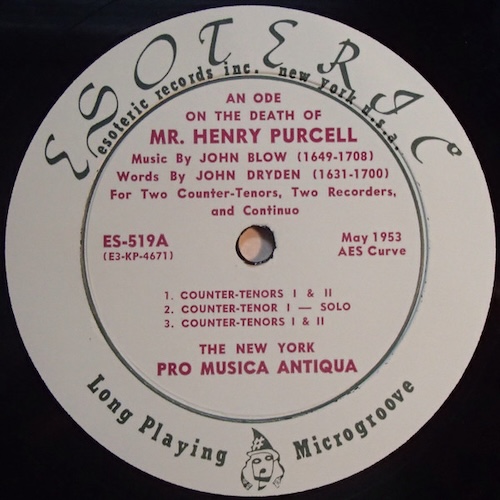
source: Discogs entry.
RCA Victor マスタリングなのに “AES Curve” と印刷されている Esoteric ES-519 (1953年5月)
ところが、次の ES-521 (1953年9月) では、同じく E3-KP マトリクスであるにもかかわらず、レーベルから “AES Curve” 表記が消え、代わりに “New York” と印刷されています。ES-522 (1953年12月) も同様で、E3-KP マトリクス、“St. Paul’s Chapel” と録音が行われた場所が表記されています。
However, Esoteric’s next release, ES-521 (September 1953), has the same matrix stamp E3-KP, while the mention of “AES Curve” disappears from the label (the recorded location “New York” is printed there instaed). Same applies to the next release ES-522: E3-KP matrix stamp, and “St. Paul’s Chapel” on the label, instead of “AES Curve”.
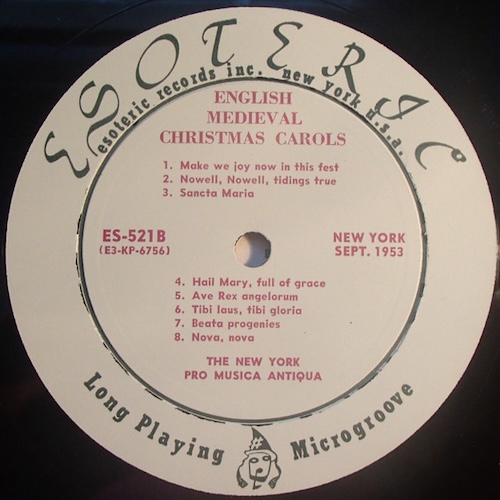
source: Discogs entry.
RCA Victor マスタリング、かつ、カーブ表記が消え録音地に置き換わった Esoteric ES-520 (1953年9月)
やはり、1953 NARTB も 1954 改訂 AES も 1954 RIAA もまだ存在しなかった 1953年5月というタイミングで、RCA Victor の “New Orthophonic” という表記が使えない以上、RCA Victor 以外のレーベルは、当時の AES 再生カーブを指定するしかなかった、という仮説がなりたつ気がします。マイクログルーヴ盤も含まれた、放送局向け NARTB 録音再生規格が正式に採択されたのは1953年7月、それを受けて改訂AES再生カーブが審議に入るのが1953年後半、そのようなタイミングで「AESカーブ」という表記を外したことも、論理的整合性は保たれている気がします(あくまでわたし個人のいち仮説です)。
May 1953 was the timing when neigher the 1953 NARTB, 1954 new AES, nor 1954 RIAA existed, and when “New Orthophonic” was the phrase allowed only for RCA Victor’s records, I guess it is reasonable to assume that the only way for consignor labels to specify the “AES curve” even though mastered with New Orthophonic recording characteristics. It was in July 1953 when the NARTB Recording & Reproducing Standards (for broadcast transcriptions, including microgroove recordings) was officially adopted; also the new AES Playback Standard Curve was deliberatedin late 1953. The fact that the Esoteric label removed the term “AES curve” at such a time seems to be logically consistent. (again, this is just my personal hypothesis)
そして、High Fidelity 誌になぜ “ターンオーバー NAB / ロールオフ AES” と回答したのか、謎は残るばかりです。もちろん、編集部が試聴テストなどで独自に “NAB / AES” と判断し掲載してしまった可能性も捨てきれませんね。
And why the Esoteric label responded to High Fidelity magazine with “turnover: NAB / roll-off: AES” remains a mystery. Of course, we cannot rule out the possibility that the editorial staff independently determined “NAB / AES”, based on their own listening tests.
17.6.3 Group adhering AES Playback Curve
| LABEL | Turnover | Treble Rolloff (at 10,000Hz) |
(comment) |
|---|---|---|---|
| Blue Note | AES | AES | Jan/Feb 1953 |
| Canyon | AES | AES | Mar/Apr 1953 |
| EMS | AES | AES | Mar/Apr 1953 |
| Good Time Jazz | AES | AES | Jan/Feb 1953 |
| M-G-M | 500 | AES | Jan/Feb 1953 |
| Mercury | AES | AES | Jan/Feb 1953 ★ |
1951年1月に出版された AES 標準再生カーブ(本稿 Pt. 16 セクション 16.4 参照)にあわせて、その前後から AES 標準再生カーブを念頭に録音カーブを採用したレーベルや独立系スタジオもあります。
Some labels and independent studios have adopted recording curves with the AES playback curve in mind, since before or after the January 1951 publication of the AES Standard Playback Curve (see: Pt. 16 Section 16.4).
上の セクション 17.3.3 で触れた通り、1949年当初は市販レコードにも NAB カーブを使っていた可能性もあるが、遅くとも1951年には AES 再生カーブを念頭にマスタリング(カッティング)をしていた Reeves Sound Studios(Mercury などが使用)がその一例です。
As seen in Section 17.3.3 already, Reeves Sound Studios (where such labels as Mercury extensively used) is one example: initially NAB curve was arguably used for commercial records as early as 1949, but as late as 1951, the recording curve for the AES playback curve was used for mastering (cutting) instead.
この時期(1949年〜1953年)の Mercury は、マスタリング(カッティング)は Reeves Sound Studios、のちに Fine Sound Studios で行っていました。当初(1949年〜1950年頃)は、全ジャンルを Mercury 自社工場でプレス、1951年頃からクラシック盤のプレスのみ RCA Victor Indianapolis 工場で行われるようになりました。
Mercury label of the period (1949 to 1953) used mainly Reeves Sound Studios (until late 1951) and Fine Sound Studios (since early 1952) for mastering (cutting). As for the pressing, all genres were pressed at Mercury’s own plants, and from around 1951, only classical releases were pressed at the RCA Victor Indianapolis plant.
他レーベルが RCA に製造委託する際は E2KP や E3QP など、カスタム委託プレスを表すマトリクスがつけられていたのに、なぜか Mercury の場合は、Mercury 専用のマトリクス(MF = “Miller cutterhead at Fine Sound”)のみが使われていました。やはり特別なお得意様だったのでしょうか(笑)
For some reason, Mercury only used a custom matrix prefix (MF = “Miller cutterhead at Fine Sound”), while other labels used RCA-style matrix prefixes such as E2KP or E3QP when outsourced the production to RCA Victor. Was Mercury a special customer for RCA Victor after all?
Mercury に肉薄したビッグマイナー MGM レーベルは自社マスタリング / 自社プレスを行っていたはずなのですが、技術情報がなかなかみつかりません。“Dialing Your Disks” では「500 / AES」と書かれており、低域ターンオーバーは RCA Victor の (Old) Orthophonic 由来、高域プリエンファシスは AES 標準再生カーブ由来、という独自カーブということになりますが、便宜上 AES 標準再生カーブでの再生を念頭に置いたグループにいれました。
Another big minor label MGM, which was a close second to Mercury, had their own pressing plants, and must have done their own mastering (cutting), but technical information is so hard to find. “Dialing Your Disks” says “500 / AES”, a unique curve, which means that the low-frequency turnover was derived from RCA Victor’s (Old) Orthophonic, and the high-frequency pre-emphasis from the AES Standard Playback Curve. However, for the sake of convenience, I put MGM in this group with the AES Standard Playback Curve in mind.
ただし、1952年までは NAB カーブを使用していたとする説があり(例: EQ CURVES OF OLD RECORDS や Audacity Plugins: Playback equalization for 78 rpm shellacs and early 33⅓ LPs など)、Mercury 同様、当初は NAB カーブ、のちに AES に寄せたカーブ、と移行したのかもしれません。MGM 自社マスタリングの詳細情報をなんとかして探しだしてみたいものです。
On the other hand, there is a theory that MGM used the NAB curve until 1952 (e.g. EQ CURVES OF OLD RECORDS, and Audacity Plugins: Playback equalization for 78 rpm shellacs and early 33⅓ LPs). So it could be that MGM initially used NAB, then switched to AES, like Reeves (Mercury) did. I wish I could find more information about MGM’s in-house equipments and mastering.
Rudy Van Gelder 以前の Blue Note は WOR Studios でカッティングしており、WOR Studios チーフエンジニアが AES 標準規格委員会メンバであったことを考えると、AES 再生カーブを念頭に置いた録音カーブが使われていた可能性が高いでしょう(セクション17.5.5 参照)。プレスは前述の通り Plastylite でした。
Blue Note (before the RVG years) used WOR Studios for mastering (cutting), and considering that the chief engineer at WOR Studios was also a member of the AES Standard Committee, it is highly likely that the recording curve used at the WOR Studios were set with AES playback curve in mind (see: Section 17.5.5). The pressings were done at Plastylite, as already noted above.
セクション17.5.6 で述べた通り、Contemporary レーベルは、Good Time Jazz 設立当初(1949年〜)は主に Charles Eckart スタジオにマスタリング(カッティング)委託をしていました(セクション 17.5.6 参照)が、Charles Eckart では AES 再生カーブを想定した録音カーブでカッティングされていたのでしょう。Good Time Jazz の LP(1951年〜)も Charles Ekhart マスタリングです(例: Good Time Jazz L-1)。その後 Contemporary 10インチ LP 初期にも Charles Eckart マスタリングが見られます(例:Contemporary C-2501)が、徐々に Capitol マスタリング委託にスイッチしていきます(例:Contemporary C-2508)。Capitol マスタリング委託盤は、さきほど触れた Capitol に準ずるとすると、AES 再生カーブ前提とみなしてよいことになります。
As already discussed in the Section 17.5.6, Good Time Jazz initially used Charles Eckart Studios for mastering (cutting) since 1949, and AES curve could have been used. Some examples of Charles Eckart mastering are: Good Time Jazz L-1, as well as early Contemporary 10-inch releases like Contemporary C-2501. Then later on, Contemporary switched the mastering consignee from Charles Eckart to Capitol (ex.: Contemporary C-2508). As discussed above already, Capitol used the AES curve (or very similar to it) for mastering, so it is safe to assume that the AES curve was also used for Contemporary discs mastered and manufactured at Capitol.
興味深いことに、Contemporary はどこにマスタリングやプレスを委託しようとも、マトリクス番号は必ず LK (78回転盤)、LKX (45回転盤)、LKLP または LKL (LP) で始まる刻印(Good Time Jazz / Contemporary のオーナー Lester Koenig 氏のイニシャル)になっています。
Interestingly, no matter where Contemporary outsourced the mastering and pressing, the matrix prefix was always “LK” (78rpms), “LKX” (45rpms), “LKLP” or “LPL” (LPs), initial of Lester Koenig, owner of Good Time Jazz / Contemporary Records.
そして、Contemporary といえば、なぜか1枚だけ NAB カーブとされている C-2504 “Dizzy In Paris” があります。マトリクスは LKL-39 / LKL-40 で、米 Contemporary C-2504 でも、仏 Swing M. 33 324 でも、マトリクスが共通しています。これは試聴による判断ということなのでしょうか。現物を所有していないため、判断できませんでした。
Another interesting info is Contemporary C-2504 “Dizzy In Paris”, which is mysteriously said as the only Contemporary LP record with NAB curve used. The matrix is LKL-39 and LKL-40, both on the U.S. release (Contemporary C-2504) and French release (Swing M. 33 324). I have no idea why it has been said that NAB was used for this LP. Also, I don’t have this particular album in my collection, unfortunately.
“Dialing Your Disks” で他に “AES / AES” と書かれている、Canyon レーベルは、カリフォルニア州のお隣、アリゾナ州のネイティブアメリカン音楽専用レーベルだそうですが、なにせリリースが多くありません。ただ、1951年〜1953年のマトリクスをみてみると、やはり Charles Eckart マスタリングに見えます(例: Canyon CW-204)ので、この時期の Canyon も AES 標準再生カーブで正解なのでしょう。
Other labels that were indicated as “AES / AES” in the “Dialing Your Disks” list include Canyon, an minor label in Arizona, specialized in Native American music and artists. There are only a few releases from this label, but some examples show that they wre mastered by Charles Eckart (ex.: Canyon CW-204), so the AES curve for the Canyon label’s releases in the pre-RIAA years would be correct.
同じく “AES / AES” とされている EMS レーベルは、1950年頃設立のニューヨークのクラシック専門レーベルです。Discogs 上にもマトリクス情報があまりないので分かりませんが、ちょうど “Dialing Your Disks” が掲載される直前の1952年リリース、EMS Recordings EMS-219 のマトリクスが非常に興味深いです。
Another label listed as “AES / AES” is EMS, founded in 1950, New York, specialized in classical music. Again, only a few were released from the label, but I found an interesting example, EMS Recordings EMS-219 (1952), which has an interesting matrix information.
EMS-219 の最初の特徴は、そのメインのマトリクス情報です。なんと E3-QP-1698、つまり、RCA Victor 委託プレスで、かつ、「E3」=「1953年」、「Q」=「カスタム(委託)プレス、かつ、ラッカー盤が送付されてきた(カッティングは録音スタジオ側で行われた)」、「P」=「12インチ 33 1/3回転 マイクログルーヴ」なのです。ついに、「K」ではなく「Q」の例が見つかりました。そういうわけで、この場合は、マスタリング(カッティング)されたスタジオやそのエンジニアが、どの録音カーブを使っていたのか、によるわけです。
EMS-219’s main matrix is E3-QP-1698. Yes, it means: “E3” = “1953”, “Q” = “Custom (consigned) press, lacquer furnished to RCA (mastering / cutting was done at the recording studio outside RCA Victor)”. Finally I could find an example of “Q” instead of “K”. So the recording characteristic for this particular record was defined by which studio it was mastered (cut) at.
もうひとつの特徴は、円で囲まれた REB というスタンプがあること。現時点で最も詳細な情報 でも「不明」とされていますが、いろいろ調べてみたところ、ニューヨーク州のお隣、コネチカット州の R.E.B. Editions というレーベルのものではないかと推測します。しかも、同レーベルの1953年リリース R.E.B. Editions 10 には、円で囲まれた REB という刻印のほか、メインのマトリクスが E2-QP となっています。この盤も、ラッカーカッティング後に RCA Victor にプレス委託していた、ということですね。
Another interesting dead-wax info is the REB stamp in a circle, which is labelled as “unknown” in currently the most comprehensive matrix database. After a series of my research, it could highly be the stamp derived from the R.E.B. Editions, a label from Conneticut. For example, the dead-wax area of the 1953 release R.E.B. Editions 10 has “REB in a circle” stamp, as well as the main matrix prefix E2-QP, meaning “lacquer cut at R.E.B. Editions” then “lacquer furnished to RCA”.
EMS Recordings EMS-219 や R.E.B. Editions 10 の他、Circle L-14007 (1950)、Debut DLP-1、Rachmaninoff Society RS-3 などでも見られるようです。つまりこれらも、R.E.B. Editions レーベルのエンジニア(詳細不明)がマスタリング(カッティング)した、ということになるんでしょうね。そして、“Dialing Your Disks” に書かれた、レーベル担当者の回答を信じるならば、そこでは AES 標準再生カーブに対応した録音カーブが使われた、と。
Other than these EMS Recordings EMS-219 and R.E.B. Editions 10, such records as Circle L-14007 (1950), Debut DLP-1, Rachmaninoff Society RS-3 also have “REB in a circle” stamp in the deadwax area. So it can be assumed that these titles (and highly possibly these labels) were mastered (cut) by an unknown engineer at the R.E.B. Editions label. Furthermore, if we trust the “Dialing Your Disks” data, these were mastered with the recording curve that corresponds to the AES Standard Playback Curve.
17.6.4 Peter Bartók’s Unique Recording Characteristics?
| LABEL | Turnover | Treble Rolloff (at 10,000Hz) |
(comment) |
|---|---|---|---|
| Bartók | 629 | 16dB | Mar/Apr 1953 |
| Caedmon | 629 | 16dB | Mar/Apr 1953 |
| Elektra | 629 | 16dB | May/Jun 1953 |
| Lyrichord, new | 629 | 16dB | Mar/Apr 1953 some older NAB; others AES |
そして セクション 17.5.7 でも紹介した通り、Peter Bartók 氏は、自身で立ち上げた Bartók レーベルの録音・マスタリングを行っていた他、Period レーベル、Caedmon レーベル、Folkways レーベル、Lyrichord レーベル、Unicorn レーベル、そして最初期の Elektra レーベルなどの仕事も行っていたことが知られています。
As seen in the Section 17.5.7, Peter Bartók did recordings and masterings for his own Bartók label, as well as for other labels such as Period label, Caedmon label, Folkways label、Lyrichord label, Unicorn, and early Elektra label.
さて、“Dialing Your Disks” のエントリに戻って確認してみると、もののみごとに、Peter Bartók 氏が関わったとされるレーベル、Bartok / Caedmon / Lyrichord / Elektra が、他にはない “629 / 16dB” と指定されています。翌年 High Fidelity 1954年3月号の “Dialing Your Disks” には、Folkways も “629 / 16dB” として登場します。
The “Dialing Your Disks” exactly lists Bartok / Caedmon / Lyrichord / Elektra (all related to Peter Bartók) as “629 / 16dB”, a very unique value among others. Folkways would be listed also as “629 / 16dB” in the March 1954 issue of the High Fidelity magazine.
初期の Folkways や Period、Elektra では、Peter Bartók 氏以外に同僚の David Hancock 氏もマスタリングに関与していますが、Bartók 氏のスタジオでマスタリング(カッティング)されたものは、ターンオーバー 629Hz / ロールオフ 16dB で行われた、ということなのかもしれません。一方、多くのEQカーブリストにおいては、Period レーベルのみ NAB (500B-16) と記載されているのも不思議です。この辺りは詳細不明の謎として残っています。
Early releases from Folkways, Period, Elektra labels were mastered by Peter Bartók or his colleague David Hancock. It could be that 629 / 16dB characteristic was used for the records mastered at the Bartók Studio. On the other hand, many “EQ Curves” information lists Period as NAB (500B-16), which is a kind of mystery, and details unkonwn (for me).
ただし、必ずしもこれらのレーベルにおいてカーブが統一されていたわけではなかった(必ずしも Bartók 氏のスタジオでマスタリングしたわけではなかった)のか、はたまた詳細情報が不明で全く分からないのか、ともあれ諸説が入り乱れているようです。私はこの辺の盤は実物をほとんどもっていませんし、また重要な情報を与えてくれるマトリクス番号をみても特に有力情報が得られないので、正直チンプンカンプンです。識者の方々にお任せします(笑)
It is also unknown if such labels used various curves (i.e. not only Bartók Studio was used for mastering), or if there is no technical information available — discrepancy and controversy here. I have few copies of these albums, and I have no idea even looking into the deadwax matrix information, and I have no clear idea. So I leave it to the experts.

screenshot of “Audacity Plugins: Playback equalization for 78 rpm shellacs and early 33⅓ LPs” entries on Bartók releases

screenshot of “Audacity Plugins: Playback equalization for 78 rpm shellacs and early 33⅓ LPs” entries on Period releases (1949-1953)

screenshot of “Audacity Plugins: Playback equalization for 78 rpm shellacs and early 33⅓ LPs” entries on Elektra releases

screenshot of “Audacity Plugins: Playback equalization for 78 rpm shellacs and early 33⅓ LPs” entries on Lyrichord releases
このように、Bartók Studios で使用された録音カーブには謎が多く、録音時の技術資料を見つけられていない現状では、各種状況証拠と照らし合わせながら、聴感によって好みで聴くしかないのかもしれません。
Thus, the recording curves used at Bartók Studios are a mystery, and as we have not been able to find any technical data on them, we may have to listen to the music according to our taste, checking them against various circumstantial evidence.
Period レーベルは、High Fidelity 誌 1953年1/2月号〜1957年10月号の “Dialing Your Disks” には結局一度も登場することはありませんでした。しかし、Peter Bartók 氏がマスタリング(カッティング)した Period 盤が多く存在することが知られています。
Period label never appeared in High Fidelity magazine’s “Dialing Your Disks” from Jan/Feb 1953 to Oct 1957, while it is also known that not a few Period releases were mastered (cut) by Peter Bartók.
手元に Period SPL-582 “Unaccompanied Cello Suites No. 1 in G and No. 4 in E Flat / János Starker” があります。1950年〜1952年録音とされるこのLPは、The Billboard 誌 1954年2月20日号 p.37 に新譜レビューが掲載されていることから、1954年1月〜2月にリリースされたと思われます。一方、マトリクス刻印からは、1953年に製造されたことも分かります。時期的にはどのカーブか微妙なタイミングです。Audacity Wiki では 1953年の 576 が NAB カーブの最後で、それ以降は New Orthophonic (= RIAA) とされています。
There is Period SPL-582 “Unaccompanied Cello Suites No. 1 in G and No. 4 in E Flat / János Starker” in my collection. It is known that the recorded date was sometime between 1950 and 1952. Also, Feb. 20, 1954 issue of The Billboards lists this album under “Reviews and Ratings of New Classical Releases”, so this album was probably released in January or February 1954. On the other hand, dead-wax matrix stamps indicates the master of this LP was manufactured in 1953, a delicate timing. BTW Audacity Wiki notes Period LPs as “NAB until SPL-576 (1953); then New Orthophonic (=RIAA)”.
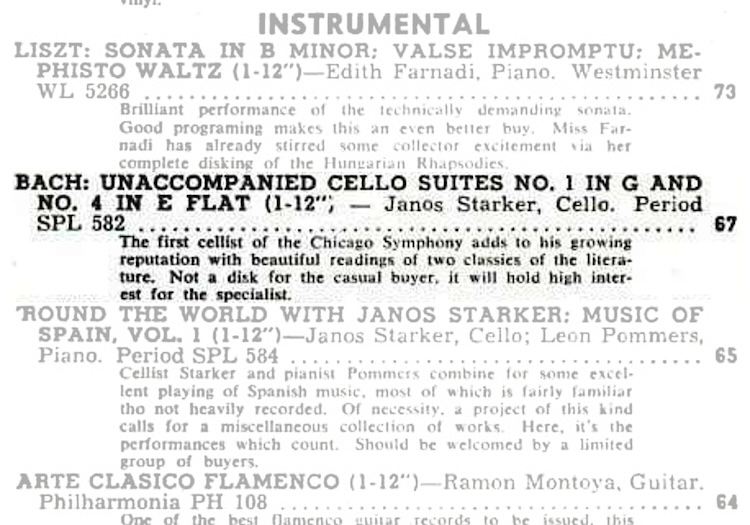
source: “Reviews and Ratings of New Classical Releases”, The Billboard, February 20, 1954, p.37.
Period SPL-582 のレビュー記事
B面のマトリクスは E3KP 7505-1B A2 R、つまり、1953年製造、テープが RCA に送られマスタリングされ、RCA Victor Rockaway プラント でプレスされたことを示しています。つまり、New Orthophonic カーブ (500R-13.7) でカッティングされているはずです。ちなみに Rockaway プラントは1954年秋に稼働開始(The Billboard 1954年9月25日号 p.39 の広告)ですので、1954年秋以降のプレスということになります。
The matrix stamp of the B-Side is E3KP 7505-1B A1 R, which means: lacquer made in 1953; tape furnished to RCA; pressed at RCA Victor Rockaway plant. This suggests that this particular side should be mastered (cut) using the New Orthophonic (500R-13.7) curve. By the way, RCA’s Rockaway plant started operation in the fall of 1954 (see: RCA Victor’s Ad on p.39, The Billboard, September 25, 1954), so this partiular disc was pressed after Fall of 1954 at the earliest.
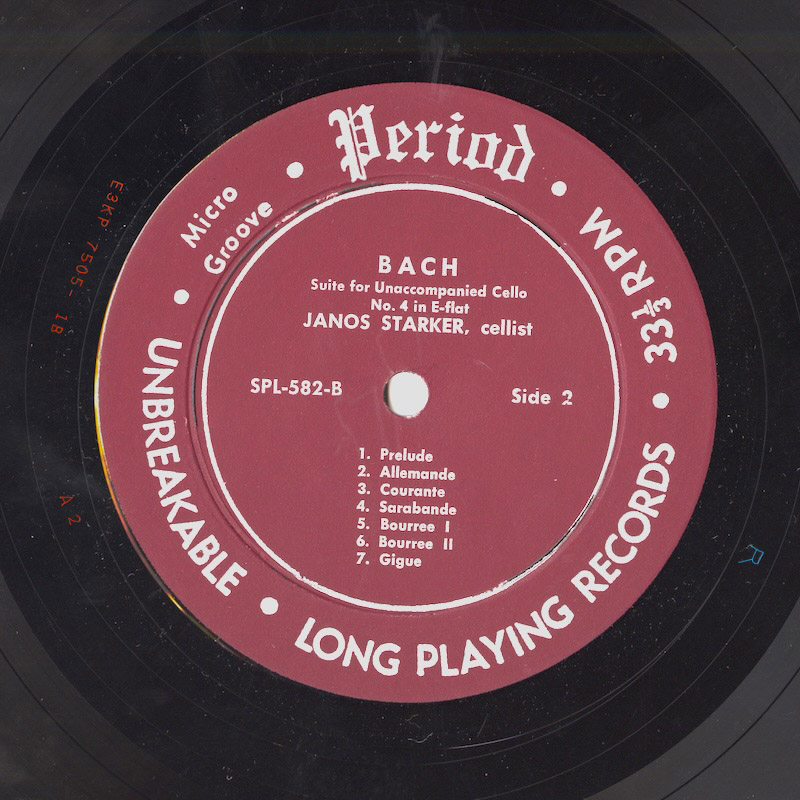
from my own collection
興味深いのがA面で、マトリクスは E3DP 7506 2 B2 のほか、別字母で 4V9 および SPL 582 A が刻まれ、さらに Peter Bartók 氏マスタリングを示す、あの特徴的な P と B を重ね合わせたような正方形のような刻印 が見られます。
The matrix stamp of the A-Side is interesting. It reads E3DP 7506 2 B2, along with a different fontface of 4V9 and SPL 582 A. Furthremore, the dead wax has the famous stamp of P and B combined in a box, indicating that this was mastered by Peter Bartók himself.

from my own collection
3文字目の「D」は、1954年以降に RCA Victor の廉価レーベル Camden に使われた文字(例: RCA Camden CAL-203)なのですが、なぜか1953年製造のものは、この Period をはじめ、Caedmon(例: Caedmon TC-1017)、Bartók(例: Bartók BRS-916)など、Peter Bartók 絡みのレーベルでのみ見られます。ですので、このA面は、RCA Victor マスタリングではなく、Peter Bartók Studios マスタリングで、ラッカーが RCA Victor に送られたことになります。
The third letter “D” is known that it was used since 1954 for RCA Victor’s budget label Camden (ex. RCA Camden CAL-203). But interestingly, some releases only from Bartók-related labels particulary manufactured in 1953 has the same “D” including this Period SPL-582, as well as Caedmon (ex. Caedmon TC-1017), Bartók (ex. Bartók BRS-916), etc. Anyway, the above info indicates that this Side-A was not mastered at RCA, but mastered at the Peter Bartók Studio, then the lacquer was furnished to RCA Victor.
A面とB面で、マスタリングされたスタジオと担当エンジニアが異なる、という、非常に珍しい例ですね。
It is a rare example of the LPs, with different mastering studios (and different mastering engineers) from one side to another.
さて、実際にB面を試聴してみますと。名盤の誉高いコダーイ盤(SPL-510)のように「松脂が飛ぶような音」かどうかはさておき(笑) RIAA (New Orthophonic) で特に問題ないように聴こえます。NAB / Columbia LP カーブで再生してもそんなに違和感がある再生ではありません。マスターテープにそのような音が入っていたなら、つまりそういう音を狙って録音されたのであれば、そうなのかも、という程度です(試聴による私感であることに注意)。
Auditioning Side-B (E3KP = mastered at RCA in 1953) also proves that it sounds nicely with the RIAA (New Orthophonic) equalization, while on the other hand, reproducing with NAB / Columbia LP curve doesn’t sound such bad. Both sound decently, if the master tape contained that tone (i.e. the recording engineer intended that sound). Please note that this is just my impression upon actual listening.
一方、Peter Bartók マスタリングの刻印があるA面は、リードイン部分の無音からハムノイズのようなものが聞こえます。リードアウトの無音部にも不思議なトーン音のようなものが入っています。B面に比べるとカッティングレベルが若干高いように感じられますが、やはり RIAA で特に問題ないように聴こえます。NAB / Columbia LP や、629N-16 で再生しても、まぁ1950年〜1952年頃の録音ということもあり、元々こういう音作りだったのかも、という程度の差でしかありません(同様に、試聴による私感であることに注意)。
Side-A, with the matrix stamp by Peter Bartók, has a kind of power line hum noise soon after the lead-in groove. Lead-out groove also has strange tone noise, although it is not so loud. Also, I feel the cutting level is a bit louder than that of Side-B. Anyway, Side-A also sounds nicely with the RIAA (New Orthophonic) compensation. Also, compensating with NAB / Columbia and 629N-16 still sounds decently as well. Either sound is acceptable, as a recording of 1950-1952. Again, please note that this is just my impression upon actual listening.
やはり、B面が RCA マスタリング = New Orthophonic と考えられるので、A面でも Peter Bartók 氏がそれに近い録音カーブ(たとえば 17.5.7 コラム で触れた 500N-14 or 500R-14 など)を選定したのではないかと思われます。
Again, I guess that for this particular LP, manufactured in late 1953, released in Jan.-Feb. 1954, considering that the Side-B was mastered at RCA Victor (thus New Orthophonic curve was employed), Mr. Bartók could have used some similar curve (500N-14 or 500R-14, for example, as I already mentioned in the column of Section 17.5.7).
残念ながら、当時の Period 盤については、どうやらマスターテープが紛失しているのか、過去のCD再発は全てLPからの盤起こし復刻となっています。この SPL-582 の場合、たとえば EINSATZ EZCD-006 は 英 英 Nixa PLP-582 からの盤起こしで、PLP-582 のマトリクスをみると両面とも E3QP マトリクス、かつ PB マークつきなので、Peter Bartók マスタリングの原盤が英国に送られたのでしょう。そして Forgotten Records FR-252 では 仏 Counterpoint M.C. 20.047 や 米 Period SPL-582 からの盤起こしとのことです。その他 Spectrum Sound CDSM-002JYNA / CDSM-003JT は、Period 盤各種、および Period Thrift Edition TE093 からの復刻とのことです。
Unfortunately enough, it seems like the original master tapes for Period Records has been lost: all CD reissues were dubbed from the original LP releases. For example, EINSATZ EZCD-006 was dubbed from British Nixa PLP-582 (with E3QP matrix on both sides, which means that the Nixa LP was pressed using the masters cut by Peter Bartók); another reissue, Forgotten Records FR-252, were reissued by transferring from Forgotten Records FR-252 では Counterpoint (FR) M.C. 20.047 and Period SPL-582 copies. Other reissues include Spectrum Sound CDSM-002JYNA / CDSM-003JT, which were transfered from Period LPs and Period Thrift Edition TE093 3LP box set.
ですので、マスターテープからのフラットトランスファーの音を聴くすべがない以上、どのカーブが正しいのか、の判定も難しいことになります。
In this way, we have no ways to appreciate the “flat transfer” sound from the original master tapes: no way to determine which reproducing curve was originally intended.
上の Period SPL-582 (1954) がどうもすっきりしないので、もう少し前の盤、ちょうど SPL-582 と対になるアルバム、Perioc SPL-543 “Unaccompanied Cello Suites No. 3 in C Major and No. 6 in D Major / János Starker” も入手してみました(笑)
As the above Period SPL-582 (1954) didn’t show me straightahead information, I wanted to investigate another Period LP: Perioc SPL-543 “Unaccompanied Cello Suites No. 3 in C Major and No. 6 in D Major / János Starker”, a companion release of SPL-582.
先ほどの SPL-582 と異なり、レーベル自体も光沢のあるタイプとなっています。
The label on the disc is glossy type, unlike the SPL-582 I showed above.
1951年マスタリング(カッティング)、1952年リリース、のこの盤もまた不思議なマトリクスで、A面が「E1LQC 15111 1B A1」に加え、別字母で「SPL543 A」刻印、さらに手書きで 「30222」、最後にあの特徴的な P と B を重ね合わせたような正方形のような刻印、となります。
Mastered (cut) in 1951, and released in 1952. This particular disc also has unique matrix stamps, with Side-A “E1LQC 15111 1B A1”, as well as “SPL543 A” of different fontface, and handwritten “30222”, then finally the famous stamp of P and B combined in a box, indicating that this was mastered by Peter Bartók himself.
SPL-582 の A面もそうでしたが、Peter Bartók 氏かカッティングすると、リードアウト部分の gpi (grooves per inch, 1インチあたりの溝数) が密なのが興味深いですね。それはさておき。
It’s interesting to see the PB-cut sides always have the lead-out groove with dense gpi (grooves per inch): SPL-582’s Side-A and SPL-543’s Side-A.
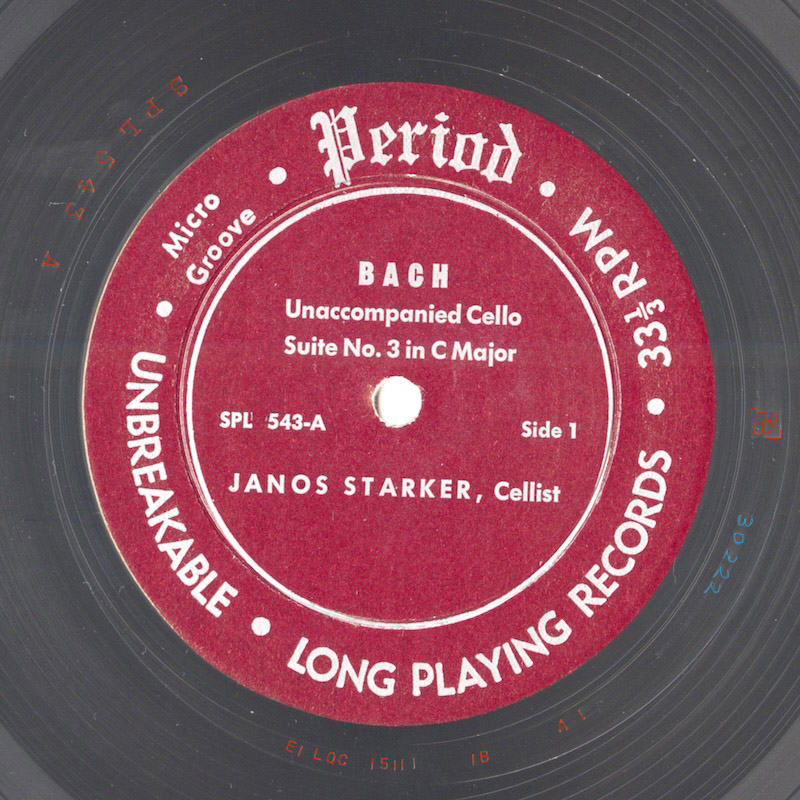
from my own collection
ともあれ、1951年夏までのマトリクスパターンを読み解くと「E1」=「1951年」、「L」=「33 1/3回転 LP」、「Q」=「カスタム(委託)プレス、かつ、ラッカー盤が送付されてきた(カッティングは録音スタジオ側で行われた)」、「C」=「12インチ」となります。つまり、Peter Bartók 氏がカッティングまで済ませ、RCA Victor でプレスしてもらったことになります。
Anyway, decoding this matrix pattern before the summer of 1951 would result in: “E1” = “1951”; “L” = “33 ⅓ rpm LP”; “Q” = “custom (consigned) press, lacquer furnished to RCA (mastering / cutting was done at the recording studio outside RCA Victor)”; “C” = “12-inch”. So this particular side was cut by Peter Bartók himself at his studio, then the lacquer was sent to RCA Victor for manufacturing (pressing).
一方、B面は、なんと手書きで「E1-LKC-15112-1C A1」となっています。こちらは「E1」=「1951年」、「L」=「33 1/3回転 LP」、「K」=「カスタム(委託)プレス、かつ、テープが送付されてきた(マスタリング / カッティングは RCA Victor で行われた)」、「C」=「12インチ」です。手書きマトリクスなのが不思議ですが、RCA でカッティングされた面ということになります。そのほか、さらに離れてプレス工場を表したと思われる手書きの「R」もあり、これが Rockaway プラントプレスを意味するのであれば、1954年秋以降のプレスということになります。
Side-B has also unique matrix information: “E1-LKC-15112-1C A1”, but this time handwritten. “E1” = “1951”; “L” = “33 ⅓ rpm LP”; “K” = “custom (consigned) press, tape furnished to RCA (mastering /cutting was done at RCA Victor)”; “C” = “12-inch”. I have no idea why this matrix was handwritten type, but anyway it shows that this particular side was cut at RCA. Yet another “R” inscription can be seen in the deadwax, so if it meant the RCA Victor’s Rockaway plant, this particular copy would be manufactured in the fall of 1954 at the earliest.
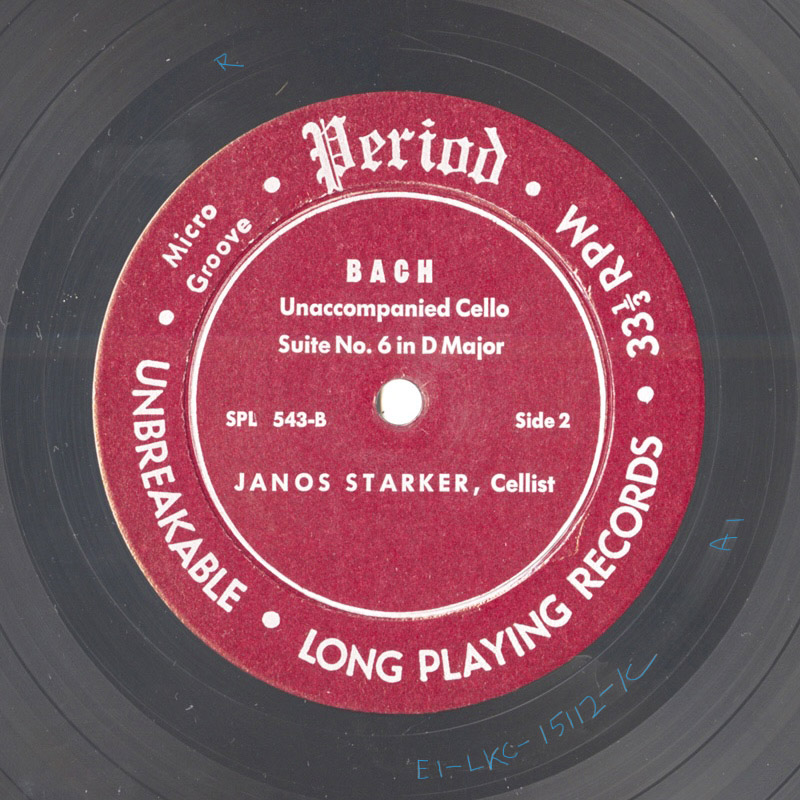
from my own collection
プレスは1954年秋以降の可能性があるが、カッティングは1951年、ということで、B面を、Old Orthophonic という前提で RIAA で再生してみると、上の SPL-582 同様の帯域バランスの良好な音で聴こえてきます。一方、A面の Peter Bartók マスタリングの面も、やはり SPL-582 の A面と同様、記録レベルがじゃっかん高いことを除き、B面と同じ再生カーブでちょうど同じ帯域バランスに聴こえました。つまり、B面が当時の RCA Victor の Old Orthophonic カーブでマスタリング(カッティング)されているならば、A面も Peter Bartók 氏が B面にあわせてマスタリング(カッティング)していることになりそうです。(再び、試聴による私感であることに注意)
Based on the hypothesis that this particular disc was mastered (cut) in 1951 but possibly pressed in the fall of 1954 or later, I played Side-B with RIAA equalization (with the assumption of Old Orthophonic being used) — it played decently with good tonal balance. Then I played Side-A (mastered by Mr. Bartók) — it also played decently using the same reproducing compensation, except that the cutting level was a bit louder than that of Side-B. So, I had a strong feeling of conjecture — if Side-B was mastered by RCA Victor’s engineer using the Old Orthophonic curve, Side-A was mastered by Peter Bartók using the similar (or same) recording characteristics as Side-B. Again, please note that this is just my impression upon actual listening.
その他、現物は確認できていないのですが、同じ SPL-543 でも 両面 E1-LQC マトリクス、つまり外部マスタリング(カッティング)、RCA Victor プレス、というパターンもあるようです(例: SPLP-543)。少し後期になると、両面 E1-LKC マトリクス、つまりA/B面とも RCA Victor でマスタリング(カッティング)、および RCA Victor プレス、というパターンもあります(SPL-543)。
Although I have not inspected actual discs, it is known that there are some more matrix variations of SPL-543: E1-LQC matrix on both sides, meaning both sides of the lacquer discs furnished to RCA (ex. SPLP-543); and bit later pressings with E1-LKC matrix on both sides, meaning tape furnished to RCA, and both sides mastered (cut) and pressed at RCA Victor (ex. SPL-543).
さらにややこしいことに、Discogs 上では、Peter Bartók カットの Period レーベルの初期は Plastylite プレスの盤が確認できます(例: SPL-529、SPL-556)。これらの盤では Old/New Orthophonic カーブではなく NAB カーブや Bartók カーブが使われていた可能性もありますが、現物を所有していないため(そして関連する情報を見つけられていないため)確認できません。
To complicate matters further, we can find early Period releases on Discogs, mastered by Peter Bartók and pressed at Plastylite (ex. SPL-529 and SPL-556). It is possible that NAB or Bartók curves were used on these pressings instead of Old/New Orthophonic curves, but I cannot confirm this because I don’t own any of these original pressings (and I couldn’t find any relevant information yet).
同じ Period レーベルだから録音特性が全て一緒、とは断言できないのは、こういった例があるためです。
These are the reasons why I think it impossible to affirm that the recording characteristics used for Period label releases were all the same.
セクション17.5.7 のコラム で紹介した、Folkways の1954年テストレコードでは、Bartók 氏は同一音源を 500N-FLAT と RIAA カーブと Bartók カーブの3通りで収録してみせていました。やはり、Bartók 氏は、リリースするレーベル(や委託するマスタリング先)にあわせて、RCA Victor 系録音カーブと Bartók 独自の録音カーブを使い分けていた、当時でも非常に珍しいエンジニアだったのかもしれませんね。
Folkways’ 1954 frequency test record (see: Section 17.5.7 column) was mastered by Peter Bartók, and it contained the same musical contents with three different recording characteristics: 500N-FLAT, RIAA, and Bartók. This would suggest that he possibly was one of the rare examples of using different recording curves for clients or consigned labels.
17.7 Phono Amplifiers in the early 1950s (before RIAA)
1950年代前半までは、ほとんどの一般リスナーが使っていたのは、クリスタルカートリッジやセラミックカートリッジなど、圧電式カートリッジであり、基本的には現代のようなフォノEQは使われていませんでした(本稿 Pt. 7 参照)。
Until the early 1950s, most casual music listeners had used piezo-electric pickups (crystal or ceramic): no phono equalizer was necessary (see also: Pt. 7).
しかし、1950年代前半のハイファイブームにより、プロフェッショナル業界(ラジオ局など)で使われていた高価なマグネットカートリッジにも注目が集まり、フォノイコが内蔵されたアンプが一部のマニアや好事家向けとして次々と市場に投入されました。
However, as the “Hi-Fi” movement came into fasion in the early 1950s, audio hobbyists (or “audiophiles”) began experimenting magnet pickups, that had been commonly used in the professional fields such as radio stations and studios. Also, many amplifiers (with selectable photo EQ circuits build-in) came into the “Hi-Fi” market, for Hi-Fi enthusiasts at the time.
そこで、Pt. 17 の最後となる本セクションでは、1950年代前半(しかも、1953 NARTB / 1954 改訂 AES / 1954 RIAA 策定前)に市販されていた、マグネットカートリッジ向け選択式フォノEQを内蔵したアンプをみていき、その変遷を探ってみましょう。
This section, as a last section of this Pt.17 article, I’m going to investigate the short-term changes of selective phono EQ for magnetic pickups, equipped with the amplifiers that were commercially available in the early 1950s — the period before 1953 NARTB / 1954 new AES / 1954 RIAA standardizations.
そういった当時のマニア向け市販高級アンプに内蔵されていたフォノイコの、セレクタポジションの変遷や傾向をみていくことにより、さきほど “Dialing Your Disks” のところで述べた「RCA Victor の New Orthophonic カーブと思われるのに、なぜ “NAB / AES” や ”AES / AES” 指定になっているのか」の謎も解けるのでは、と考えたからです。
I thought it would help understand some mysteries of why some labels, mastered by RCA Victor, arguably with New Orthophonic curve, were indicated as “NAB /AES” or “AES / AES”, by investigating the variation and changes among the phono EQ selectors with such early 1950s amplifiers.
ここでは当時のオーディオマニア向け雑誌に掲載された広告やレビューを手がかりに、当時の機器を調べてみることにします。1951年4月創刊の High Fidelity 誌が代表的でしょう。一方 Audio Engineering 誌は、1954年2月号で誌名が Audio 誌と変更されるまでは、より専門家・研究者向けでしたね。
So I will look for the reviews and advertisements in the High Fidelity magazine, initially published in April 1951, which was one of the most famous 1950s’ magazines for audio hobbyists and enthusiasts. Audio Engineering magazine, on the other hand, was for audio experts and researchers, until the magazine was renamed to “Audio” magazine in February 1954.
17.7.1 Bell Sound Systems Model 2200
まず、High Fidelity 1952年11/12月号 p.10 に広告が掲載されている、Bell Sound Systems, Inc. のアンプをみてみましょう。 Model 2122-B / Model 2200 / Model 2145-A と3機種が紹介されています。
First is the Bell Sound Systems, Inc. ad that appeared on p.10, Nov./Dec. 1952 issue of the High Fidelity magazine, featuring three amplifiers: Model 2122-B, 2200 and 2145-A.
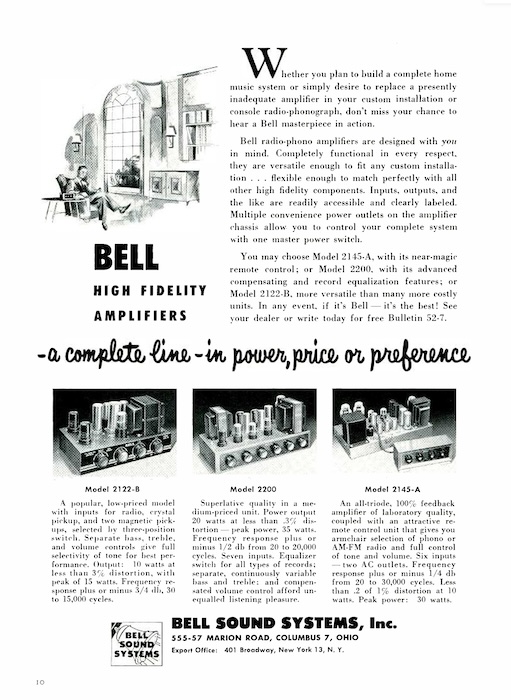
source: High Fidelity, Vol. 2, No. 3, November-December 1952, p.10.
Bell Sound Systems, Inc. のアンプの広告
この3機種の中で最上位機種である Model 2200 の後継あるいは改訂版と思われる Model 2200B のマニュアルが AudioKarma Database というサイトにありました。
I could find the operating manual for Model 2200B, highly possibly the improved / successor model of the top model among these three in the ad, Model 2200.
フロントパネルのイラストを見ると、EQカーブセレクタがあります。ポジションは “AES” / “LP/NAB” / “FLAT” / “FGN” / “FFRR” です。“FGN” は “Foreign” の省略で、ターンオーバー 250Hz、高域はフラット、というポジションのようです。
Illustration of the front panel shows the EQ curve selector knob. The positions are: “AES” / “LP/NAB” / “FLAT” / “FGN” / “FFRR”. FYI, “FGN” is an abbrebiation of “Foreign”, meaning old European records (turnover at 250Hz, no high frequency pre-emphasis).
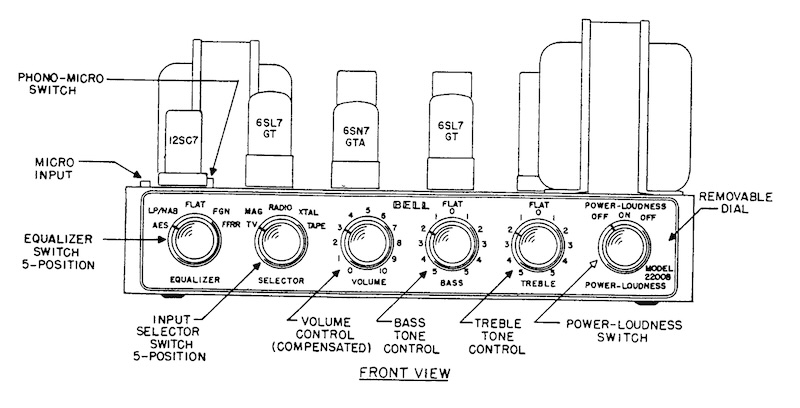
source: Bell Sound Systems Inc. Model 2200B Operation and Installation Manual (at AudioKarma Database).
マニュアルにはさらに各ポジションの解説が書かれています。興味深いのは “LP/NAB” ポジションの説明で、「このポジションは LP, (1951) NARTB, RCA カーブの折衷案(±1dB)的なカーブである」と書かれています。実際、ターンオーバー 500Hz、ロールオフ 14dB と書かれています。
The instruction manual describes more detailed info on each selector position. Description for the “LP/NAB” is really interesting: “This is a compromise curve within plus or minus 1 db of the LP, NARTB, and RCA curves”, with the response of “500 cycle turnover, -14 db roll-off”.
ちなみに、ここでの “NARTB” は 1953年7月策定の NARTB のことではなく、1942年および1949年策定の NAB のことを指します。NAB (National Association of Broadcasters) は 1951年に NARTB (National Association of Radio and Television Broadcasters) と名称を変更したためです。ややこしいことに、1958年に再び名称を NAB に戻しています。
Please note this “NARTB” here stands for the 1942/1949 NAB curve, not for the July 1953 NARTB curve: in 1953 NAB (National Association of Broadcasters) changed its name to NARTB (National Association of Radio and Television Broadcasters). To make things complicated, NARTB would change its name again in 1958, back to NAB.
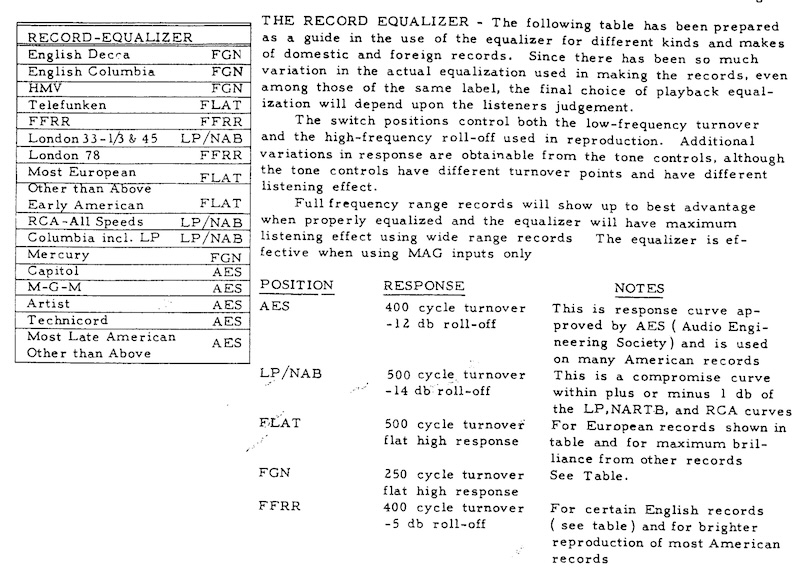
source: Bell Sound Systems Inc. Model 2200B Operation and Installation Manual (at AudioKarma Database).
つまり、Bell Sound 2200B には、“RCA” や “New Ortho” といったポジションは存在していません。
So it shows that the Bell Sound 2200B does not have such position as “RCA” or “New Ortho”.
17.7.2 Fisher 50-C Master Audio Control
同じ High Fidelity 1952年11/12月号 の p.15 には、Fisher Radio Corporation の Master Audio Control (C-50) の広告が掲載されています。
Page 15 from the same issue (High Fidelity, Nov./Dec. 1952) has the advertizement for Fisher Radio Corporation‘s Master Audio Control (C-50).
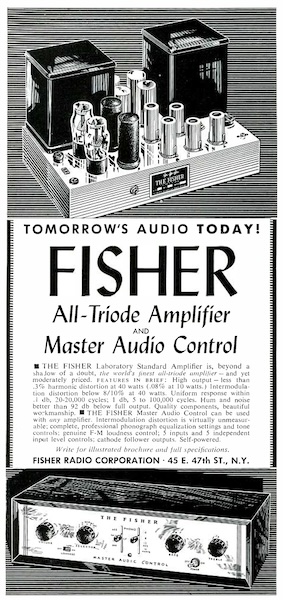
source: High Fidelity, Vol. 2, No. 3, November-December 1952, p.15.
Fisher Radio Corporation のアンプの広告
少し見えにくいのですが、本体中央にある2つのスライダが、ターンオーバーとロールオフを設定するセレクタです。
Two vertical sliders in the middle are the selectors for switching turnover frequency and roll-off value.

Fisher 50-C Master Audio Control Front Panel
マニュアルの回路図を見ると、各セレクタポジションが読み取れ、ターンオーバーは “AES” / “NARTB” / “LP” / “800” から、ロールオフは “0” / “8” / “12 AES” / “16 NARTB” から選べるようになっています。さきほどの Bell Sound 2200B 同様、ここでの “NARTB” は 1953年7月策定の NARTB のことではなく、1942年および1949年策定の NAB のことを指します。
C-50’s circuit diagram in the manual specifies each position of the selectors. Turnover can be selected from “AES” / “NARTB” / “LP” / “800”; Roll-off from “0” / “8” / “12 AES” / “16 NARTB”. As I already mentioned with the Bell Sound 2200B, “NARTB” here denotes 1942/1949 NAB Standards, not the NARTB Standards formulated in July 1953.
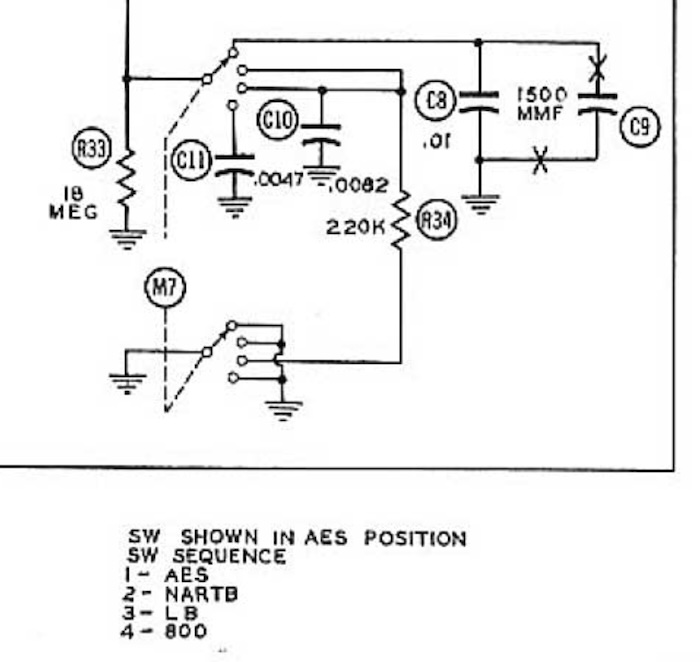
source: Fisher 50-C Master Audio Control Service Manual, from Audio Service Manuals.

source: Fisher 50-C Master Audio Control Service Manual, from Audio Service Manuals.
そしてやはりこの Fisher Master Audio Control にも、“RCA” や “New Ortho” に相当するポジションは、ターンオーバー側にもロールオフ側にも存在していません。
And again, there is no such position as “RCA” or “New Ortho” on this Fisher Master Audio Contorl.
17.7.3 Newcomb Classic 25
再び High Fidelity 1952年11/12月号 の p.20 には、Newcomb 社の Classic 25 を含む全ラインアップの広告が掲載されています。
Again in the Nov./Dec. 1952 of the High Fidelity magazine, this time on p.20, there is an ad for Newcomb‘s full lineup, including Classic 25 amplifier.
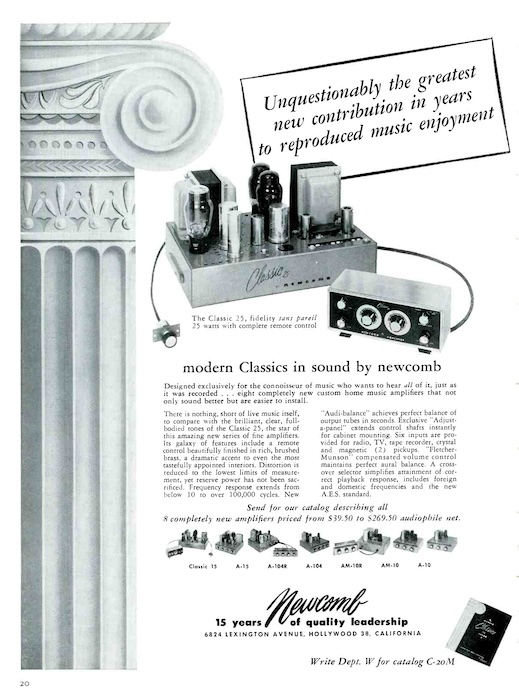
source: High Fidelity, Vol. 2, No. 3, November-December 1952, p.20.
Newcomb 社の当時の一連のアンプの広告
さて、同じ号には Newcomb Classic 25 のレビュー記事も掲載されており、その解説を読むと、本体正面右側にある大きなダイアルがEQカーブセレクタで、ポジションはマイクログルーヴ用に “AES” / “microgroove standard” (ターンオーバーは AES と同じだが、ロールオフはフラット) とあり、78回転盤用には “AES” / “standard 78” / “foreign 78” とあるようです。マイクログルーヴ用の “AES” ポジションと、78回転用の “AES” ポジションの違いは、ゲインの違いだけだそうです。
In the same issue, the “Tested in the Home” corner has the equipment review of the Newcomb Classic 25, which says: “The large hand knob is the recording characteristic equalization control”. Two microgroove positions are “AES” and “microgroove standard” (same turnover as “AES”, but the treble is flat). Three 78rpm positions consists of: “AES”, “standard 78” and “foreign 78”. The only difference between the microgroove’s “AES” and 78rpm’s “AES” is the volume level.
つまり、このアンプでは、当時出回っていた LP は 基本的に全て “AES” ポジションで聴かせようとしていた ことがわかります。
So, with this Newcomb Classic 25 amplifier, only the “AES” position was provided for the reproduction of microgroove records.
17.7.4 Marantz Audio Consolette (1951)
そして、1951年に登場、当初は100台のみが製造されたと言われている、かの有名な Marantz Audio Consolette です。どんなに1951年〜1953年当時の雑誌を調べてみても、広告もレビューも見つけることはできませんでした。ともあれ、当時としては画期的な、多彩なターンオーバー / ロールオフのポジションが目をひきます。
And here is the famous Marantz Audio Consolette, debuted in 1951, initially 100 units manufactured. I could not find any advertisements nor review articles on Audio Consolette in any 1951-1953 audio magazines. Anyway, it had versatile turnover / rolloff knobs which were groundbraking at that time.
まだ “RIAA” という表記が登場する前(すなわち1951年オリジナル)の、Audio Consolette のフロントパネル写真は、クリケットサウンドさんのページ で拝むことができます。それを参考にすると、選択可能なポジションは以下の通りです。New Orthophonic は 1952年8月以降ですので、“ORTHO” というポジションは、いわゆる Old Orthophonic (500N-12.7) を念頭にしていたはずです。また、「2000」と書かれていますが、セクション17.5.7のコラム でも触れた通り、後年の時定数に基づく厳密な表記(75μs: 2,122Hz)ではないと思われます。
Cricket Sound’s web page has photos of that very rare vintage 1951 Audio Consolette, without the “RIAA” notation. According to the front panel photo of that web page, the original 1951 Audio Consolette has the following positions. Please note that the position “ORTHO” would be for Old Orthophonic (500N-12.7), because the New Orthophonic was debuted in August 1952. Also, please note that the ORTHO’s value “2000” is not the same notation as the later value precisely with time constants (75μs: 2,122 HZ).
- BASS (TURNOVER FREQUENCY)
- FLAT
- 300 (FFRR)
- 400 (AES)
- 500 (LP / ORTHO)
- 500 (COL. LP
- 800
- TREBLE (ROLLOFF FREQUENCY?)
- FLAT
- 5000 – 3dB (FFRR 78)
- 2500 (AES)
- 2000 (ORTHO)
- 1590 (LP / NARTB)
- 1000 – 2.5dB (EARLY 78)
ただし、1951年〜1953年当時、Audio Consolette のように細かいポジションを多数備えたフォノEQは、まだ非常に珍しかったと推測されます。この Marantz Audio Consolette 同様に多彩なターンオーバー/ロールオフの選択が可能な McIntosh C-108 の登場は 1954年と言われています(C-104 の広告は High Fidelity 1952年11/12月号に掲載されていました)。
However, it is assumed that such units with versatile phono EQ positions were still very rare in the 1951-1953 period. The McIntosh C-108 preamplifier, which offered similar variety of turnover / rolloff selections as the Marantz Audio Consolette, is said to have appeared in 1954 (an ad of the C-104 appeared in the Nov/Dec. 1952 issue of High Fidelity).
17.7.5 Stromberg-Carlson AR-425
“Dialing Your Disks” 初回が掲載された High Fidelity 誌 1953年1/2月号 p.8 には、Stromberg-Carlson の AR-425 というアンプが掲載されています。
An ad of Stromberg-Carlson‘s AR-425 amplifier is on the page 8 in the Jan/Feb 1953 issue of High Fidelity (the first “Dialing Your Disks” was also published in this issue).
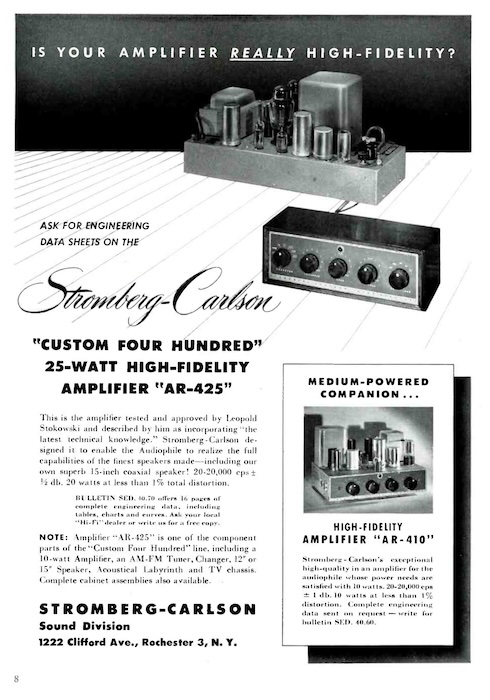
source: High Fidelity, Vol. 3, No. 1, January-February 1953, p.8.
Stromberg-Carlson AR-425 アンプの広告
こちらのアンプのフロントパネルは ハイファイ堂さんのページ で拝むことができますが、ポジションは “FFRR” / “FR” (Foreign) / “LP” / “AES” の4つとなっています。米国国内盤向けのポジションは “LP” (Columbia / NAB) および “AES” のみで、やはり “RCA” や “Ortho” はありません。
Hi-Fi-Do’s web page captures the AR-425’s front panel. EQ positions are: “FFRR” / “FR” (Foreign) / “LP” / “AES” — among these four, “LP” (Columbia / NAB) and “AES” are the positions for microgroove records manufactured in the US. Again, no “RCA” or “Ortho” position.
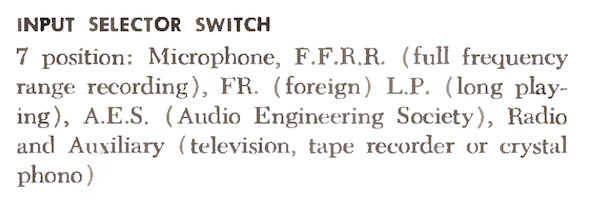
source: Stromberg-Carlson Brouche (1953), from Made in Rochester.
フォノEQ 4ポジションを含めた全7セレクタポジションの解説
17.7.6 Pickering 230H + 132E / Model 410
市販用というよりラジオ局などでの使用を念頭においた製品ではありますが、High Fidelity 1953年 5/6月号に、Pickering and Company Inc. のフォノプリアンプ 230H、およびフォノEQ補正装置 132E が掲載されています。
Although not for consumer market but for professional use (such as radio stations), the Pickering and Company Inc.‘s ads of the phono preamp 230H and the compensating module 132E are in the May/Jun 1953 issue of the High Fidelity magazine.
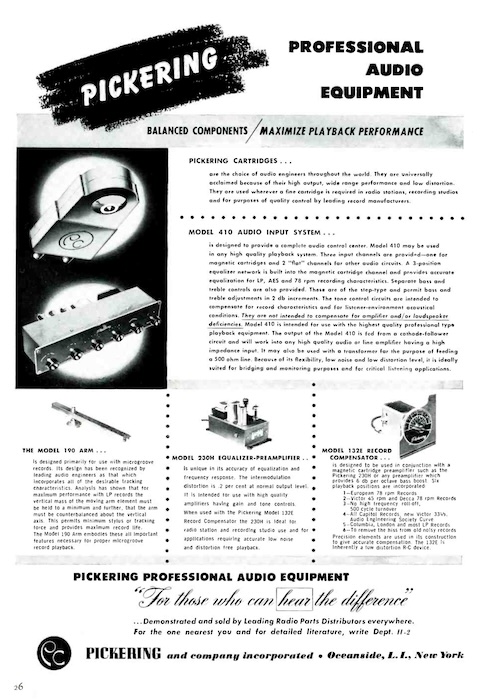
source: High Fidelity, Vol. 3, No. 3, May-June 1953, p. 26.
Pickering 190 + 230H + 132E の広告
Model 230H は、当時の Pickering 140 カートリッジを念頭においた完全フラット特性(ここでは 500N-FLAT)のフォノプリアンプで、その後段にパッシブEQとして 132E を接続する前提のようです。その 132E は 6ポジションが選べ、“EUROPEAN 78” / “VICTOR 33 45” / “MAX HIGHS – MAX BASS” / “CAPITOL 78 33 45 AES STD” / “COLUMBIA 33 ffrr 33” / “NOISY RECORDS” となっています。当時としては珍しく “VICTOR 33 45”、つまり当時の RCA Victor のカーブへの対応もあります。ただし、New Orthophonic 向けなのか Old Orthophonic 向けなのかは分かりません。
Pickering Model 230H is a phono preamplifier with completely flat characteristics (500N-FLAT here) designed for use with the Pickering 140 pickup, and seems to be intended to be connected to a 132E compensator as a passive EQ in its rear stage. The 132E has six positions: “EUROPEAN 78” / “VICTOR 33 45” / “MAX HIGHS – MAX BASS” / “CAPITOL 78 33 45 AES STD” / “COLUMBIA 33 ffrr 33” / “NOISY RECORDS”. So this 132E has a “VICTOR 33 45” position for RCA Victor’s records at that time, while it is not known whether this position is for Old Orthophonic or New Orthophonic.
いずれにせよ、製品の性格からして、一般市販用の製品ではなかった(せいぜいアマチュア好事家が買った程度だった)のでしょう。
In any case, given the nature of this product, it was probably not intended for general commercial use (or it was bought by audio hobbyists at best).
同ページ上には Pickering Model 410 コントロールセンター(プリアンプ)も載っており、そちらのポジションは “LP” / “AES” / “78rpm” の3つであると書かれています。
The same ad also features Pickering Model 410 Audio Control Center (preamplifier), with three equalization positions: “LP”, “AES” and “78rpm”.
17.7.7 H.H. Scott 120-A
同じく 1953年 5/6月号に、H. H. Scott, Inc. (Hermon Hosmer Scott) の 214-A システム (120-A プリアンプ + 220-A パワーアンプ) のレビューが掲載されています。
Also in the May/Jun 1953 issue, published is an review of the 214-A system (120-A preamp + 220-A power amp) by H. H. Scott, Inc. (Hermon Hosmer Scott).
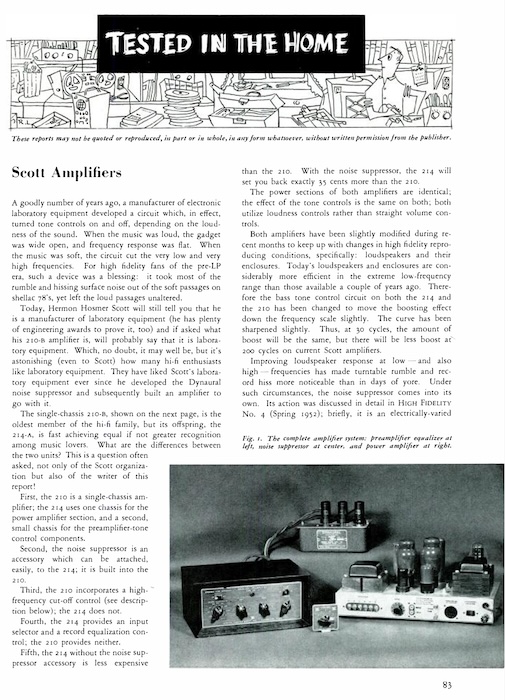
source: High Fidelity, Vol. 3, No. 3, May-June 1953, p. 83.
H.H. Scott 214-A のレビュー記事
フロントパネルには、78回転盤用として “EUR” / “LON” / “RCA” / “CAP” / “COL” が用意されていますが、LP や 45回転盤用としては “RCA” / “COL” / “LON” の3ポジションのみあります。今度は “AES” がないパターンで、かつ “RCA” があるパターンですが、この Scott 214-A システムは 1952年オーディオフェアで出品された というタイミングを考えると、“RCA” は Old Orthophonic を意図していると思われます。つまり本製品では “RCA” が実質的に “AES” 的な標準再生ポジション、ということになりそうです。
Front panel of the 120-A preamplifier has several phono EQ positions: “EUR” / “LON” / “RCA” / “CAP” / “COL” for 78 rpms; “RCA” / “COL” / “LON” for LPs and 45rpms. This time, “AES” position is not there, while “RCA” is. By the way, this Scott 214-A System was exhibited at the 1952 Audio Fair, so it is assumed that the “RCA” position was for Old Orthophonic. Also, on this unit, I guess the “RCA” position played a standard position for LP reproduction, like the “AES” position of other amplifiers at the time.
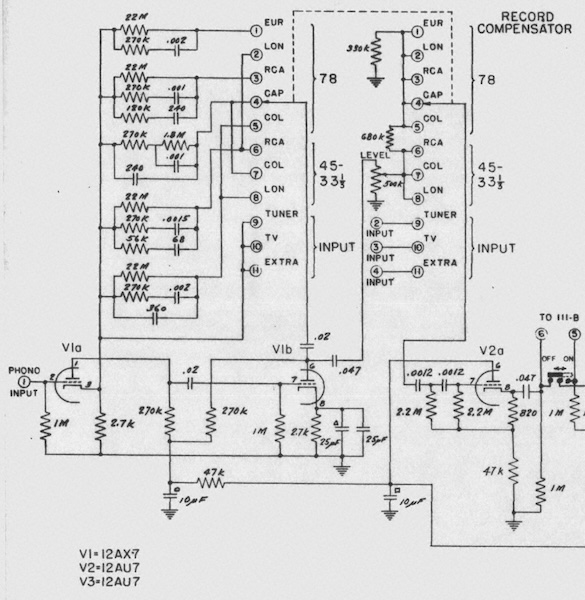
source: Vintage H.H. Scott Schmatic Library.
17.7.8 General Electric A1-900 Record Compensator
やはり1953年に発表された General Electric 社の A1-900 Record Compensator は、GE VR カートリッジ用のパッシブ可変補正装置で、1953年3/4月号 p.86 に紹介記事が載っているほか、1953年11/12月号 p.137 では広告を確認できます。この装置には “LP” / “AES” / “FLAT” / “Early 78 (Good)” / “Early 78 (Poor)” の 5ポジションがあります。
General Electric‘s A1-900 Record Compensator, also released in 1953, was an adjustable passive network for use with GE VR cartridges. The short article is in p.86 of Mar/Apr 1953 issue of High Fidelity magazine, and the advertisement is published in p.137 of Nov/Dec 1953 issue. This equipment has five EQ positions: “LP” / “AES” / “FLAT” / “Early 78 (Good)” / “Early 78 (Poor)”.
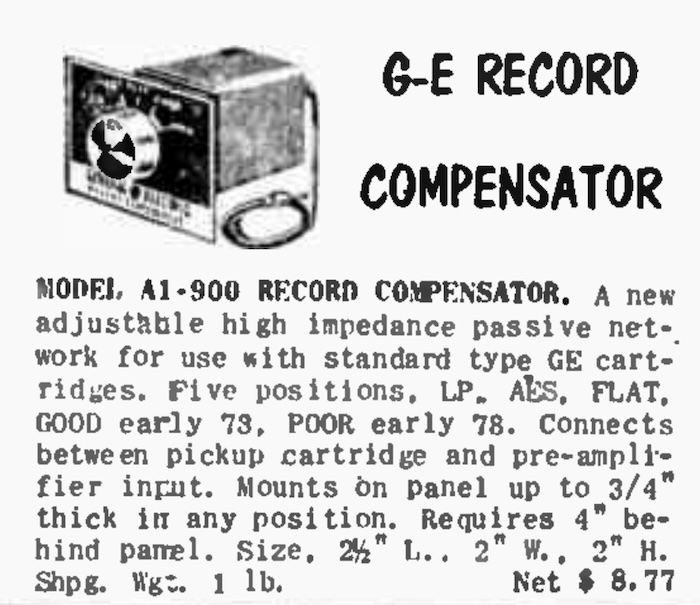
source: “Walter Ashe Catalog 1955”, p.25.
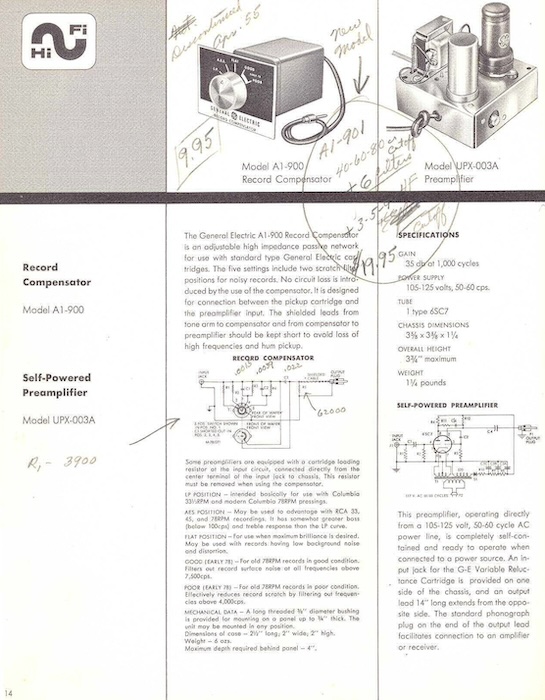
source: “GE High Fidelity Components, Oct. 1954”, p.14.
1954年10月発行のカタログより。プリアンプ UPX-003C と共に掲載
「1955年4月にディスコン、新モデルは A1-901」と書き込みあり。
A1-900 単体では高域プリエンファシス部分の補正のみを行い、低域のターンオーバー部分についてはプリアンプ(UPX-003C を想定)側で補正する、という仕組みのようです。上述の紹介記事でも “The A1-900 compensator, when used with a preamplifier having a runover frequency of 500 to 700 cycles, provides five degrees of ompensation” とあります。つまり、重低域部分については補正はしていないことになります。
A1-900 alone compensates high frequency pre-emphasis portion only, while the bass turnover portion is compensated by preamplifiers (supposing UPX-003C here). In the Mar/Apr 1953 article noted above, it reads: “The A1-900 compensator, when used with a preamplifier having a runover frequency of 500 to 700 cycles, provides five degrees of ompensation” — which means that this configuration does not compensate the low-bass region.
先日 ランブリングボーイズ さんが X (旧 Twitter) に投稿されていた当時のパンフレットによると、「AES 再生応答は、近年リリースされている全レコード用の折衷案的なレスポンスとして提案されたものである」「RCA の 33 / 45 / 78回転盤や、その他多くの近年の盤での使用が有効である」と書かれています。ここでも「RCA」や「New Ortho」といったポジションはなく、「AES」がその代用とされていることが確認できます。
According to the A1-900 brochure (the photos posted by @ramblinboys on X), it reads: “The AES (Audio Engineering Society) playback response has been proposed as a compromise response for all modern recordings.”, and “It may be used to advantage with RCA 33, 45, and 78 RPM recordings, and with many other recent recordings.”. So A1-900 did not have such positions as “RCA” and “New Ortho”: the “AES” position was recommended for reproducing RCA Victor records as well.
A1-900発売時のブローシュアー、、、 https://t.co/4QX6EPVXYr pic.twitter.com/u4bFALsPPs
— ランブリンボーイズ (@ramblinboys) September 24, 2023
17.7.9 Brook Model 22A
同じく1953年11/12月号の広告には、Brook 社のアンプ Model 22A の広告が掲載されています。
The same Nov/Dec 1953 issue has an advertisement for Brook‘s Model 22A amplifier.

source: High Fidelity, Vol. 3, No. 6, November-December 1953, p. 121.
Brook 22A アンプの広告
当該モデルが eBay に出品されて おり、そこでフロントパネルをじっくり眺めることができますが、1953年暮れ、つまり RIAA 規格策定の前で、さきほどの Pickering 132E 同様に RCA Victor 対応もあり、“New Orthopnonic RCA Victor” / “RCA Victor Orthophonic” (Old Orthophonic) といったポジションが確認できます。Capitol はちょうどこの頃 New Orthophonic 相当にスイッチしていましたが、まだ AES 側に表記されていますので、まさに RIAA 規格策定直前の様相です。
The model in question is listed on eBay, where we can take a closer look at the front panel. This model was made in late 1953 (just before the RIAA Standard was established), and like the Pickering 132E mentioned earlier, it also had positions like “New Orthophonic RCA Victor”, plus “RCA Victor Orthophonic” (Old Orthophonic). It is interesting to see that “Capitol” is labelled in the same category as “AES”, although Capitol already switched the recording characteristics to (the one which was equivalent to) New Orthophonic in the fall of 1953.
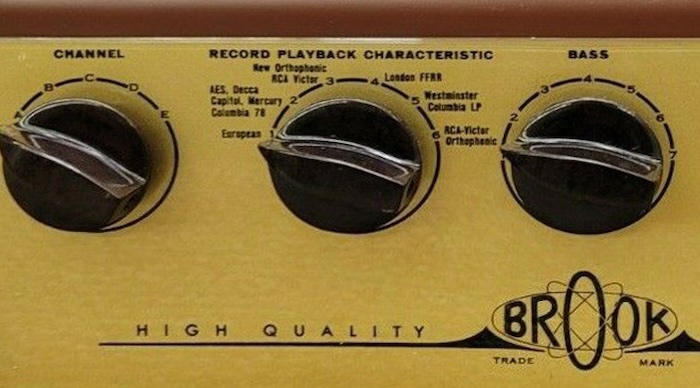
image from: eBay entry.
17.7.10 Some Thoughts (or Hypothesis)
1954年に入ると、カーブ名やレーベル名ではなく、多彩なターンオーバー周波数とロールオフ値を単極スイッチで選択可能な McIntosh C-108 が登場しますが、今回の Pt. 17 では RIAA 前夜までを対象にしているので割愛します。
Entering 1954, the McIntosh C-108 debuted, with a variety of turnover frequencies and roll-off values selectable with single-pole switches, rather than selecting the names of curves and labels. However, this Pt. 17 article covers up to the eve of the RIAA, so I omit its detail here.

source: McIntosh C108 Brochure, at manualslib.
それにしても、このように改めて1951年〜1953年のいろんなアンプを調べてみると、Marantz Audio Consolette は例外として、ほとんどのアンプが “Columbia LP / NAB” と “AES” の2ポジションを中心にして、その他のポジションを足していることが分かります。中には Newcomb Classic 25 のように、“AES” のみで “Columbia LP / NAB” すらなかった機種もありました。そして、1953年暮れまでは、RCA Victor 向けの “(Old) Orthophonic” / “New Orthophonic” に相当するポジションを持つ市販用アンプが少数派であったことが確認できました。
We have seen various amplifiers from 1951-1953 period. Almost all amplifiers (with the exception of the versatile Marantz Audio Consolette) only had “Columbia LP / NAB” and “AES” positions. There even was such an amplifier as Newcomb Classic 25, only with “AES” curve for microgroove records. So it is seen that few consumer amplifiers had “(Old) Orthophonic” and “New Orthophonic” positions, until the end of 1953.
また、アンプごとにその回路実装の方法がまちまちであり、同じEQポジション名であったとしても必ずしも同じ再生カーブになっている保証がなさそうなことも見えてきました。
It also became apparent that each amplifier has a different way of implementing its circuitry, and that even if the same EQ position name is used, it does not necessarily seem to guarantee the same playback curve.
つまり、これら当時のアンプのEQポジションからも、1950年代前半は RCA Victor は独自の録音再生規格で、Columbia LP カーブと AES 再生カーブが主流と捉えられてた、そんな風にみることができます。そしてこれがもしかしたら、セクション 17.6 でみたように、“Dialing Your Disks” において、Old Orthophonic / New Orthophonic カーブと思われるレーベルであっても、AES と表記されていることにつながっているのではないか、そんな風にも感じられます。
In other words, from the EQ positions of the amplifiers at that time, it can be seen that in the early 1950s, RCA Victor had its own recording / reproducing curve, and the Columbia LP curve and the AES playback curve were regarded as the mainstram. This may be the reason why some labels (that used highly possibly Old/New Orthophonic was used for mastering) were labelled as “AES” in the “Dialing Your Disks”, as we previosly have seen in the Section 17.6.
改めて “Dialing Your Disks” 開始当初の状況を考えると、High Fidelity 誌編集部が各レーベルに問い合わせ、レーベル側は「マスタリング時に使用した録音カーブ」を回答したのではなく、あくまで「うちのレーベルは、(マニア向けアンプとはいえ当時は選択肢がそんなに豊富ではなかった中から選んで)このセレクタで再生することを推奨します」と回答したにすぎなかった、ということではないでしょうか。
Again, High Fidelity magazine “asked all LP-makers listed in Schwann’s Catalogue to report what playback compensation their records required”, not “what recording characteristics used for mastering”. So each label just answered the recommended playback curve, not showing the recording characteristics actually used.
そんな中でも、当時のアンプにはそんなセレクタポジションはないのに、あえて技術者然と “500 / 13.7dB” と答えた RCA Victor、AES と答えてもよさそうなのにあえて “500 / AES” と回答した MGM、唯我独尊の “629 / 16dB” と回答した Peter Bartók 絡みのレーベル、これらマニアックなレーベルがあったことも興味深いです。
And it is very interesting to see some labels answered very technically and precisely, although there was no such position on the amplifiers at that time — “500 / 13.7dB” by RCA Victor, “500 / AES” by MGM, “629 / 16dB” by Peter Bartók-related labels.
17.8 The summary of what I got this time / 自分なりのまとめ
いつも長い記事になってしまいますが、今回は特に、前例をみない程にながい記事となってしまいました。読みにくくてすみません。ページネーションくらいした方が良かったですよね(笑)
Again, this Pt.17 became the extremely lengthy article — probably one of the longest (sorry for poor readability). I should have paginated this long page — but anyway here it is.
民生用レコードの録音再生特性が統一される直前までのさまざまな状況をみてきましたが、やはり、磁気テープ導入によりダイレクトカッティングによる録音ではなくなったこと、それに伴い、録音スタジオとマスタリング(カッティング)スタジオが必ずしも一緒とは限らなくなったこと、が、状況を複雑にしていることが確認できました。一方、当時のレコード、特にマトリクス情報から、多くの考えるヒントが得られることも分かりました。
I/we have looked at various situations up until just before the standardization of the recording / reproducing characteristics for consumer records. And I/we have confirmed that the situation had been complicated by the fact that direct cutting was no longer used with the introduction of magnetic tapes, and that the recording studios and mastering (cutting) studios were not necessarily located in the same venue. On the other hand, I/we learned that the records of the time, especially the matrix information on the dead-wax area, can give us plenty of useful information.
今回記した内容(特に「仮説」)が、本当に正解なのかどうかはまだ分かりません。しかし、ディスク録音の長い歴史を順に追ってきたこともあり、当時の状況について以前よりずっと整理し理解できたように思っています。
I am still not sure if what I have written here (especially my “hypothesis”) is really correct. However, having followed the long history of disc recordings in sequence, I feel that I have a much better understanding of the various situation at that time, than I did before.
さてさて、今回の内容をざっくりまとめると、こんな感じでしょうか。
…so, the rough summary of my understanding in this Pt.17 article would be something like this:
LPや45回転盤などマイクログルーヴ盤の登場直後は、ヴァイナル組成もプレス技術も発展途上であり、新品であってもスクラッチノイズが入るなど品質に問題があった。また、当初は78回転盤アルバム音源の盤起こしによるLPイシューがほとんどであった。
In very early years of microgroove records (LPs and 45 rpms), both vinyl resin composition and pressing technology were still developing; even new records had scratch noise. Also, almost all LPs of such early years were reissues and compilations of 78 rpm albums.
マイクログルーヴ盤登場時期と、スタジオへの磁気テープ装置導入が一気に進む時期が奇跡的に一致していたことから、スタジオにおける長時間レコード制作時の自由度が飛躍的に向上した。また、1950年代前半になると、Pultec EQP-1/1A に代表される汎用可変イコライザが一気に普及し、リミッタ、コンプレッサ、ローパスフィルタ、ハイパスフィルタ、エコーチェンバ、プレートリヴァーブと相まって、ディスク録音EQとは独立して自由に音作りができる環境が整っていった。
It was a coincidence that the advent of microgroove records and the diffusion of magnetic tape recorders came out almost simultaneously. Both contributed the freedom of making longer playing records. Also in the early 1950s, variable (program) equalizers like Pultec EQP-1/1A became instantly popular among the studios, as well as limiters, compressors, low-pass/high-pass filters, echo-chambers and plate reverb, all of which gave studio engineers the freedom of sound-making as they wished, independent from disc recording EQ curves.
ディスクマスタリング(カッティング)時に用いられる録音EQは、ほとんどのスタジオにおいては、当時は固定回路のパッシブLRC EQ が用いられるのが慣例だった(現在は固定回路のアクティブ RC EQ が主流)。可変イコライザをディスク録音 EQ として使用する例もごく一部認められるものの、例外的なものであったと考えられる。
そもそも、大手レーベルでは社内で規格や技術プラクティスが厳格に定められていたため、エンジニアの気まぐれで記録特性を変更することは許されなかった。また、ほとんどの独立系スタジオにおいては、コストの問題から固定ユニットによる単一記録特性が選択されていたと思われる。一方、Peter Bartók のように、2〜3種類の録音カーブをレーベルごとに意図的に使い分けてマスタリングしたと思われる例外的な事例も見受けられた。
Disc recording equalizers which were used for mastering (cutting) lacquers at that time were almost always fixed LRC passive EQ units in most studios, although there was a very rare exception of using variable equalizers as disc recording equalizers.
More importantly, major labels had strict in-house standardization and engineering practices: recording engineers of such labels could not alter the recording equalizer with his/her passing fancy. Also, for many independent studios, it was highly probably an economical factor of choosing a single recording characteristics with a fixed EQ unit. On the other hand, we see there was an exceptional case, such that Peter Bartók intentionally used several recording characteristics depending on the labels.
High Fidelity 誌に掲載された一連の “Dialing Your Disks” のデータは、掲載開始直後は「想定している再生カーブをレーベルに直接問い合わせて回答された」ものを掲載していたが、徐々にカテゴライズや情報が錯綜し、結果として後年の混乱の一翼を担うこととなった。一方、当時のさまざまなLPのマトリクス情報をつつきあわせると、「レーベルごとの特性」というよりは「マスタリングスタジオごとの特性」という傾向がつかめる。その上で最初期の “Dialing Your Disks” データを眺めると、ある種の一貫性を感じ取ることができる。
A series of data on The High Fidelity Magazine’s “Dialing Your Disks” initally consisted of the responses directly from the labels, “which reproducing characteristics each label intended to be used”. However, as the issue went by, there was a confusion of information and categoraization — as a result, “Dialing Your Disks” would strenghen the controversy in later years. On the other hand, by checking and comparing the dead-wax matrix information of actual records, it is clear that the used EQ depends on which mastering studio was used, rather than from whcih label the record was released. With this prerequisite in mind, we see some consistency among the early “Dialing Your Disks” data.
当時ハイファイブームに乗ってマニア向けに販売されていた可変EQ付アンプのセレクタをみてみると、1953年7月に放送局向けに策定された NARTB 録音再生規格、1954年1月に発行された改訂 AES 再生カーブ、1954年2月に発表された RIAA 標準録音再生規格、それら全てがまだ存在していなかった時期(〜1953年後半)では、RCA (Old/New Orthophonic) ポジションを備えたものはほとんどなく、NAB (≒ Columbia LP) と AES をメインとしていることが分かる。なかにはマイクログルーヴ盤向けには AES のみという機種もあった。
そして、同じカーブ名のポジションであっても、アンプごとに実装が異なるため、必ずしも同じ再生カーブではなかったことも分かった。
改めて、各レーベルが当時 High Fidelity 誌の “Dialing Your Disks” に回答した「想定カーブ」は、当時流通していたアンプのどのEQポジションでの再生を推奨するか、であり、特定の録音カーブの使用を回答したのではなかったと考えられる。
Early 1950s was also a beginning of “Hi-Fi” fad: some consumer amplifiers for audio fanatics had variable / selectable phono compensator (reproducing characteristic switcher). It is interesting to know that many of early amplifiers (before the publications of Jul. 1953 NARTB Standards, Jan. 1954 new AES Playback Standards and Feb. 1954 RIAA Characteristic) only had “NAB (≒ Columbia LP)” and “AES” positions: few had “RCA” (new/old Orthophonic) positions. On some amplifiers, there was only one switch for reproducing microgroove records — “AES” only.
It was also found that even positions with the same EQ curve name did not necesssarily have the same playback curve due to different implementations in different amplifiers.
Once again, the “assumed curves” that each label responded to High Fidelity magazine’s “Dialing Your Disks” at the time were the recommended playback at whatever EQ position(s) on the amplifiers in circulation at that time, not the use of specific recording curve(s).
次回は、ついに、1953年 NARTB 標準規格、1954年改定 AES 再生規格、1954年 RIAA 標準録音再生特性、の成立の歴史を追っていきます。
My next post will feature — finally! — the history of the establishment of the 1953 NARTB Standards, 1954 new AES Playback Standards, and 1954 RIAA Standard Recording and Reproducing Characteristic.
» 続き / Sequel: “Things I learned on Phono EQ curves, Pt.18” »

